restaurant hue
Posted on Last updated: February 25, 2021 By: Author JB Macatulad
Categories DESTINATIONS, FOOD GUIDES, VIETNAM
NOTICE: Some of the information on this website may have changed due to the current global situation. It”s important to check with the proper authorities for the latest travel guidelines and anything else that could affect your plans.
Đang xem: Restaurant hue
DISCLOSURE: Some of our articles may contain affiliate links or sponsorships (disclosed at the bottom). You can refer to our terms of use for more information.
I’ll never forget that first spoonful. It was explosive with flavor.
Bun bo hue wasn’t at the top of my list of dishes I was most excited to try in Hue, but it turned out to be my favorite in central Vietnam. The combination of its rich, deeply flavorful broth with the soft and gelatinous beef shank and thin rice vermicelli was like an umami bomb dressed up as a bowl of noodle soup.
Of all the places I visited on a recent trip to Vietnam, Hue was the city I was most looking forward to. We skipped it two years ago and we’ve been regretting it ever since, after hearing about interesting and delicious-sounding regional dishes like banh hue, com hen, and banh khoai. On paper, Hue sounded like one of the most fascinating and unique food cities in the country.
I only had a month to divvy up between multiple cities in Vietnam but I was happy to allocate almost a week to Hue, so I’d have enough time to really sink my teeth into its plethora of regional dishes and dining experiences.
This is what I found.
Save This on Pinterest!
No time to read this now? Click on the red save button and pin it for later!
WHERE TO EAT IN HUE
1. Bun Bo Hanh
If you were to have just one dish in Hue, then it should probably be bun bo. It’s a popular noodle soup made with rice vermicelli, thin slices of beef, and hefty chunks of beef shank.
The broth is prepared by simmering pork and beef bones with lemongrass, then seasoning it with fermented shrimp paste, annatto, sugar, and chili oil. Based on those ingredients, you can already tell how flavorful this broth is going to be. It’s then typically garnished with chopped green onion, slivers of raw onion, and cilantro. Outside of the city, it’s referred to as “bun bo hue” to designate its origin, but in Hue, many refer to it simply as “bun bo”.
I had it twice in the city, the first time at this stall in the same alley as my hotel. Both places were recommended to me by the hotel’s owner so I knew they were going to be good.
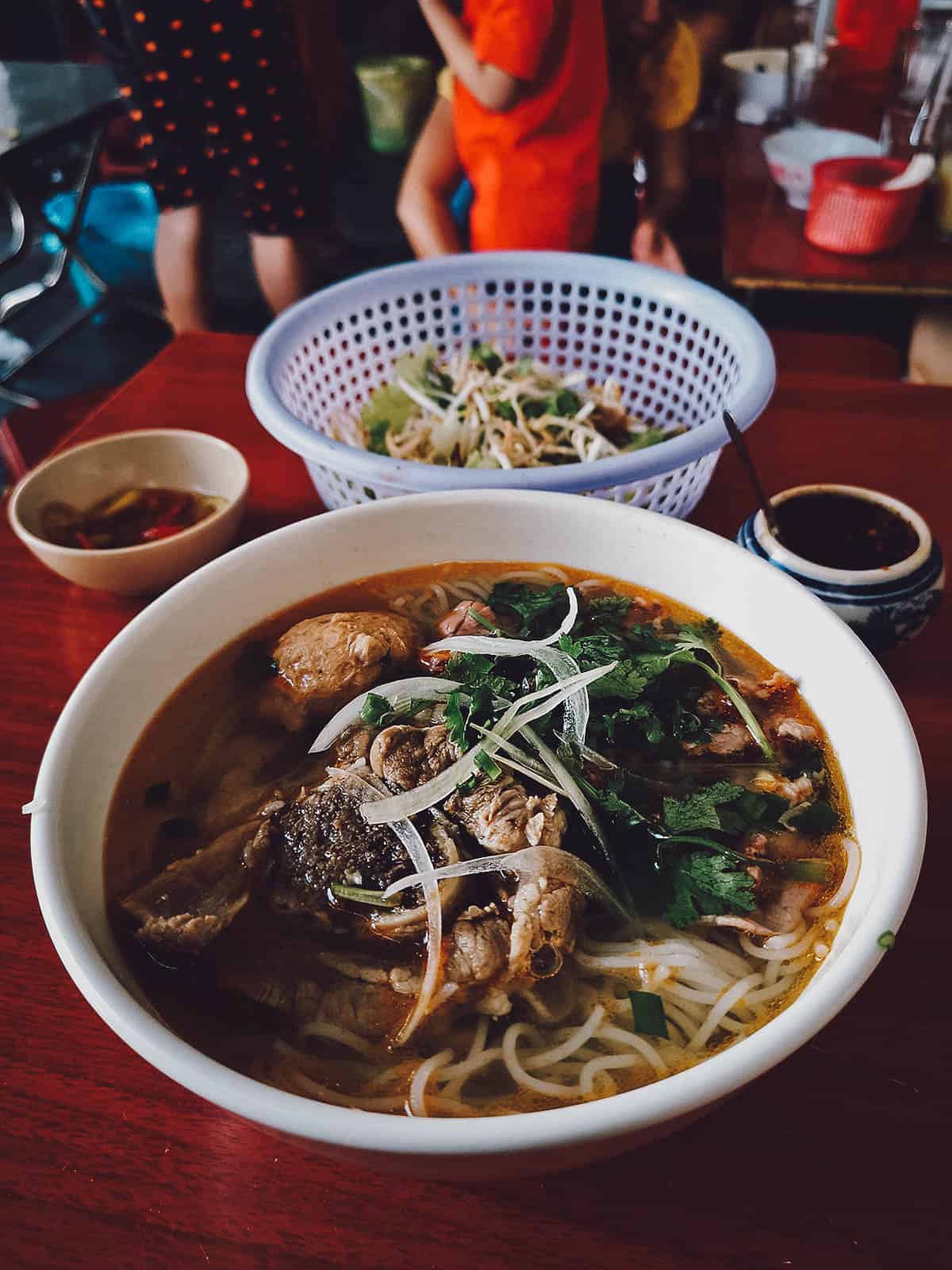
Bun bo hue is a noodle soup dish made with thick rice vermicelli, thin slices of beef brisket, and boiled beef shank. I’ve read that some places can serve it with other ingredients as well like oxtail, pig’s knuckle, crab balls, and congealed pig’s blood. This bowl didn’t seem to have any of that, which was fine by me because it was absolutely perfect the way it was.
Like many Vietnamese noodle soup dishes, it was served with a basket of fresh greens like mint, perilla, fish wort, banana blossom, and bean sprouts which you generously heap into your bowl. They’ll also provide a few lime wedges for acidity and chopped chili in nuoc cham (Vietnamese dipping sauce) for some heat.
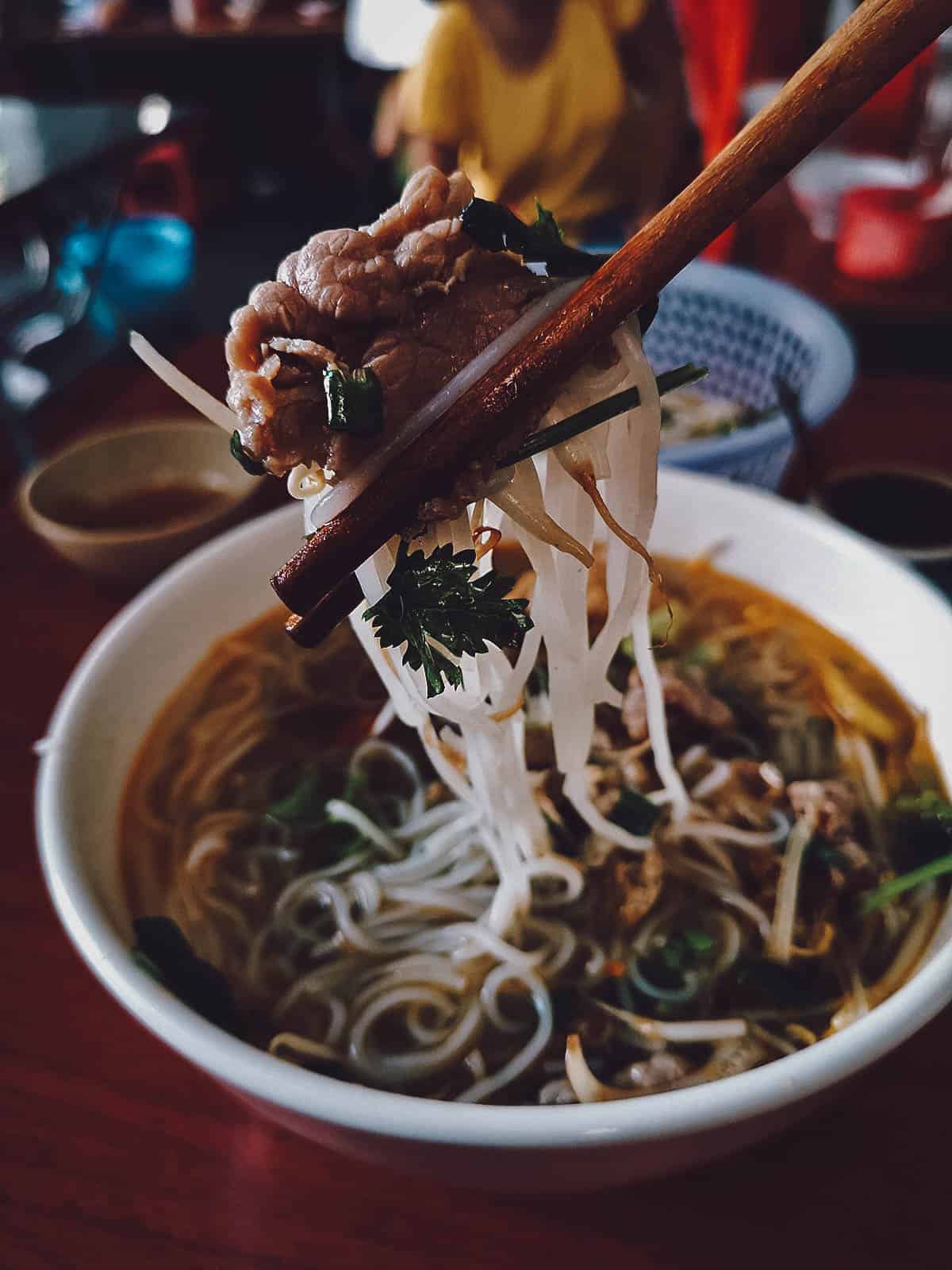
How comforting to know that every bowl of bun bo hue contains these hefty chunks of beef shank. The slices of brisket are great but these chunks of boiled beef shank are killer. They’re super tender with delicious bits of soft and chewy tendon.
This bowl of bun bo at this humble stall in an alley could very well have been the best thing I ate in Hue. It was so good I finished it to the last drop.
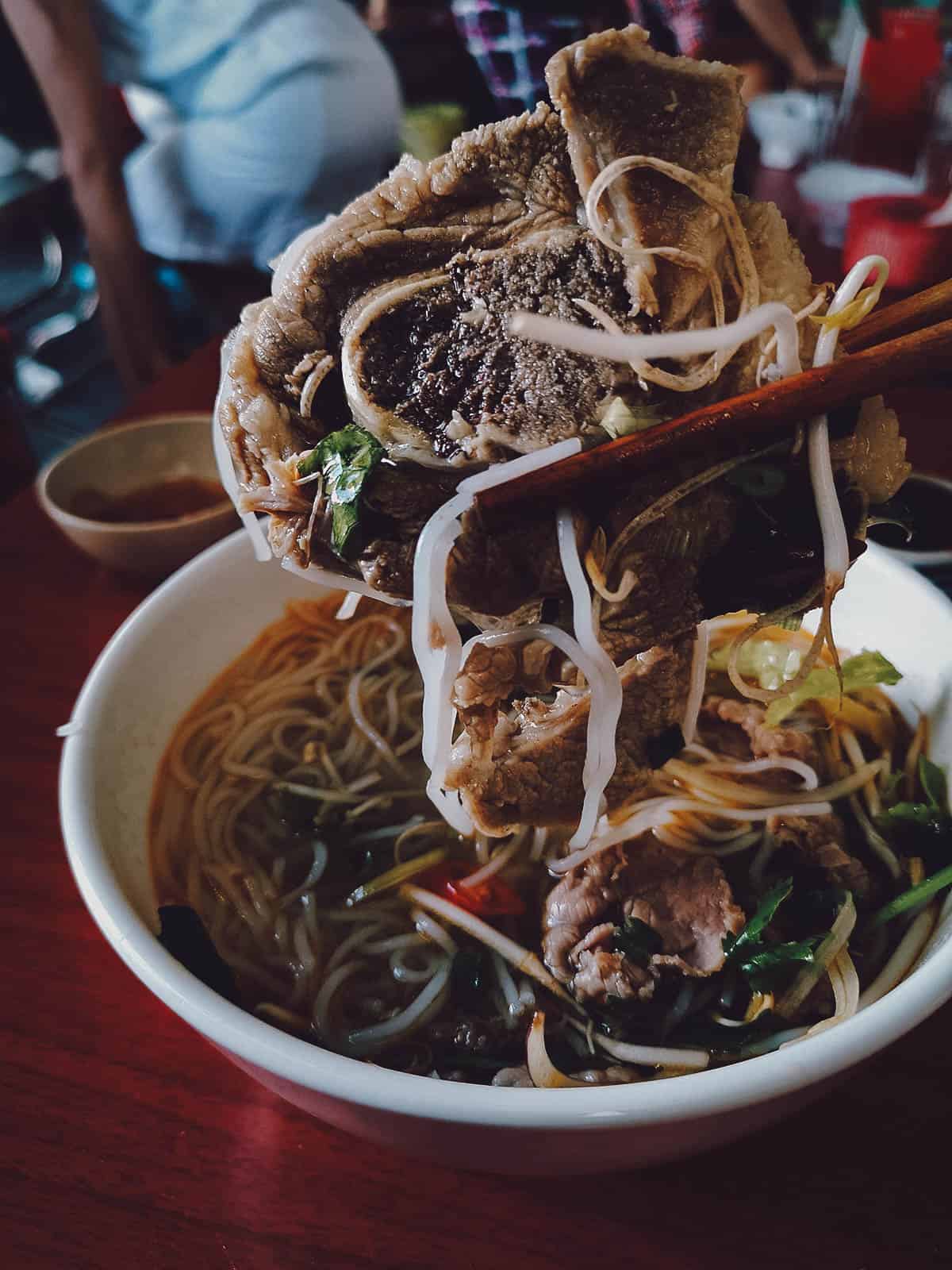
This is one of those eateries that’s so local it doesn’t show up on Google. Based on how the Vietnamese name their restaurants, I believe it’s called “Bun Bo Hanh” or simply “Hanh”. I’m not really sure but you can refer to the picture below to find it. It’s located at Kiet 56, Nguyen Cong Tru alley, near the corner of Nguyen Thai Hoc.
They’re only open in the morning so be sure to come early before the food runs out.
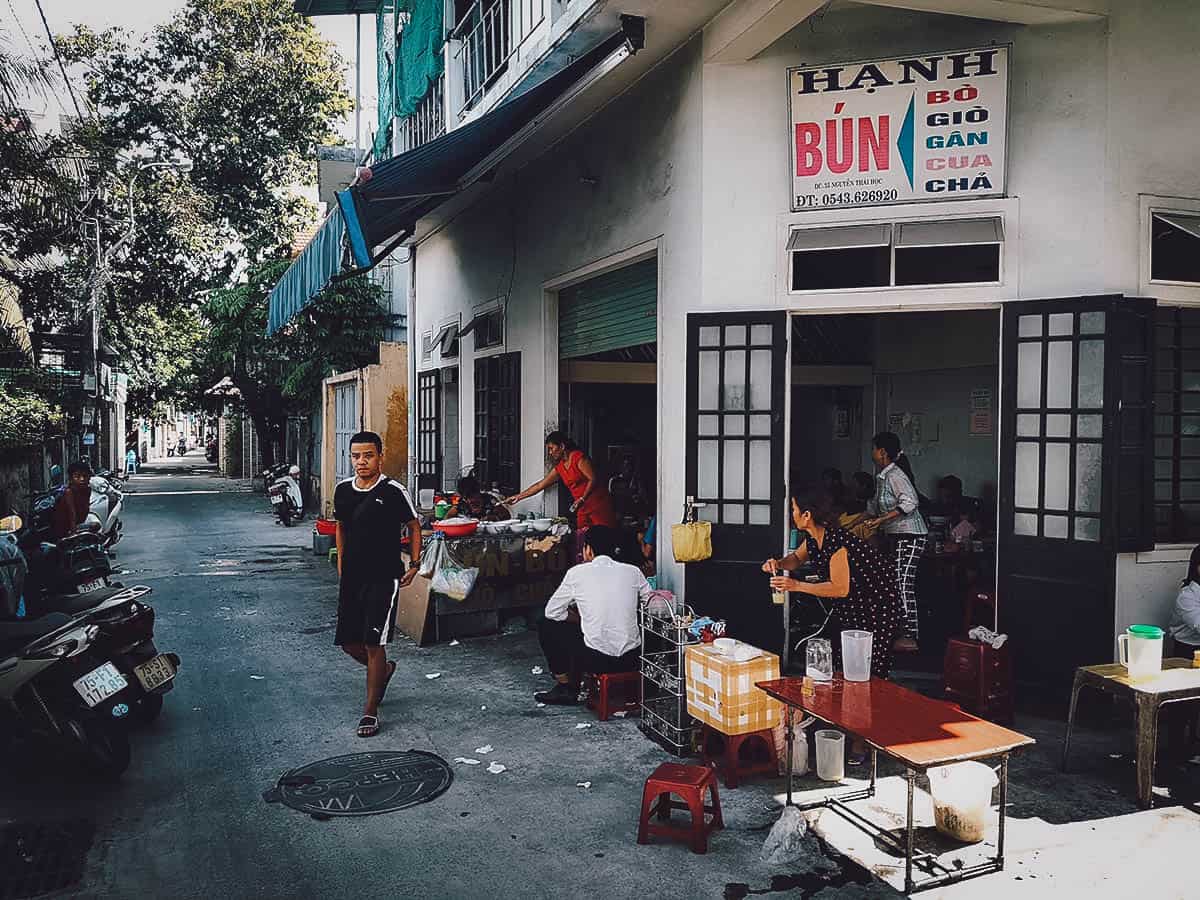
Bun Bo Hue Hanh
Address: Kiet 56, Nguyen Cong Tru (near the corner of Nguyen Thai Hoc)
Operating Hours: Morning only, until the food runs out
What to Order: Bun bo
Expect to Pay: VND 30,000 per bowl
2. Bun Bo Hue My Tam
Hanh was packed with locals having breakfast before work, but My Tam seems to be popular with both locals and tourists alike. My hotel’s owner seemed to prefer this place but I actually enjoyed Hanh more. Both are terrific so I suggest trying both. You’ll probably want to anyway after getting a spoonful of that supremely tasty bun bo broth.
Comparing both broths, you’ll notice that this one is a lot more orange. You can see the globules of chili oil sitting on top so if you like spicy food, then you’re going to enjoy the heat in this one.
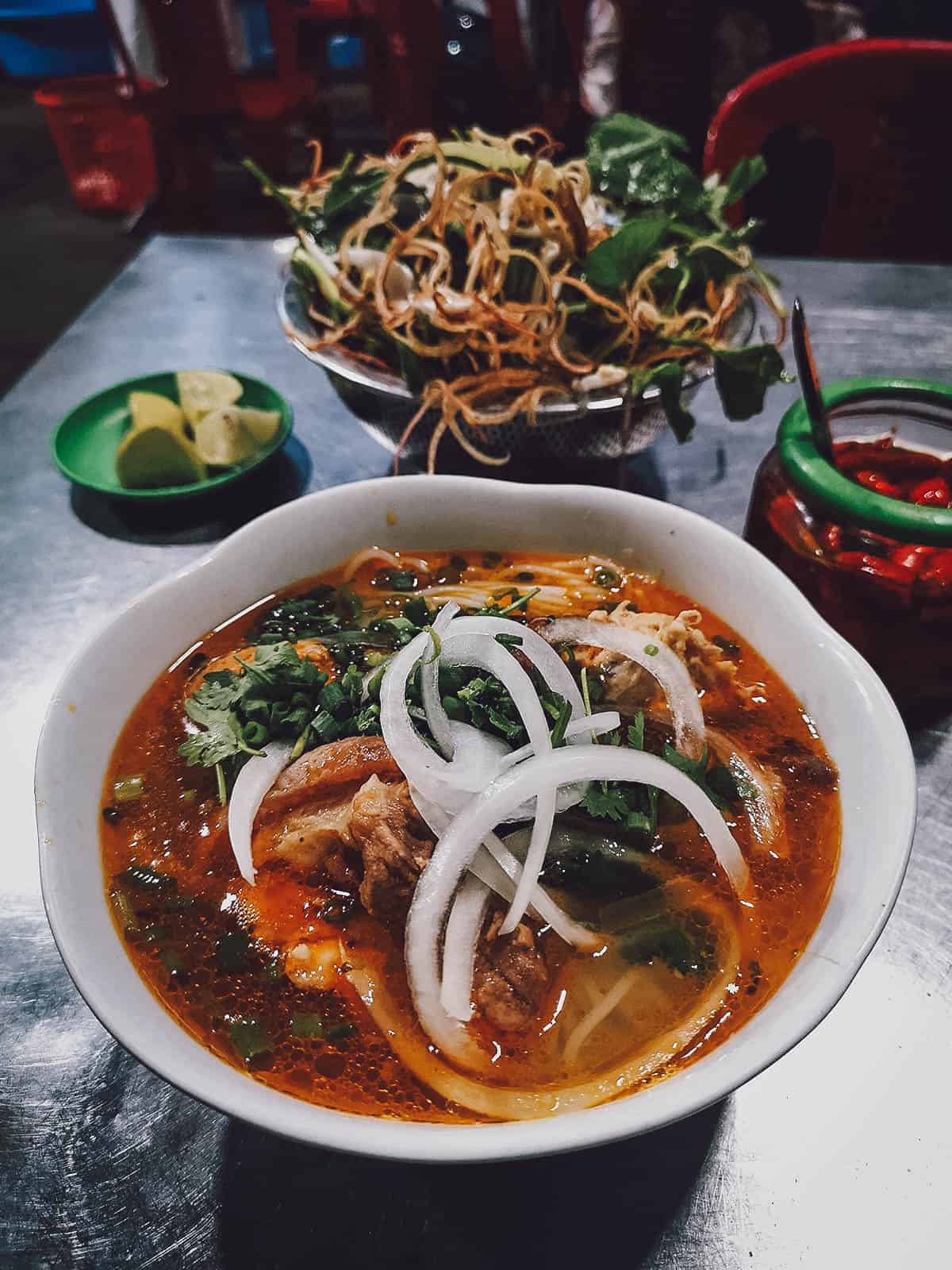
I love spicy food so I loaded mine with more chili and lots of fresh greens to balance out the oiliness of the broth. I was sweating bullets the entire time I was eating this!
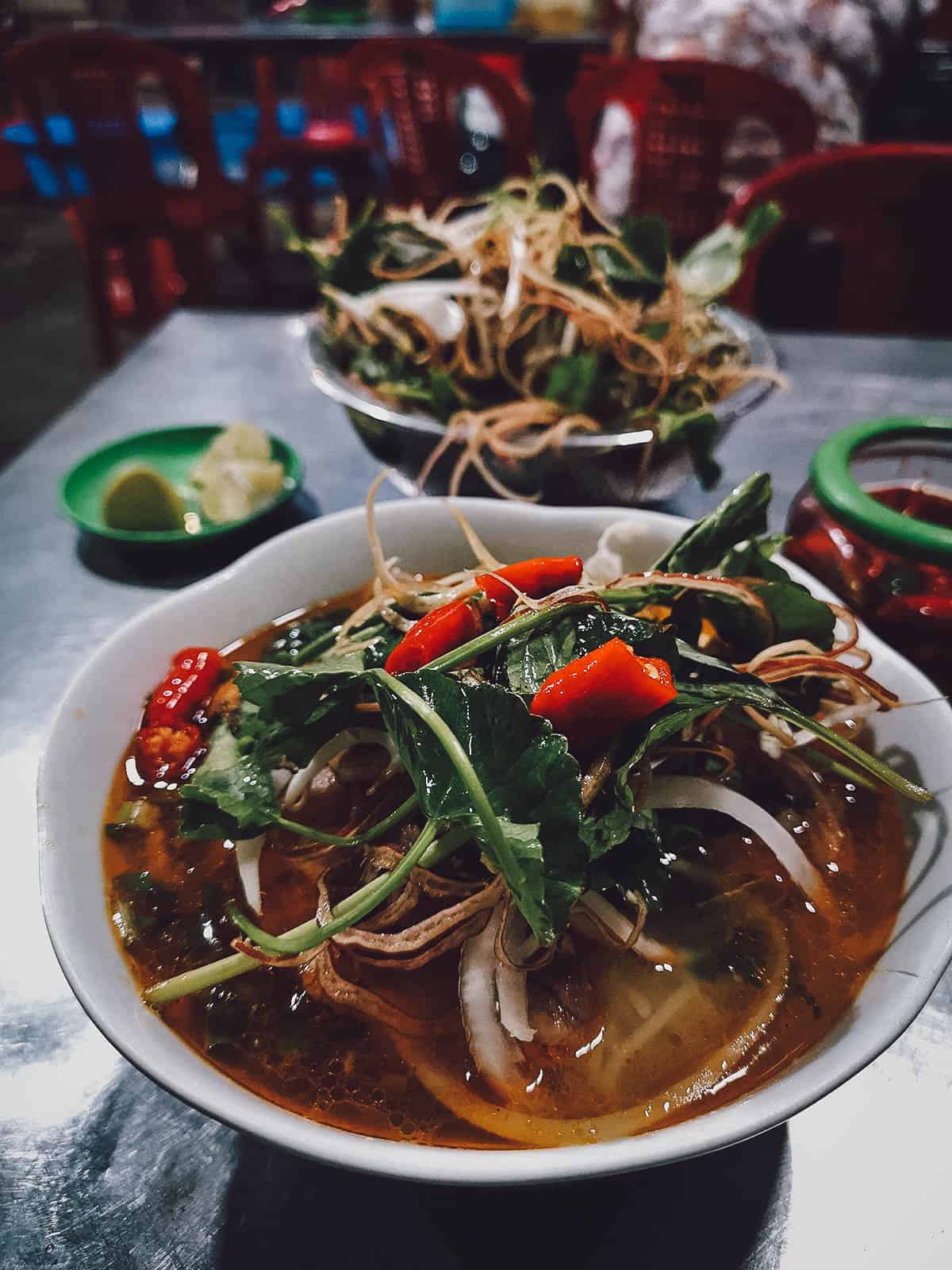
You don’t have to dig too far to unearth that delicious chunk of beef shank. It practically takes up half the bowl! You can see a thick layer of soft and gelatinous skin on this one. I can almost imagine it’s texture in my mouth from just looking at this picture. So good!
I loved the spiciness in this bun bo but flavor-wise, I may have preferred Hanh’s version more. It just tasted more balanced to me.
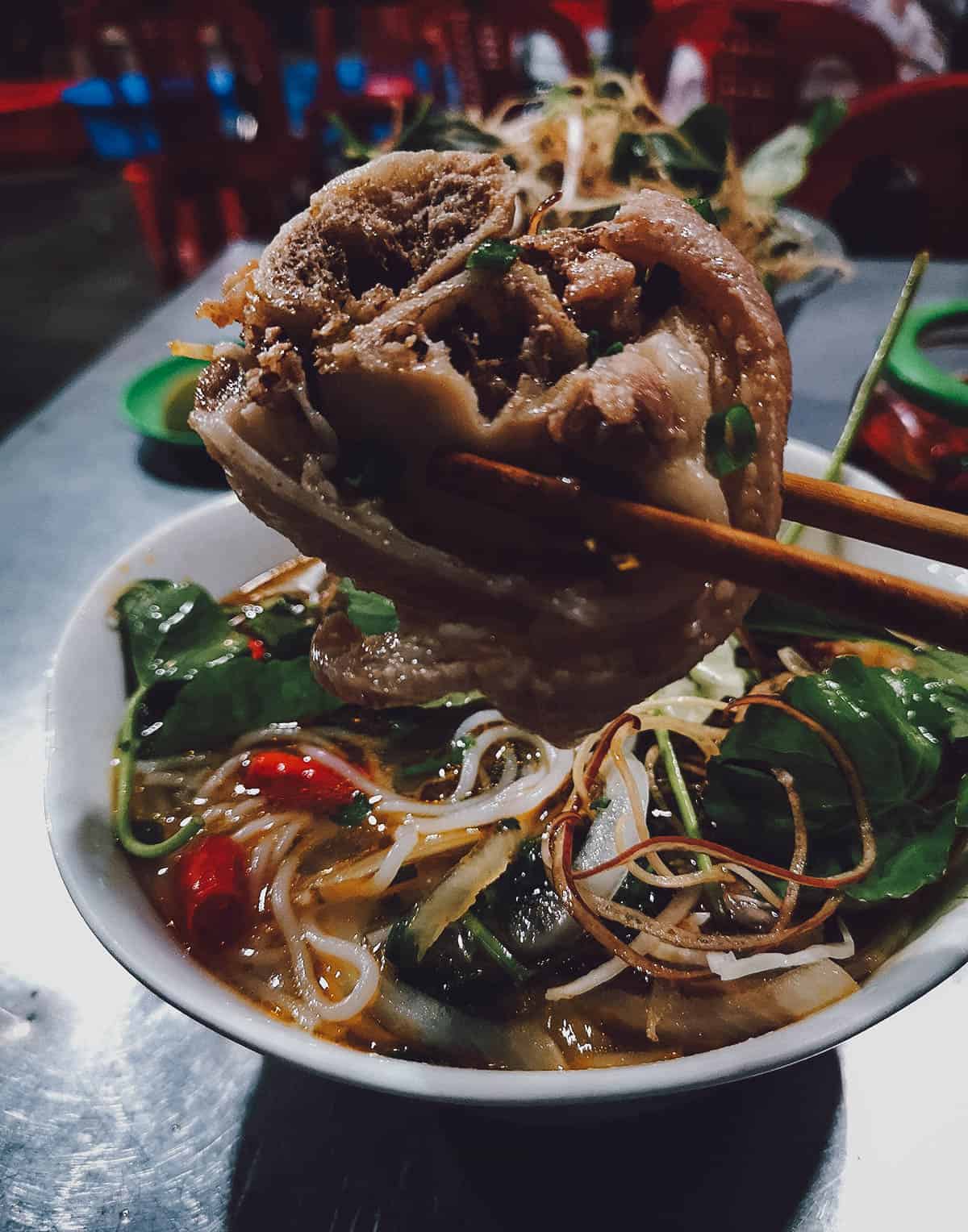
My hotel’s owner told me that foreigners sometimes complain about the pricing at My Tam. It’s inconsistent so many think they’re being overcharged.
The truth is, bun bo prices at My Tam can sometimes vary depending on what they put inside your bowl. Depending on what’s available that day, they can sometimes add other ingredients like beef tendon, pork knuckle, meatballs, and other good stuff hence the fluctuations in pricing.
So if you get a slightly higher-priced bowl of bun bo, then just sift through all the extra goodies swimming in your broth and say thank you.
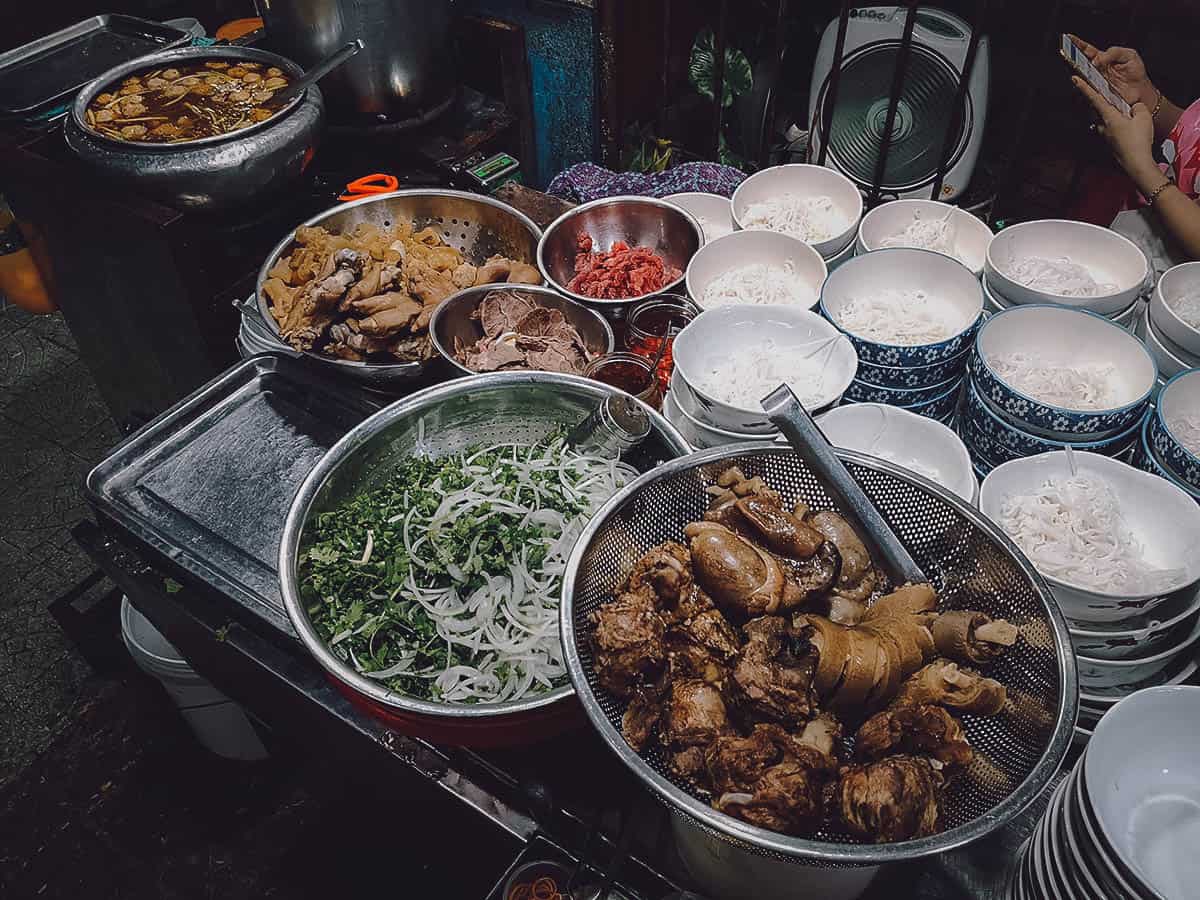
As described, Bun Bo Hue My Tam is only open from 5PM onwards. I’m not exactly sure when they close but based on similar places, I believe it’s when they run out of food so come early.
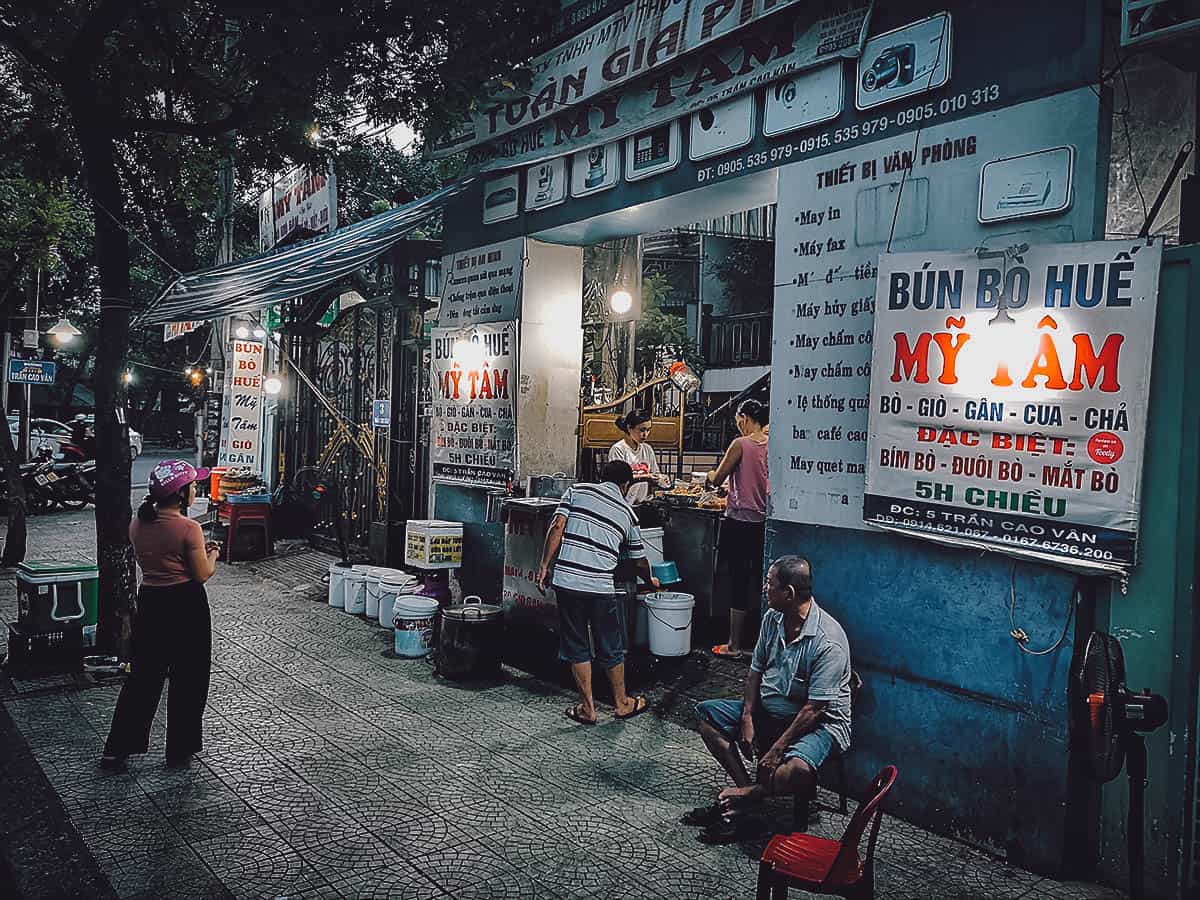
Bun Bo Hue My Tam
Address: 5 Trần Cao Vân, Vĩnh Ninh, Thành phố Huế, Thừa Thiên Huế, Vietnam
Operating Hours: 5PM onwards, until the food runs out
What to Order: Bun bo
Expect to Pay: Around VND 40,000 per bowl (varies depending on the ingredients)
3. Com Hen Ba Cam
Com hen or bun hen was another regional dish I was excited to try in Hue. It’s a signature dish made with either rice (com) or noodles (bun) topped with stir-fried baby basket clams, vegetables, and a plethora of other ingredients like fermented shrimp paste, fish sauce, herbs, chopped fruit, pork crackling, banana flower, and roasted peanuts. Toppings may vary from place to place.
Bun bo and bun hen were far and away my two favorite dishes in Hue.
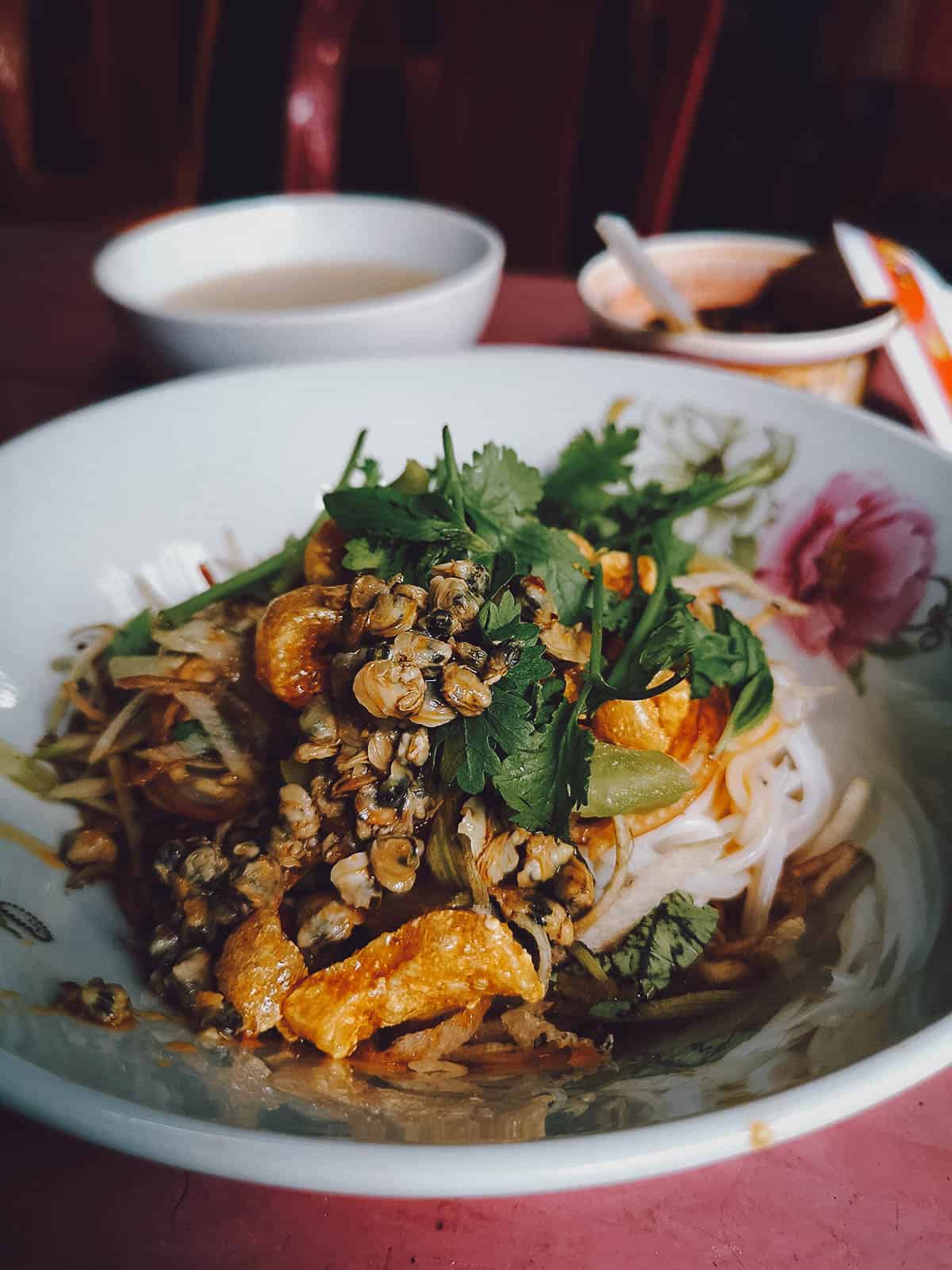
Pictured below is bun hen which is the variation made with noodles, but com hen is the original version of this dish. It was typically made with leftover rice which is why the rice in com hen today is still served at room temperature.
Personally, I preferred bun hen because I enjoyed the texture of the noodles more. For me, the noodles paired better with the baby clams than the rice. It’s an interesting medley of flavors and textures that gives you sweet, salty, spicy, briny, and sour to go with the crunchiness of the cracklings.
I enjoyed this dish so much that I had com hen or bun hen four times in Hue, and every bowl was served with a side of clam broth. Servings are typically small so it makes for a great cheap snack. Just VND 10,000 per bowl! (less than 50 US cents)
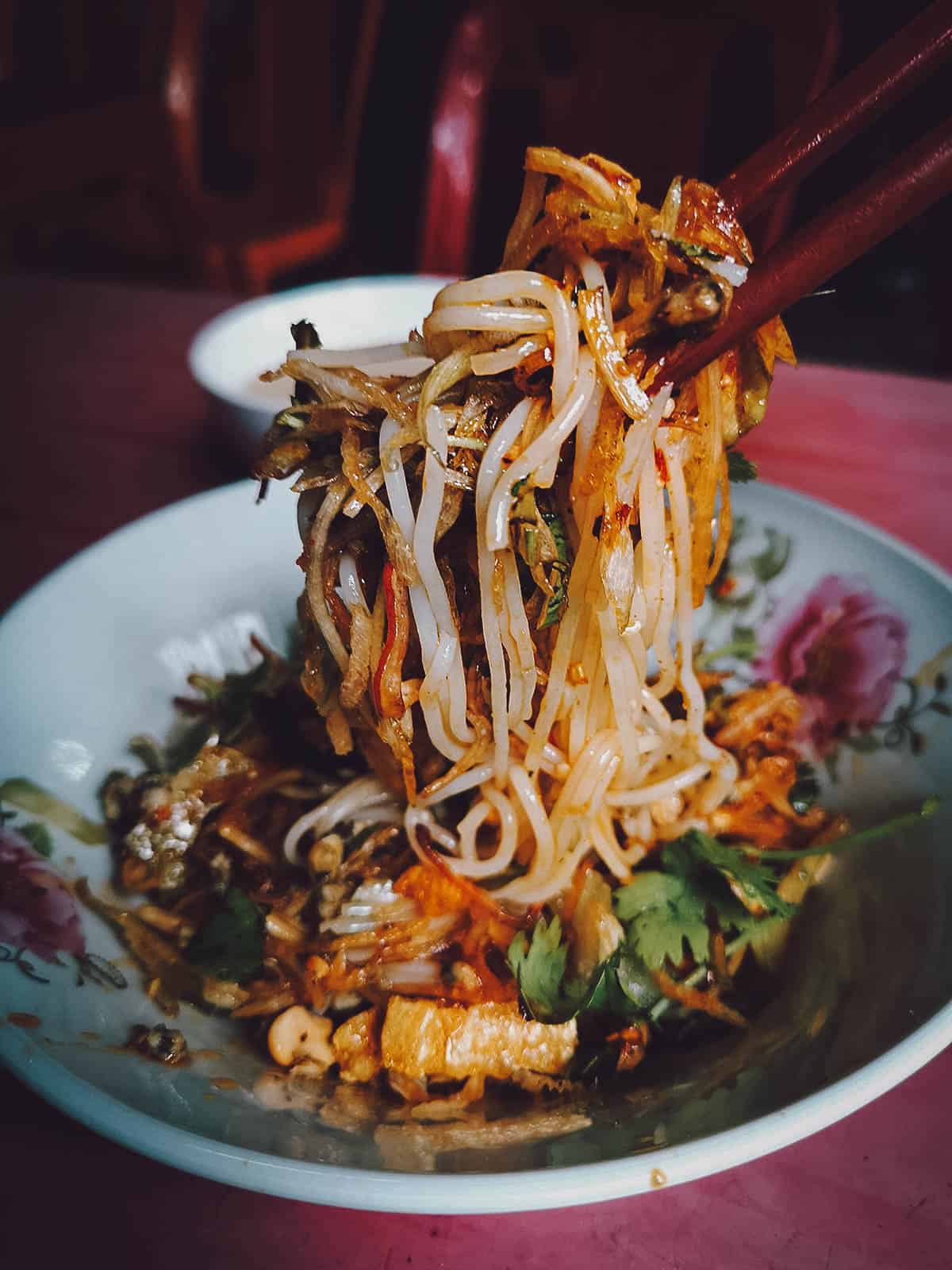
As described, Com Hen Ba Cam was one of four eateries I visited to have com hen or bun hen. It was good but it wasn’t my favorite.
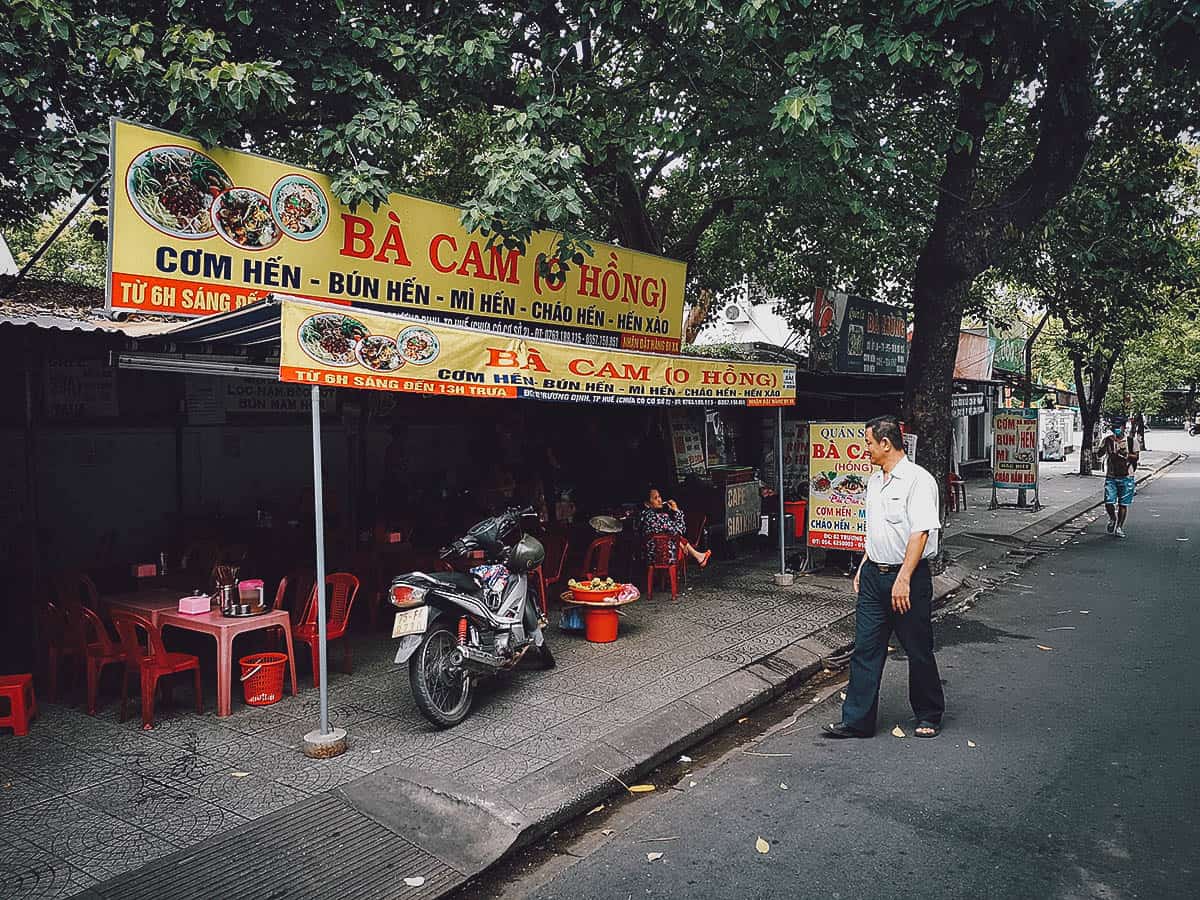
Com Hen Ba Cam
Address: 2 Trương Định, Vĩnh Ninh, Thành phố Huế, Thừa Thiên Huế, Vietnam
Operating Hours: 6AM-1:30PM, daily
What to Order: Com hen, bun hen
Expect to Pay: VND 10,000 per bowl
4. Ba Hoa
With the exception of Com Hen Hoa Dong, all the com hen or bun hen I had in Hue tasted pretty much the same. It’s a simple dish so I think a lot of it hinges on the freshness of the clams.
Ba Hoa’s bun hen differed from Ba Cam’s version in that it contained a few different ingredients like bean sprouts and roasted peanuts. The peanuts were nice because they added nuttiness and a different type of crunch to the dish.
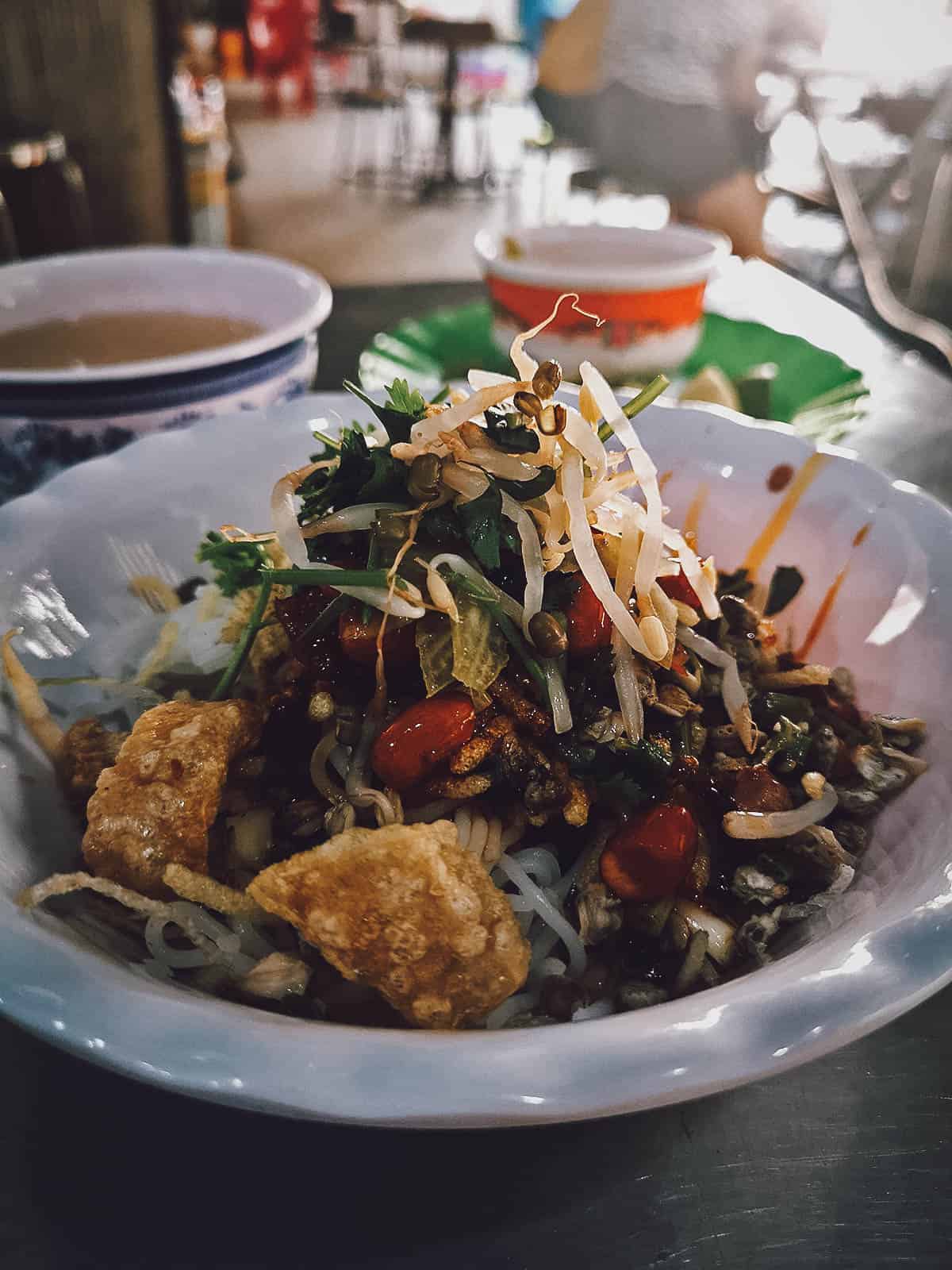
Ba Hoa’s bun hen was comparable to Ba Cam’s, though I may have preferred this one a bit more because of the roasted peanuts. They added another dimension to the dish.
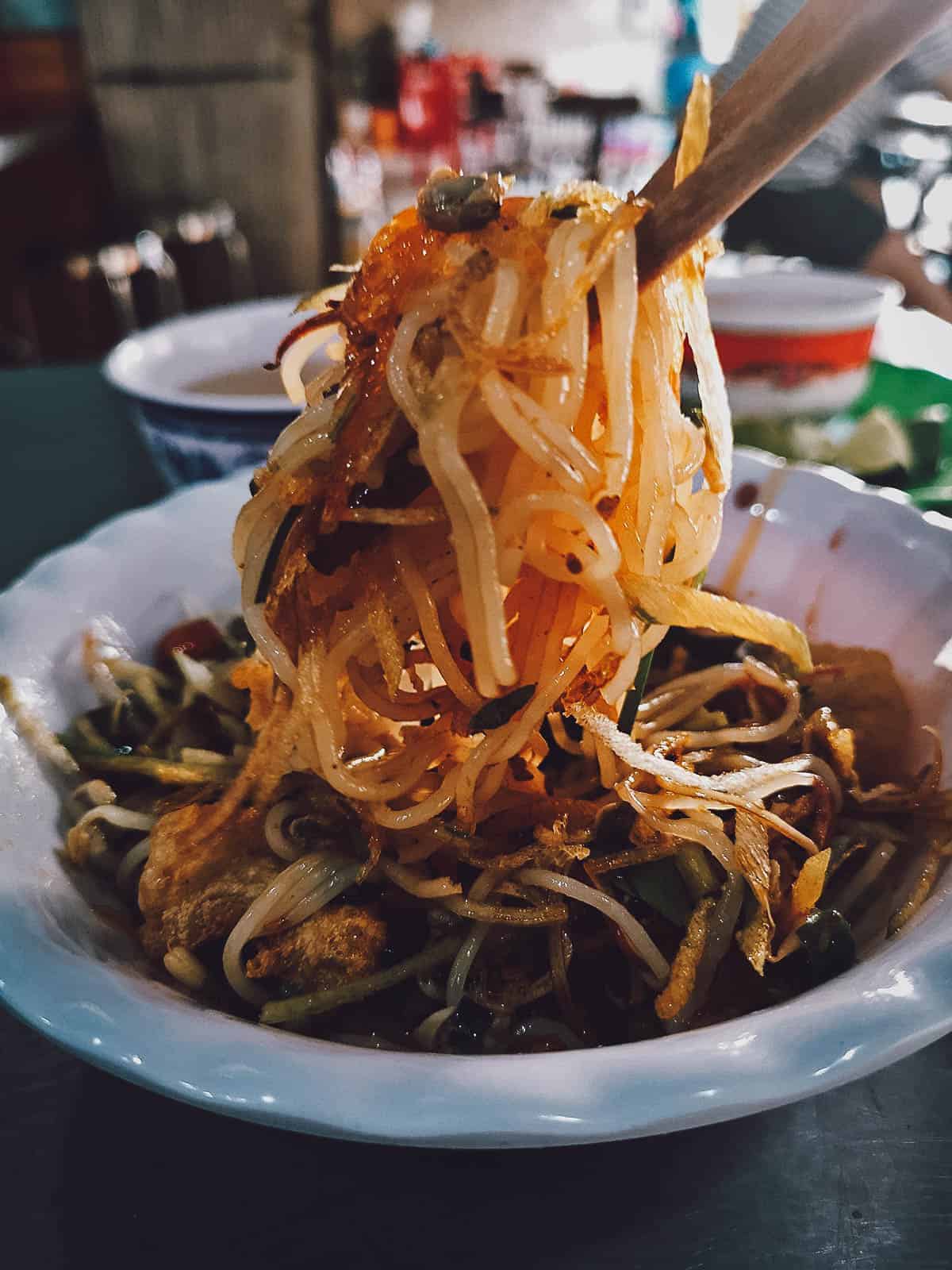
Here’s a closer look at the young basket clams used in bun hen.
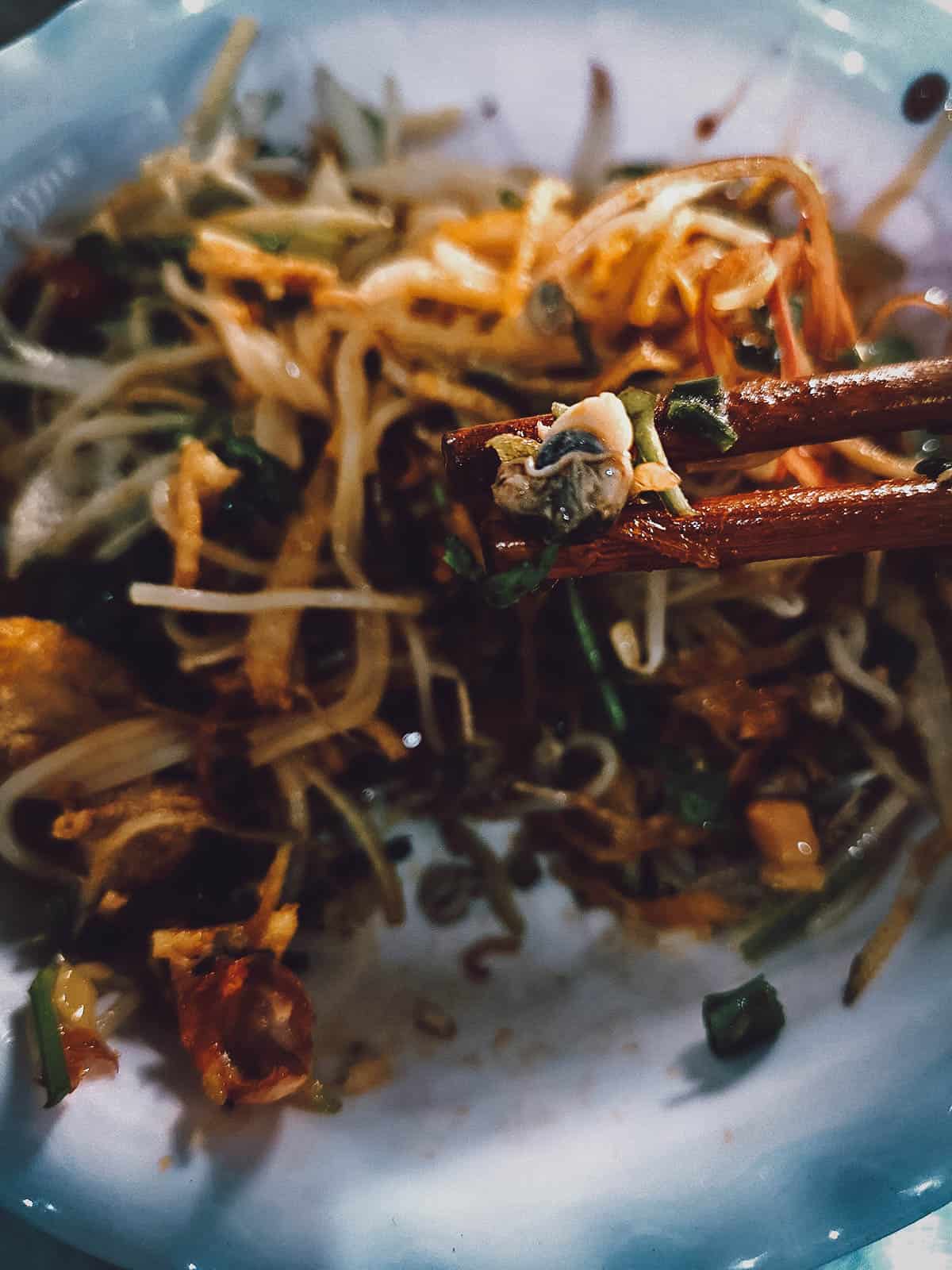
Ba Hoa is about a two minute walk from Ba Cam on the same street. As advised, servings are small so you can easily eat at both one after the other.
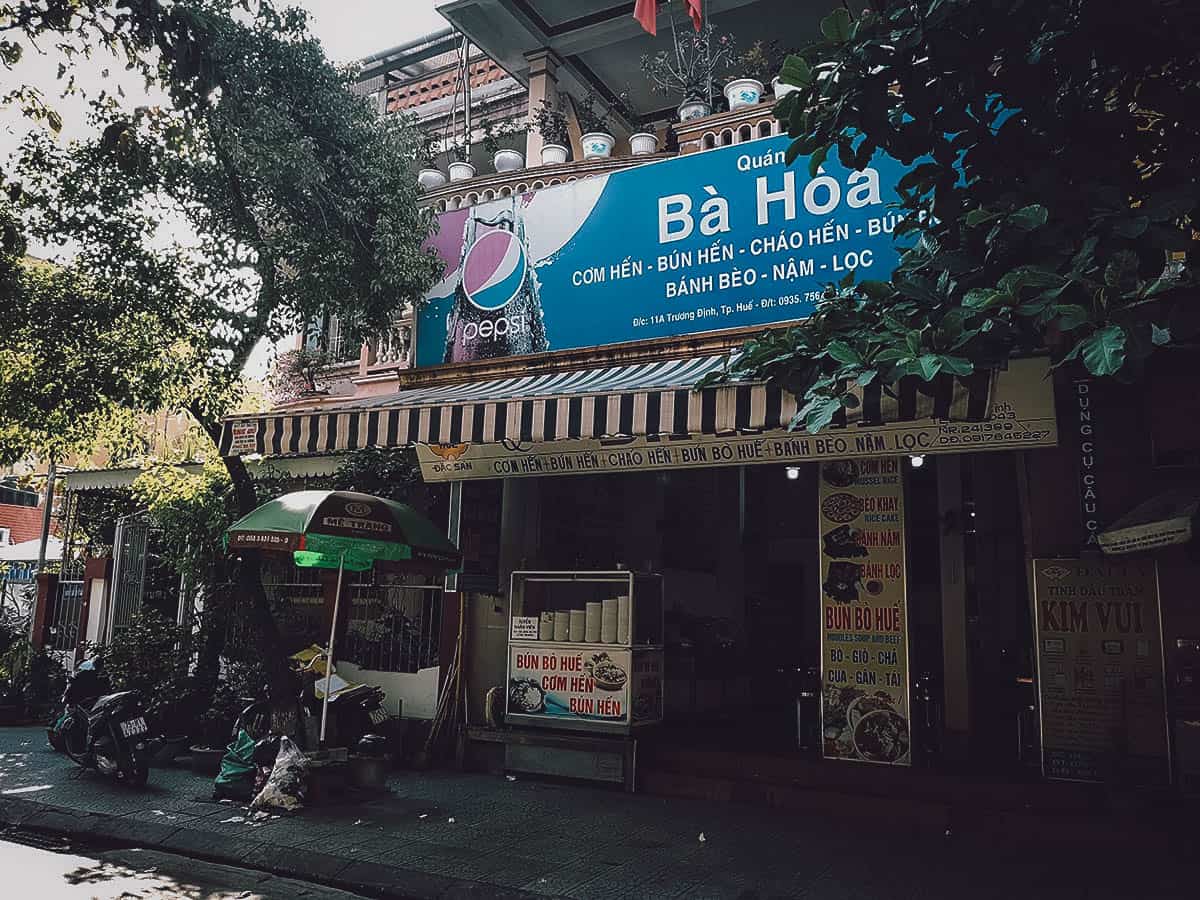
Ba Hoa
Address: 11 Trương Định, Vĩnh Ninh, Thành phố Huế, Thừa Thiên Huế, Vietnam
Operating Hours: 6AM-8PM, daily
What to Order: Com hen, bun hen
Expect to Pay: VND 20,000 per bowl
5. Com Hen 17
I asked the owner of my hotel for com hen recommendations and he pointed me to this place across the Nhu Y River. It was the only time I had the version made with rice. It was tasty but I couldn’t get past the fact that I wish I had ordered bun hen instead. The soft silky noodles made for better textural variety I thought than the rice.
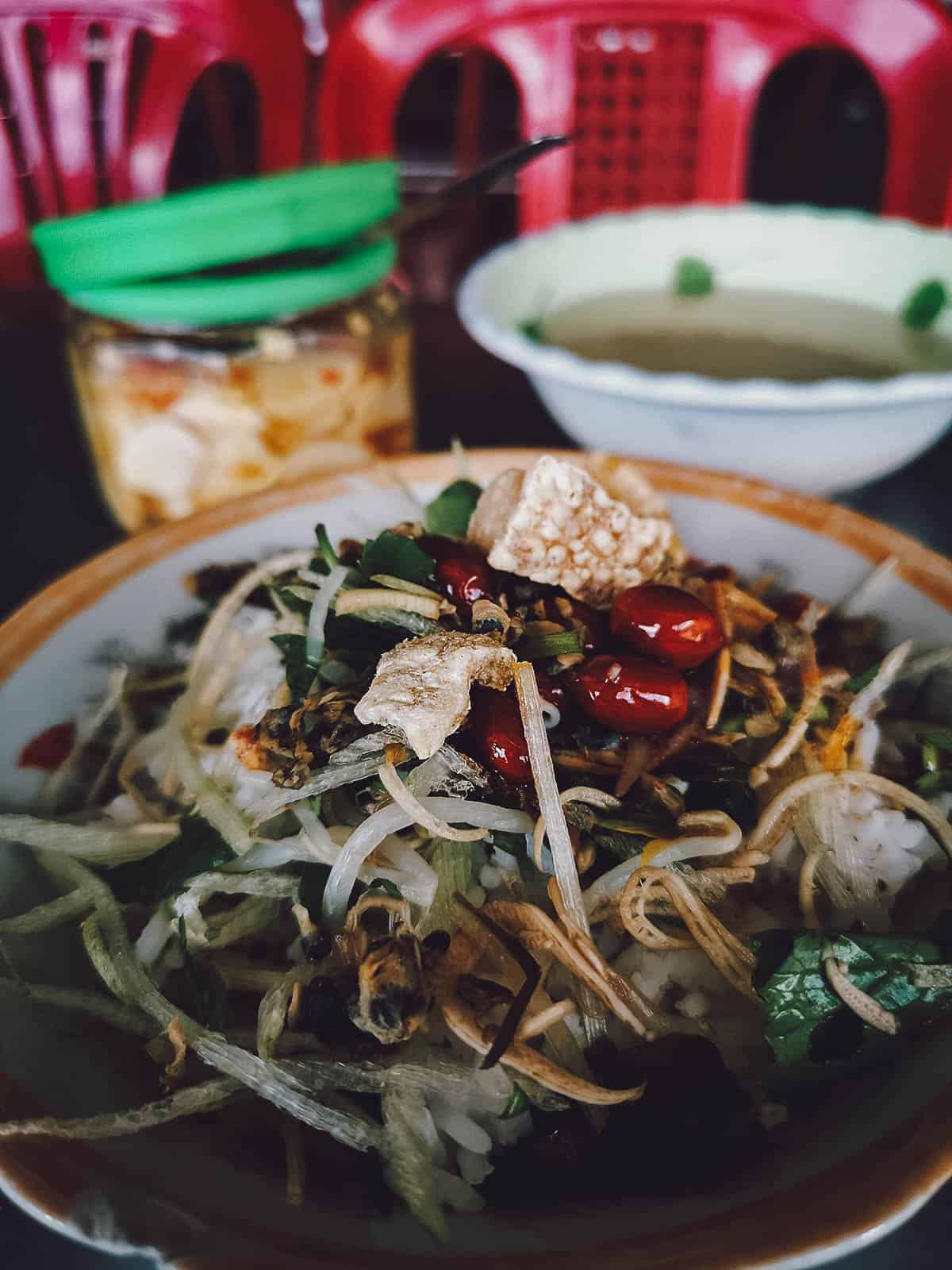
A cluster of those delicious baby basket clams.
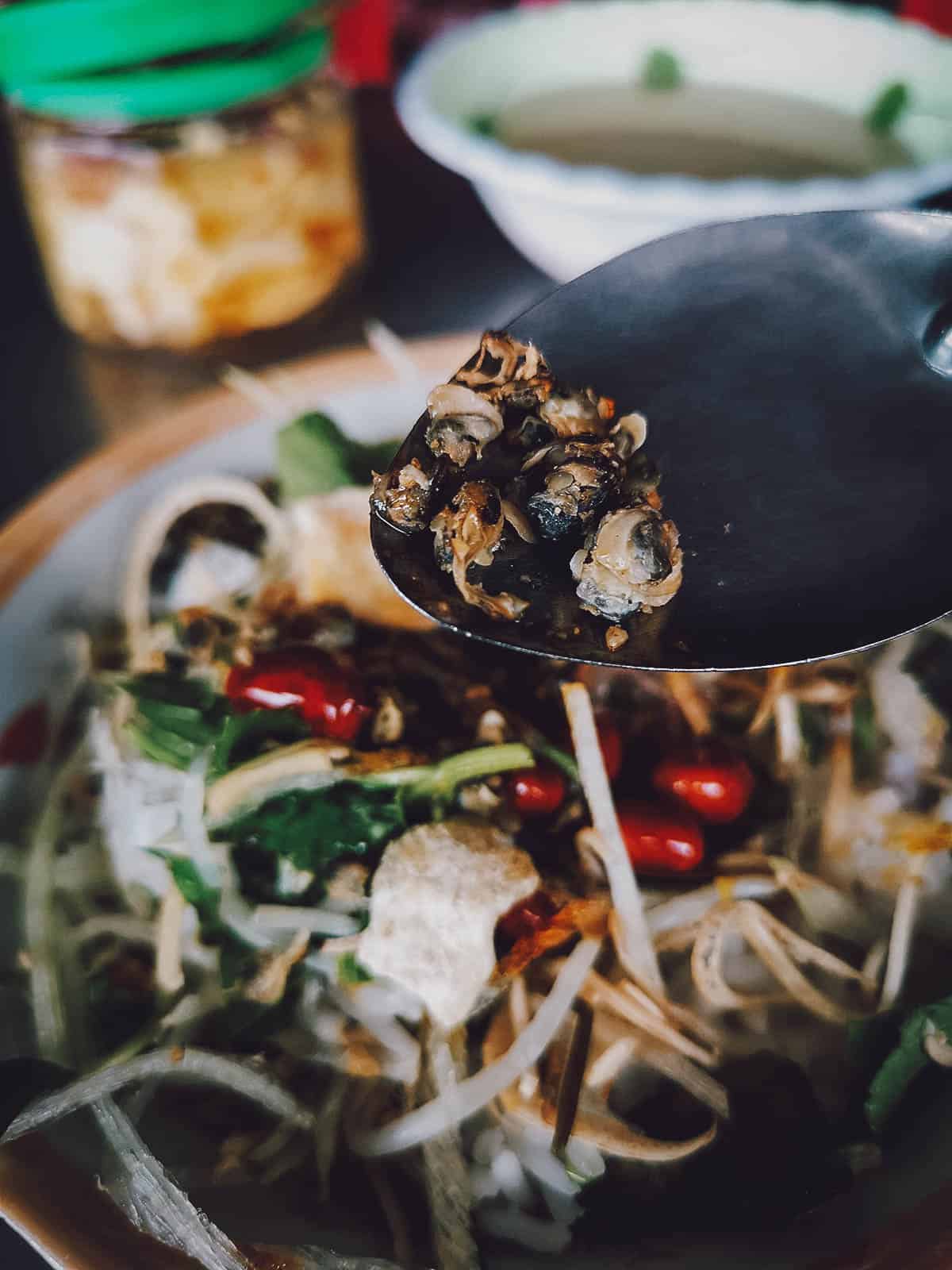
At Com Hen 17 is a stall selling different types of che. Che refers to a family of Vietnamese dessert soups or pudding containing coconut milk and a hodge podge of ingredients like beans, jelly, fruit, tapioca, tubers, cereal, and glutinous rice. There’s an endless variety of che but I wanted to have the che bap, which is a type made with sweet corn.
You can find sweet corn pudding throughout the country but many say the best che bap comes from central Vietnam, particularly in Hoi An, which uses local sweet Cam Nam corn. In Hue, the best corn is said to grow on Con Hen Island.
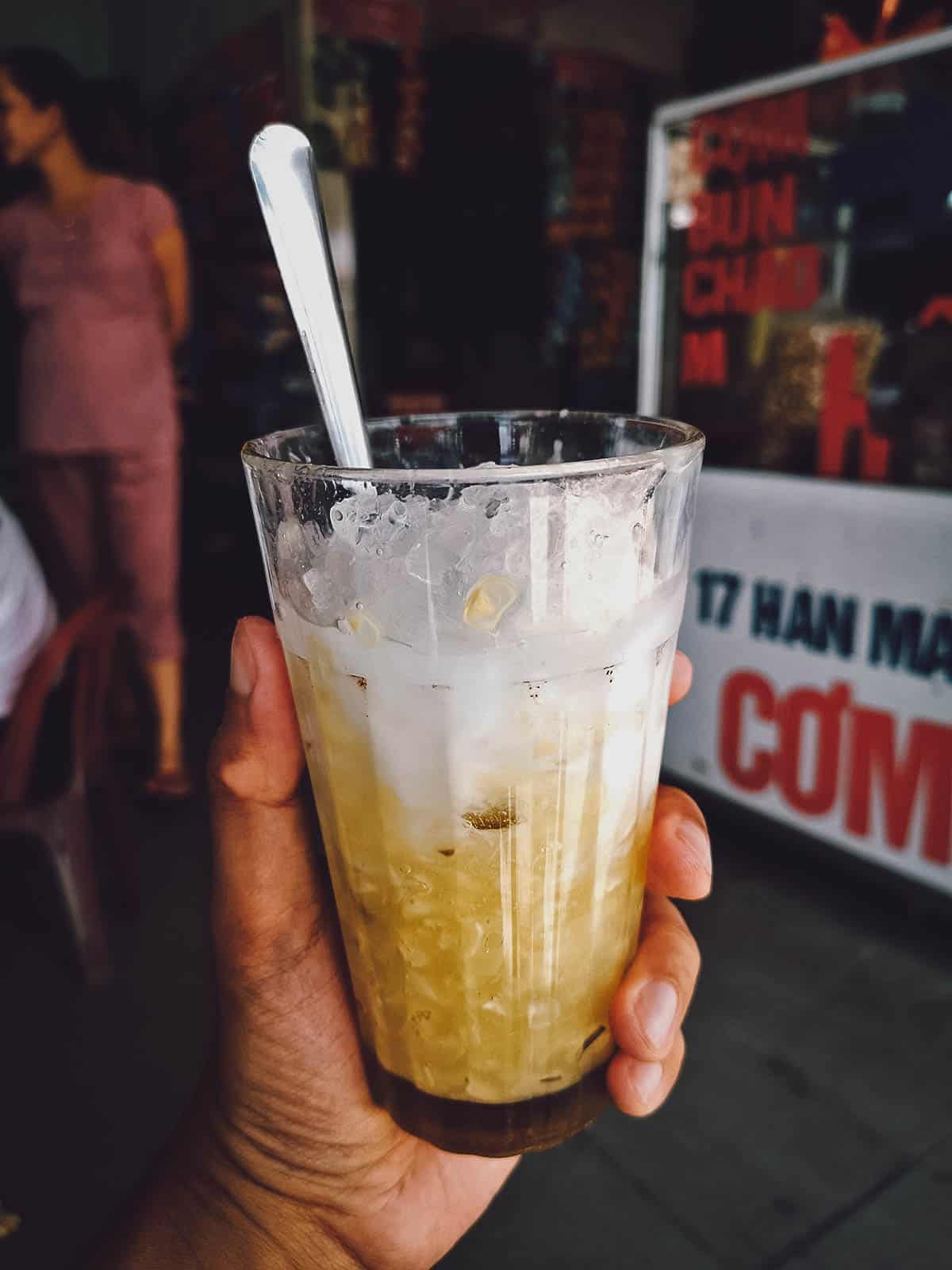
The sweetness of che bap comes naturally from the corn. This one was decent, a little thin perhaps. It wasn’t the best che bap I’d have in Hue.
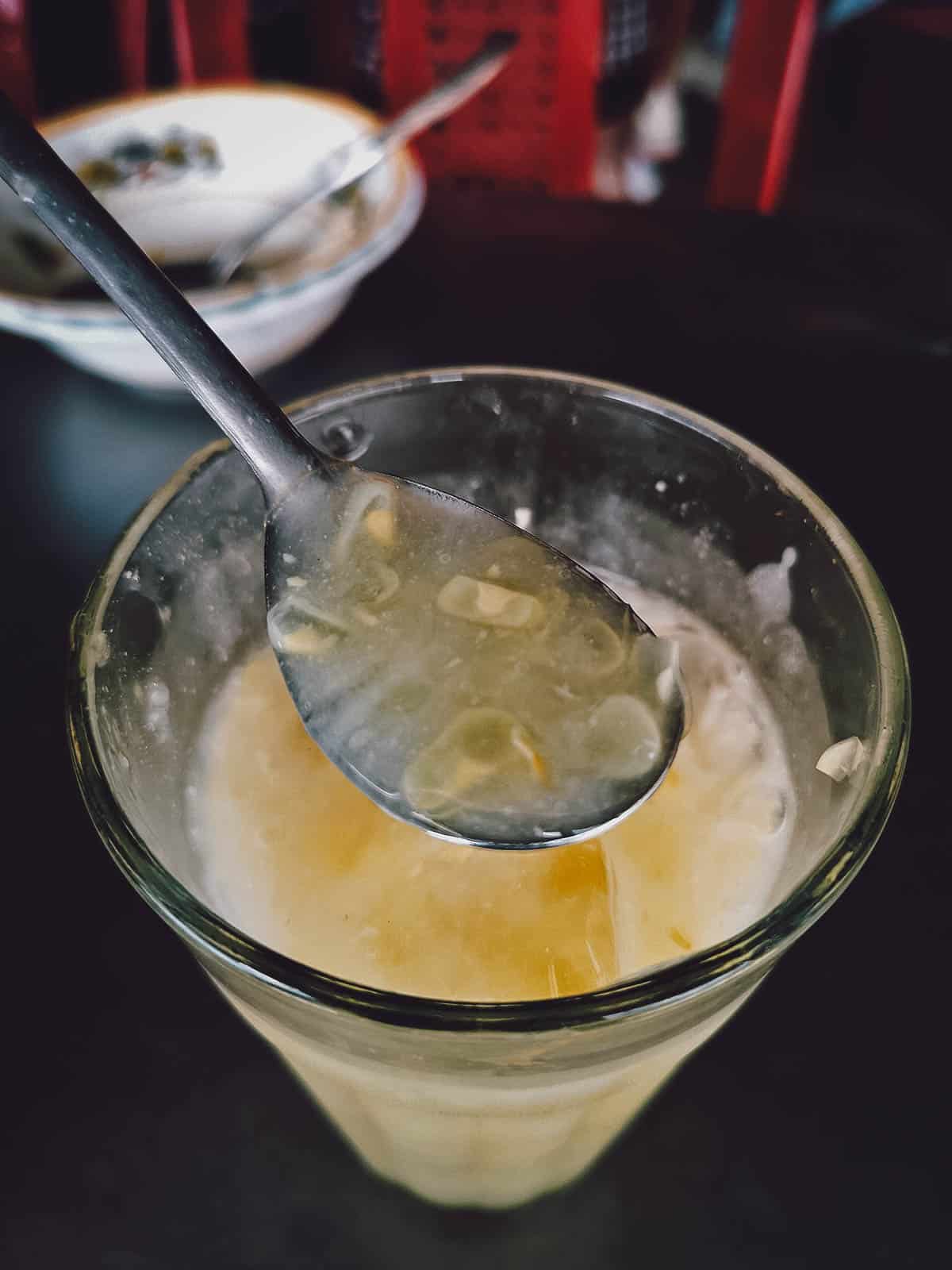
Com Hen 17 is a humble open-air eatery overlooking the Nhu Y River.
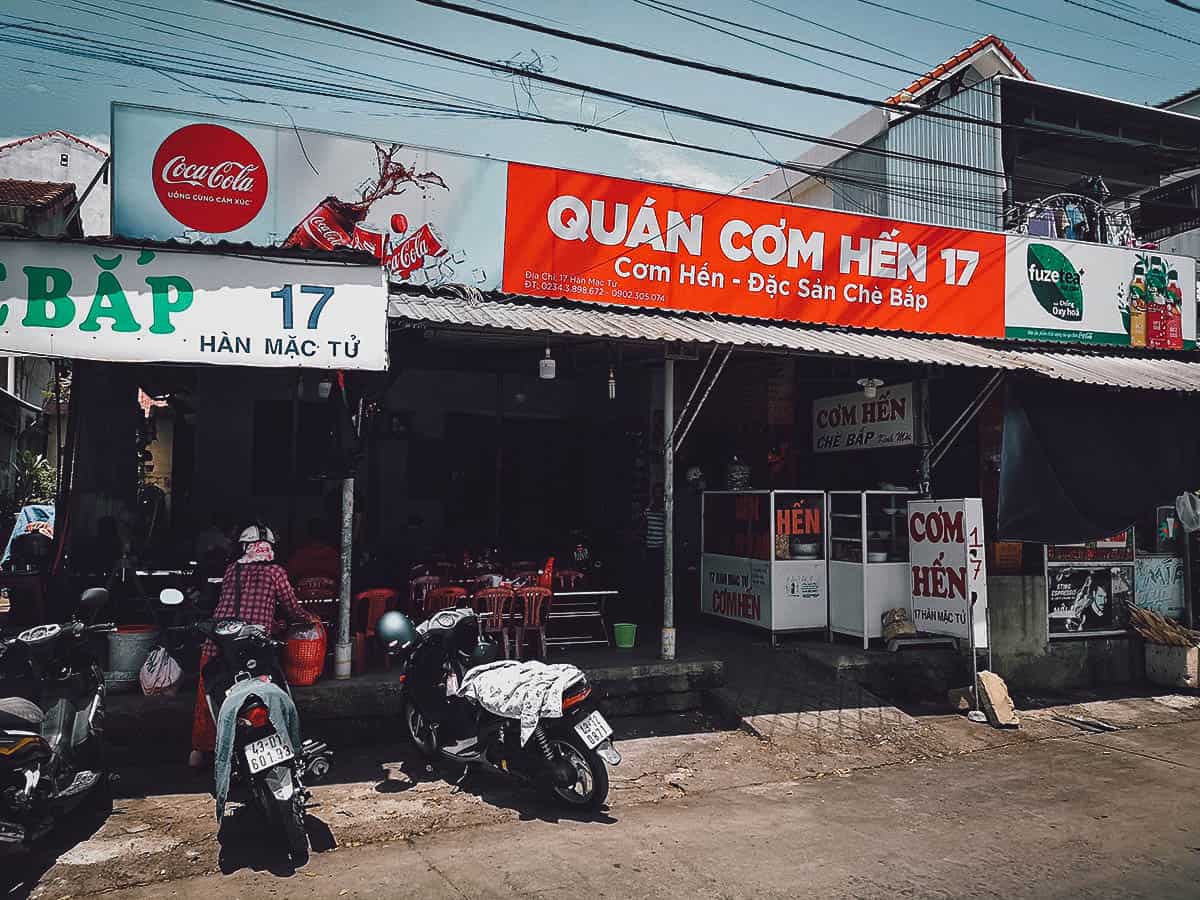
Com Hen 17
Address: Kiệt 17 Hàn Mặc Tử, Vỹ Dạ, Thành phố Huế, Thừa Thiên Huế, Vietnam
Operating Hours: 8AM-9PM, daily
What to Order: Com hen, bun hen, che bap
Expect to Pay: VND 18,000 for com hen and che bap
6. Com Hen Hoa Dong
I didn’t even have this stall on my itinerary, but I’m grateful I found it because Hoa Dong turned out to have the best bun hen and che bap I’d try in Hue.
I was having coffee at Ca Phe Vy Da Xua when I noticed a sliver of an island in the middle of the Perfume River. I was intrigued so I googled it. As it turns out, that small island was Con Hen Island and recognized by many as the birthplace of com hen. In fact, the name con hen literally means “baby clam island”!
I walked to the island after finishing my coffee and made a beeline for Com Hen Hoa Dong, an open-air eatery with the highest and most number of ratings on Google Maps. Based on what I’ve read, it’s been open since the 1960s and is currently in its third generation of ownership.
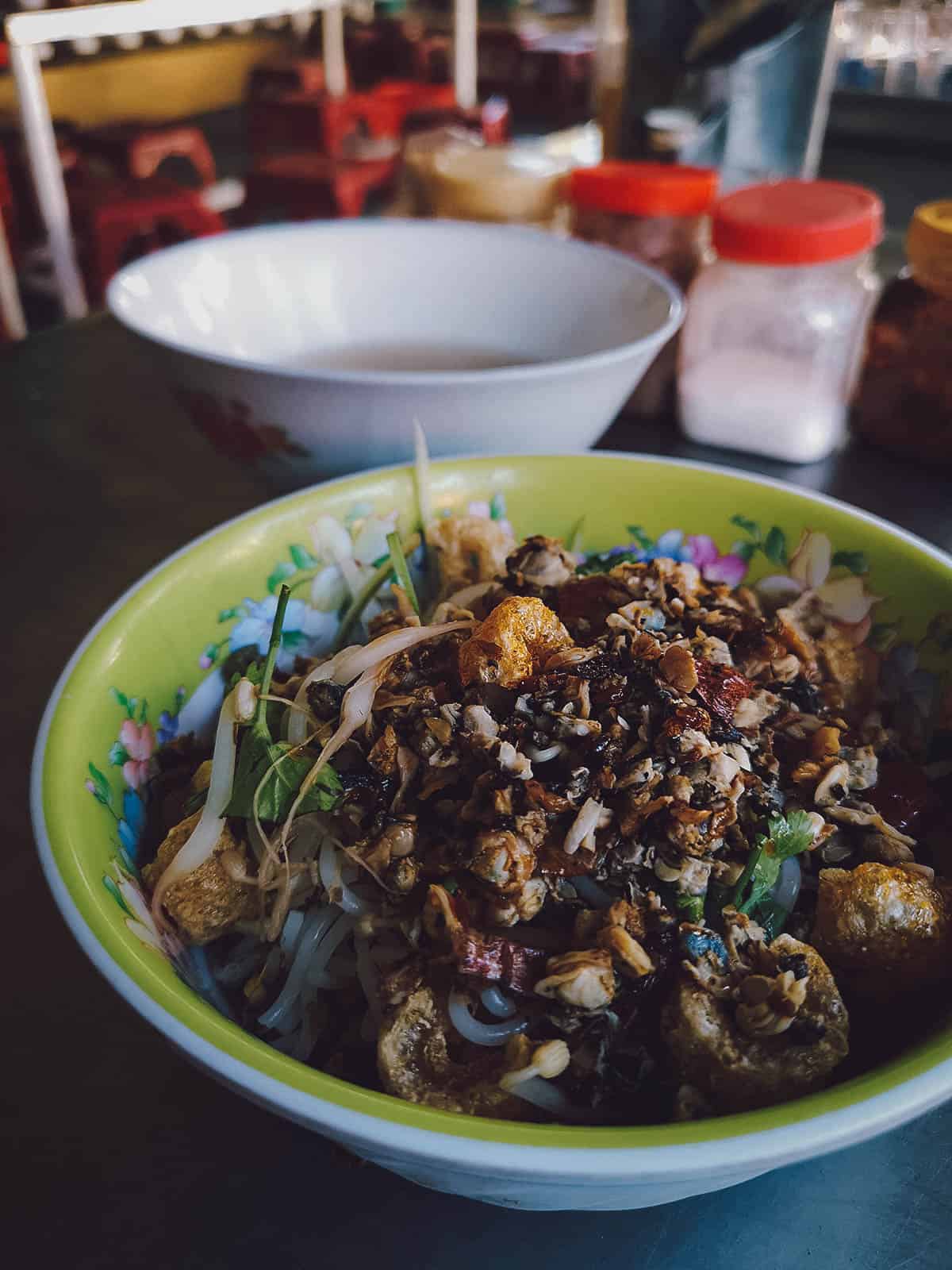
As described, it’s believed that com hen was invented right here on Con Hen Island. Fish and shrimp were considered premium seafood meant to be sold at market, so the villagers relegated themselves to a diet of less expensive proteins like baby clams which they’d breed in the alluvial-rich banks of the island. I walked the entire length of Con Hen and found thousands of discarded clam shells at one end of the island.
It’s funny, I was taking my time, taking pictures of my bowl of com hen, when one of Hoa Dong’s elderly owners walked over with her cane and started mixing my bowl for me. I guess she thought I didn’t know how to eat it so she took it upon herself to show me. Ha!
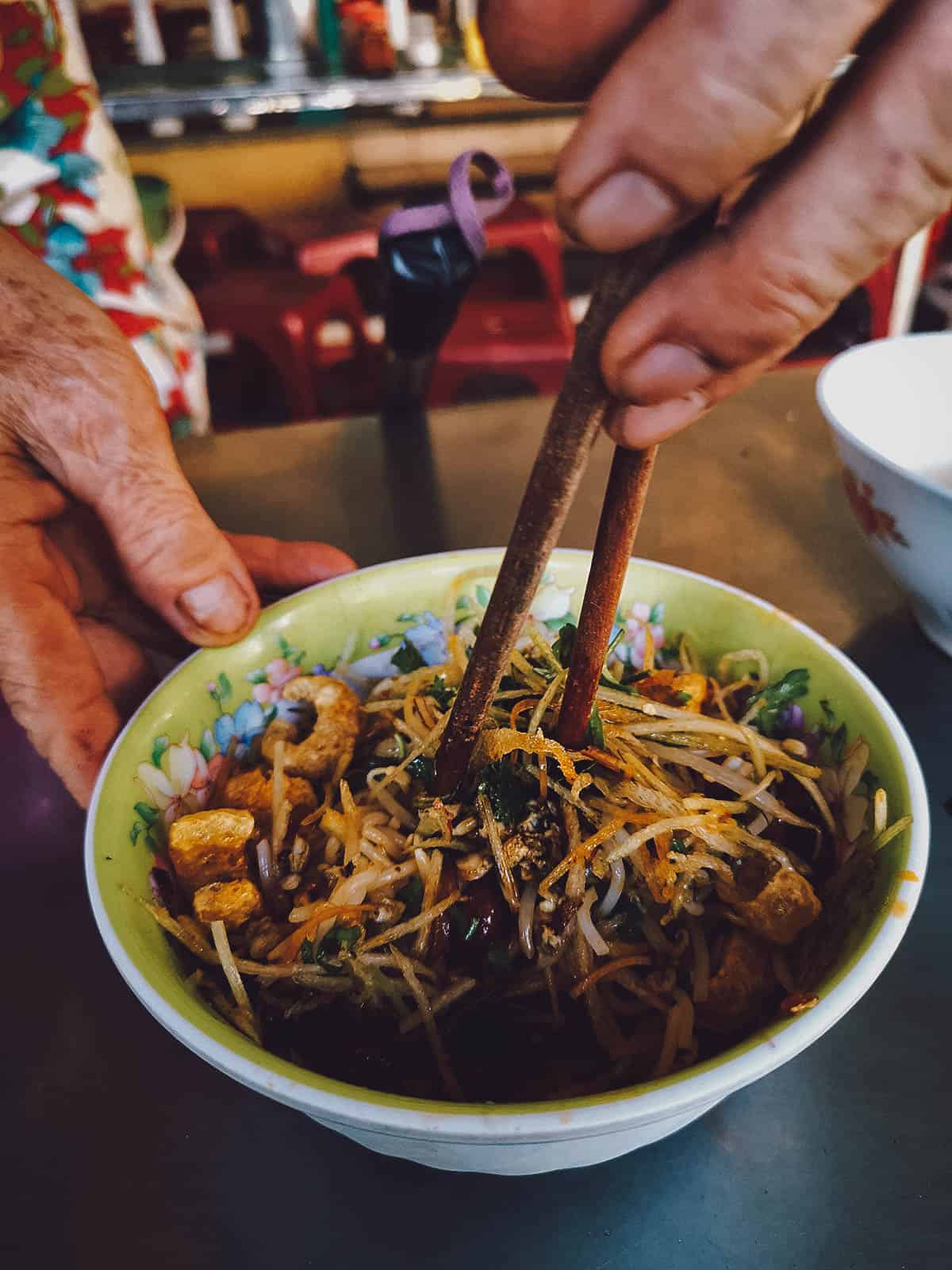
As previously described, every other bowl of bun hen or com hen tasted pretty much the same to my inexperienced taste buds, except this one. This bun hen was clearly the best one. It was redolent with briny clam flavor. It was absolutely delicious and something I wouldn’t mind having everyday in Hue.
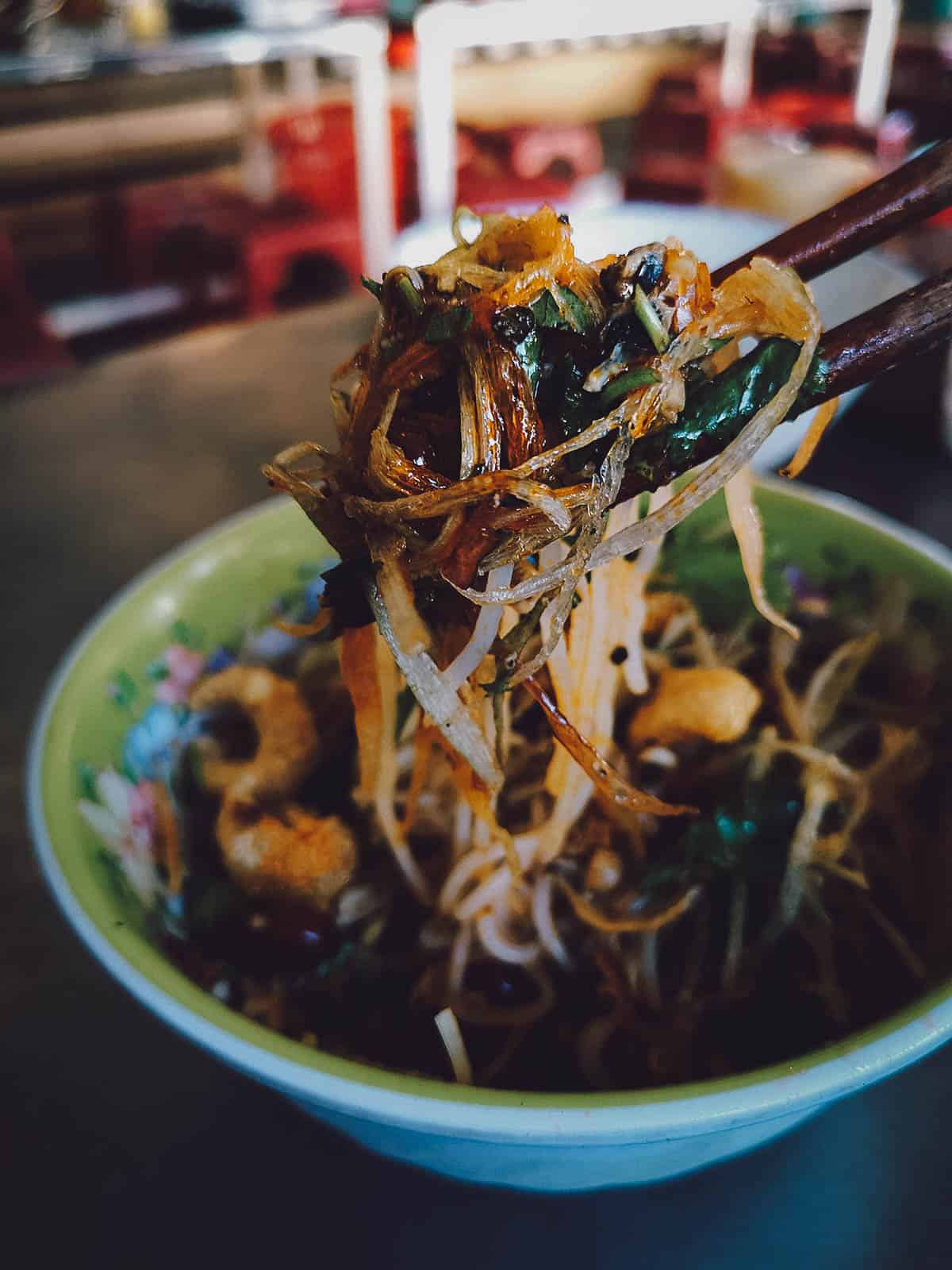
Com hen or bun hen aren’t the only dishes you should have on Con Hen Island. You should also have the che bap. It’s made with the island’s corn which many believe is the best in Hue.
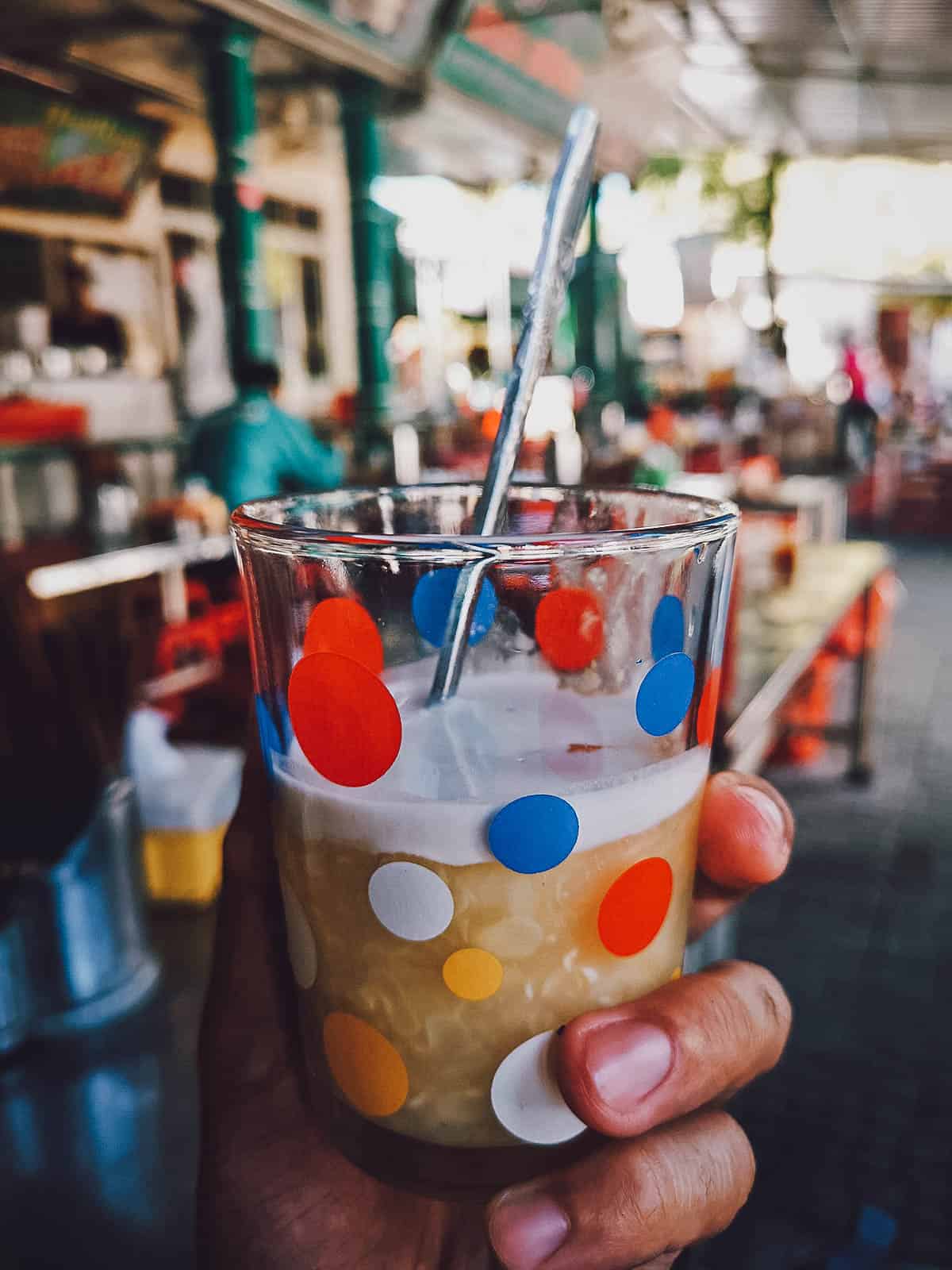
Notice how much thicker and goopier this looks compared to the che bap at Com Hen 17? It was creamier and chunkier with a fuller, more pronounced flavor of sweet corn. It was delicious. Definitely follow up your bowl of bun hen or com hen with a glass of this.
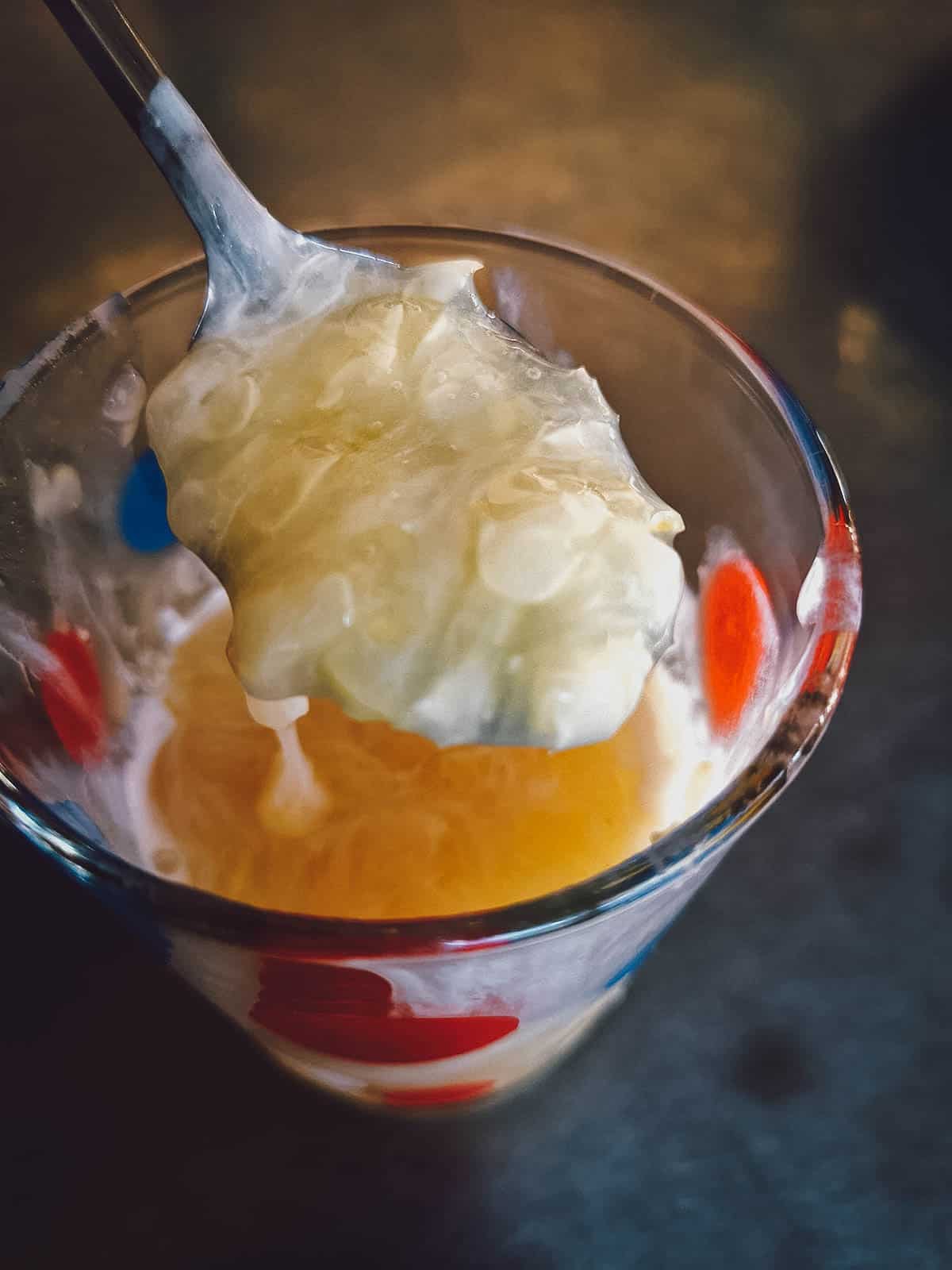
Con Hen is a small island with just two main roads running along either side, so you shouldn’t have any trouble finding Com Hen Hoa Dong. It’s the biggest restaurant there.
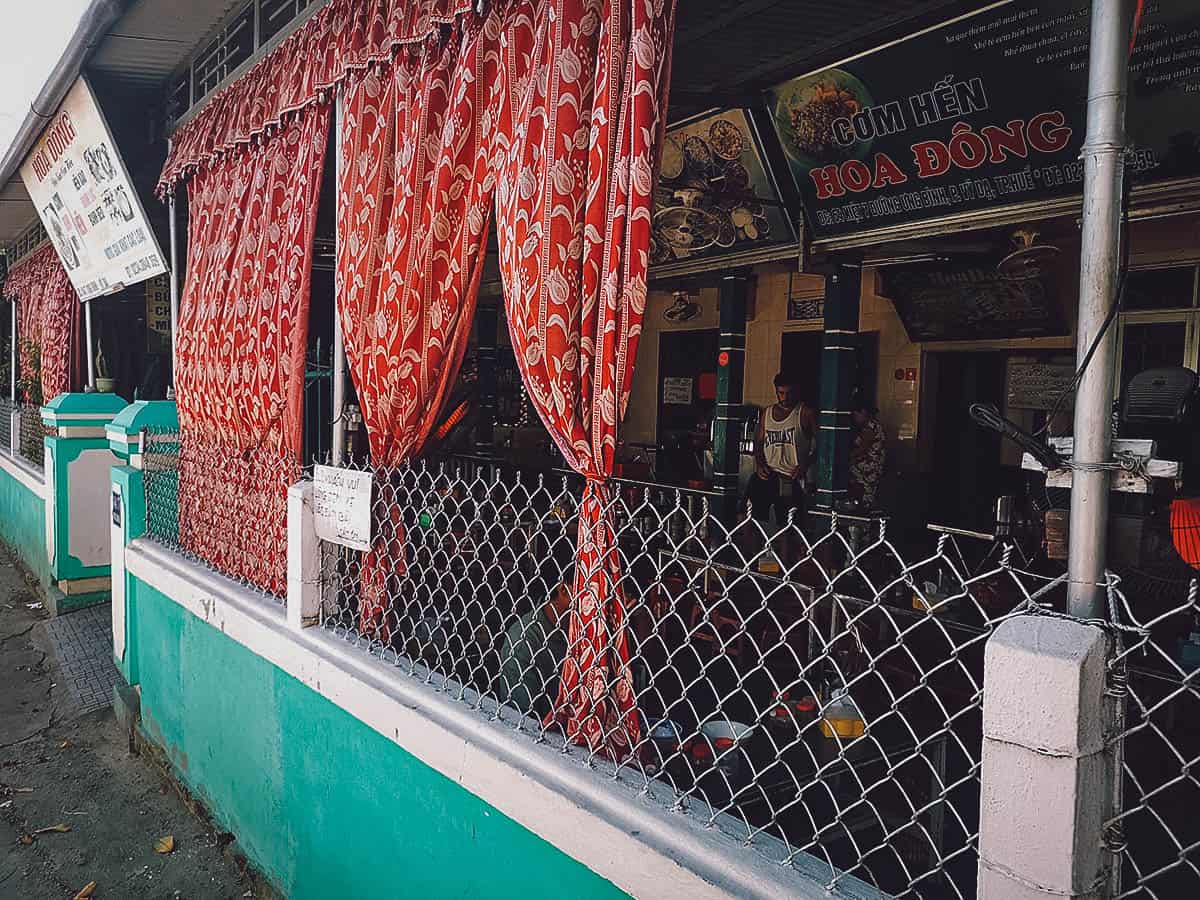
Com Hen Hoa Dong
Address: 64 kiệt 7 Ưng Bình, Vỹ Dạ, Thành phố Huế, Thừa Thiên Huế, Vietnam
Operating Hours: 7AM-10PM, daily
What to Order: Com hen, bun hen, che bap
Expect to Pay: VND 28,000 for bun hen, che bap, and drinks
7. Che Hem
Che bap is just one type of che. As described, you’ll find a limitless variety of sweet soups and pudding in Vietnam. Unlike bun bo and com hen, it didn’t originate in Hue and is popular throughout Vietnam.
Xem thêm: Shin'S Bbq Cần Thơ – Các Quán Buffet Ngon Ở Cần Thơ
Che Hem serves only che and as you can see below, they offer many different types. There’s che made from beans, che from rice and grains, che with jellies, che with fruits, and the endless variety mixing and matching these ingredients.
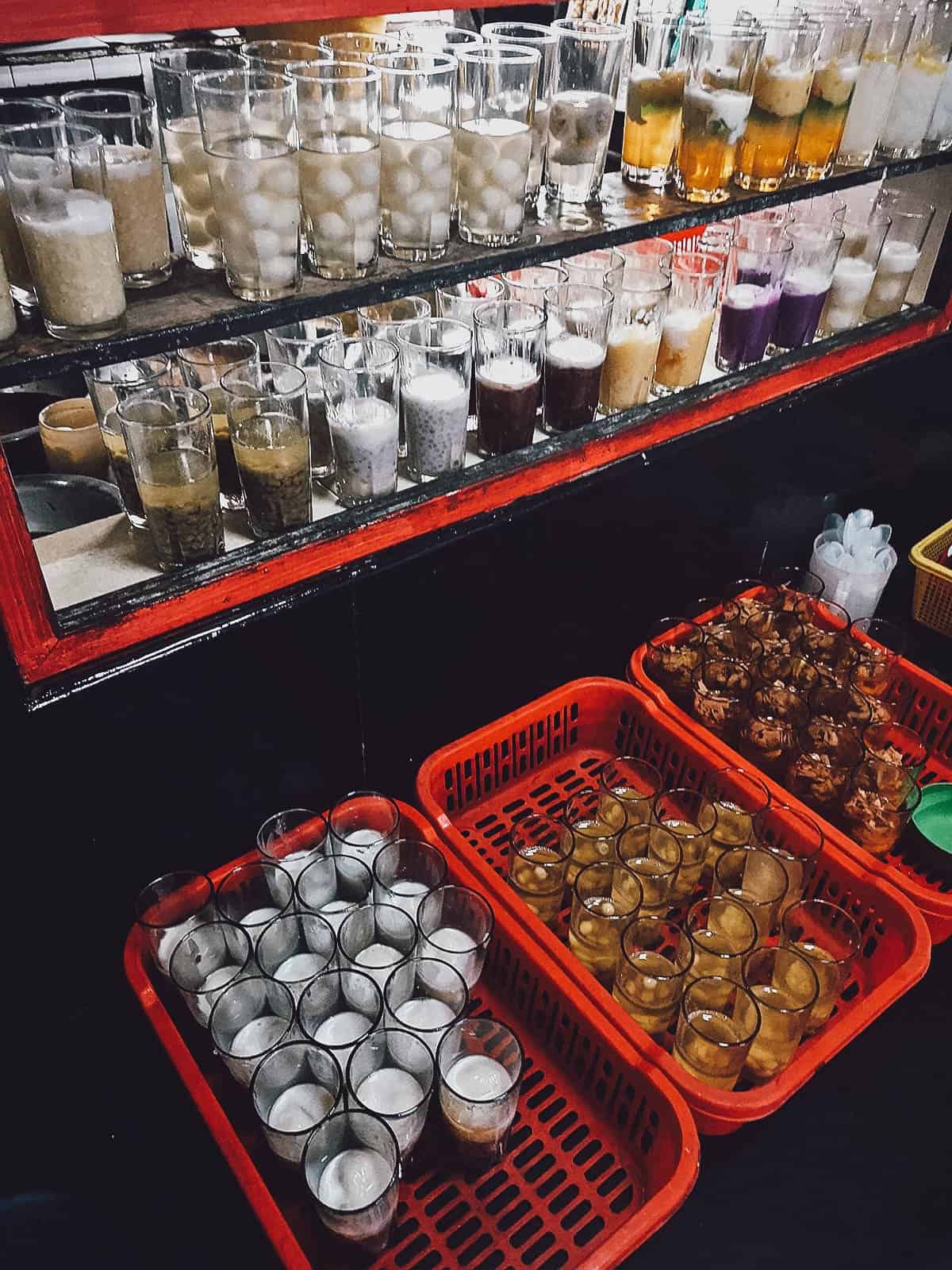
I usually ask restaurant servers for recommendations, but no one here seemed particularly eager to help so I just grabbed the most attractive-looking glass. This one with dark golden brown contents looked pretty good to me. It had different types of beans, glutinous rice balls, and perhaps a few other ingredients.
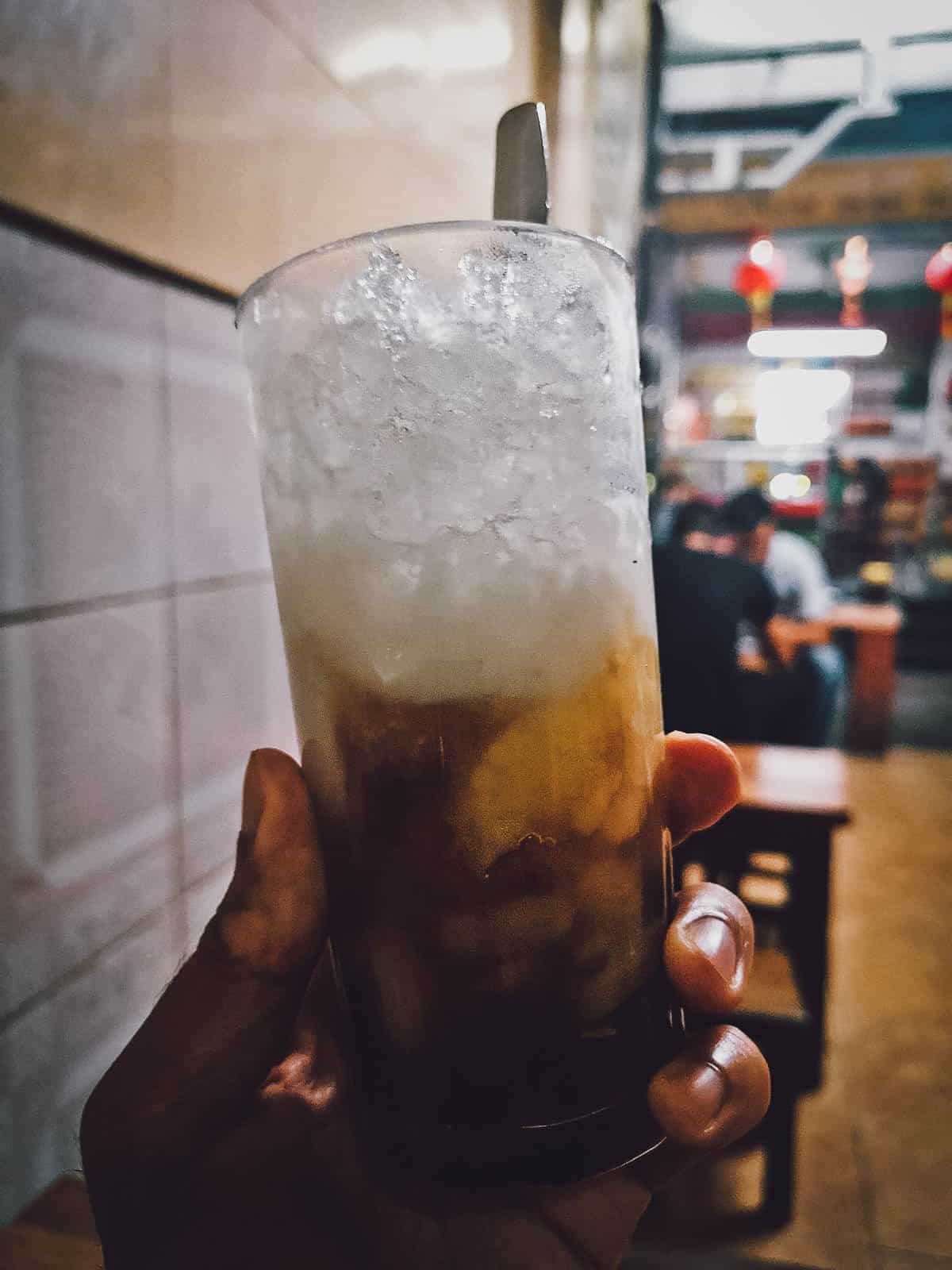
Here’s a closer look at this che’s ingredients. Filipinos will say that che looks like the Vietnamese version of halo-halo, and they’d be right. They’re similar desserts but che seems to have an even wider assortment of ingredients.
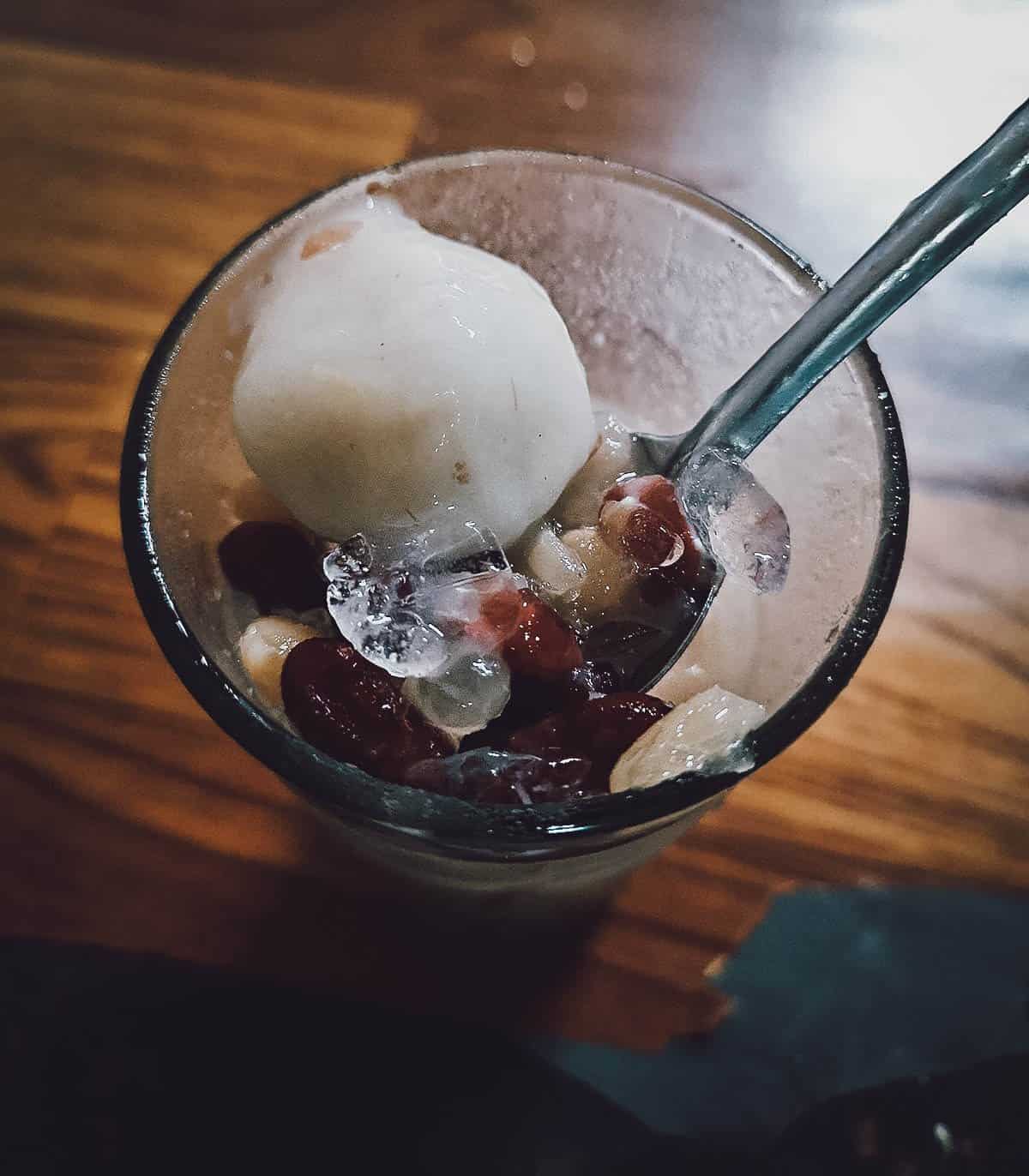
Che Hem is located inside this alley just off Hung Vuong Street.
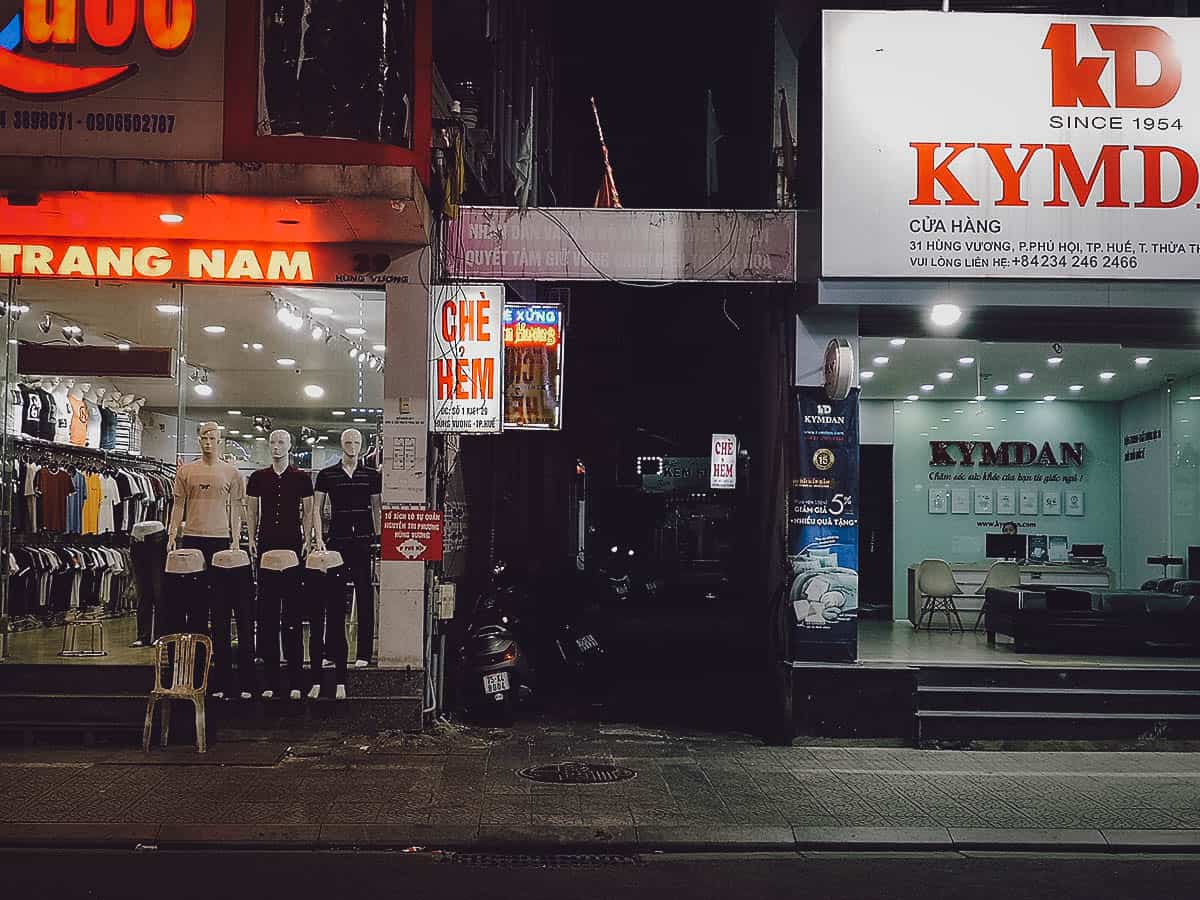
Che Hem
Address: 1 kiệt, 29 Hùng Vương, Phú Hội, Thành phố Huế, Thừa Thiên Huế, Vietnam
Operating Hours: 10AM-10PM, daily
What to Order: Che
Expect to Pay: Around VND 10,000 per glass
8. Hang Me Me
This family of rice flour cakes collectively known as “banh hue” is what drew me to this city in the first place. Ren and I were intrigued by the banh beo we had in Hoi An on our firs trip. When I learned it was a dish associated with Hue, I knew it was something I needed to have at the source.
Google “where to have in hue” and Hang Me Me often comes up. They offer sampler platters with banh beo, banh nam, banh loc, banh ram it, banh uot, and cha tom. It’s normally for two people but they were nice enough to give me a single person serving for VND 100,000 (normally VND 180,000).
I’ll describe each one in more detail below, but you’ll find that almost every type is made with rice flour and shrimp in some form. Because they share similar ingredients, they taste relatively the same – soft, silky, and loaded with sweet and savory umami flavor.
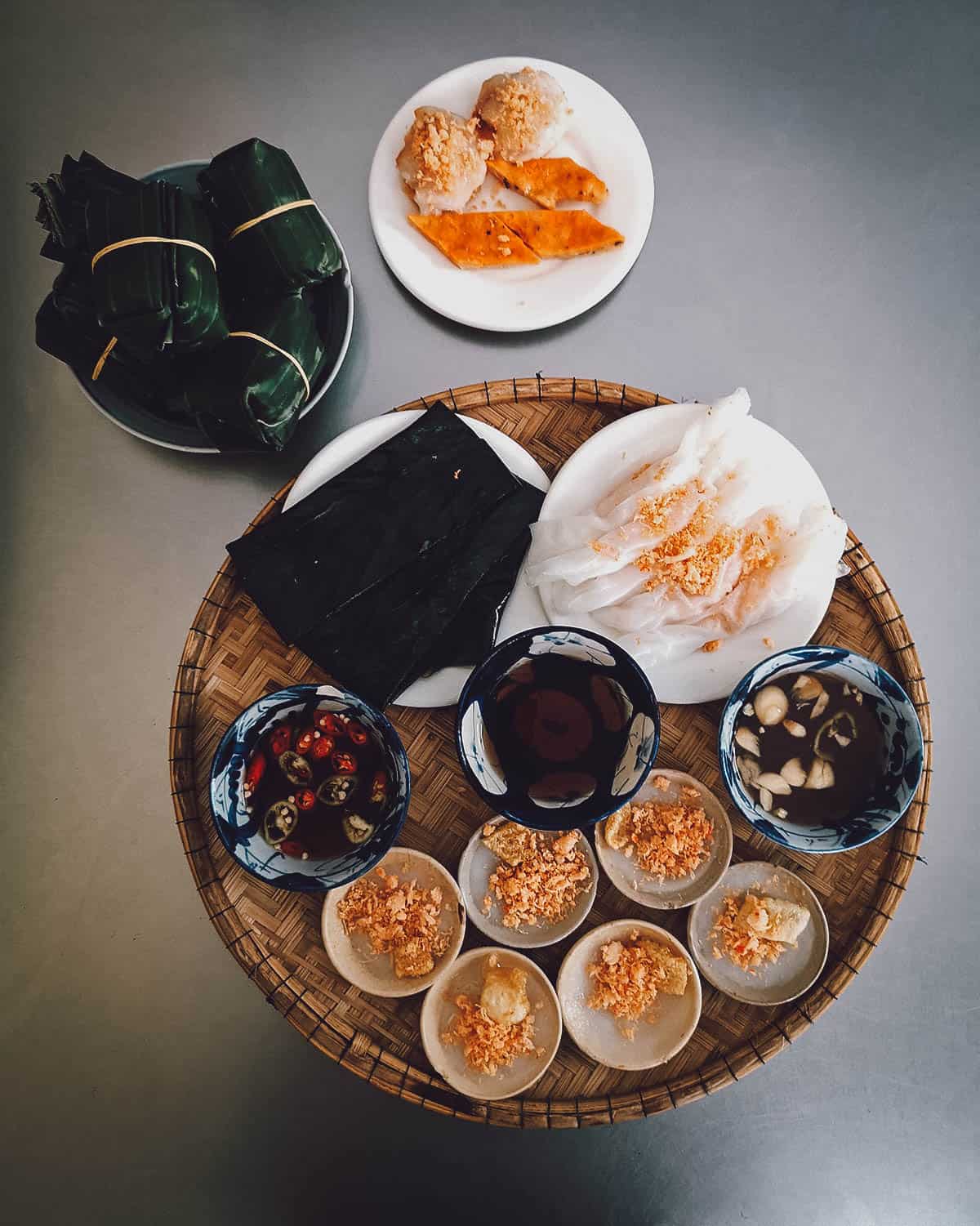
Banh beo is perhaps the most well-known among Hue’s rice flour cakes. It consists of steamed rice cakes topped with dried shrimp and pork rinds, and sometimes with a few other ingredients like scallions, roasted peanuts, mung bean paste, and fried shallots. It’s served with a side of nuoc cham.
For reasons that are unclear, the term banh beo literally translates to “water fern cake”. In Vietnamese slang, perhaps due to its plain white appearance, banh beo is used to refer to girls that are perceived to be “typical, basic, boring, or cliched”. Girls like that need some nuoc cham!
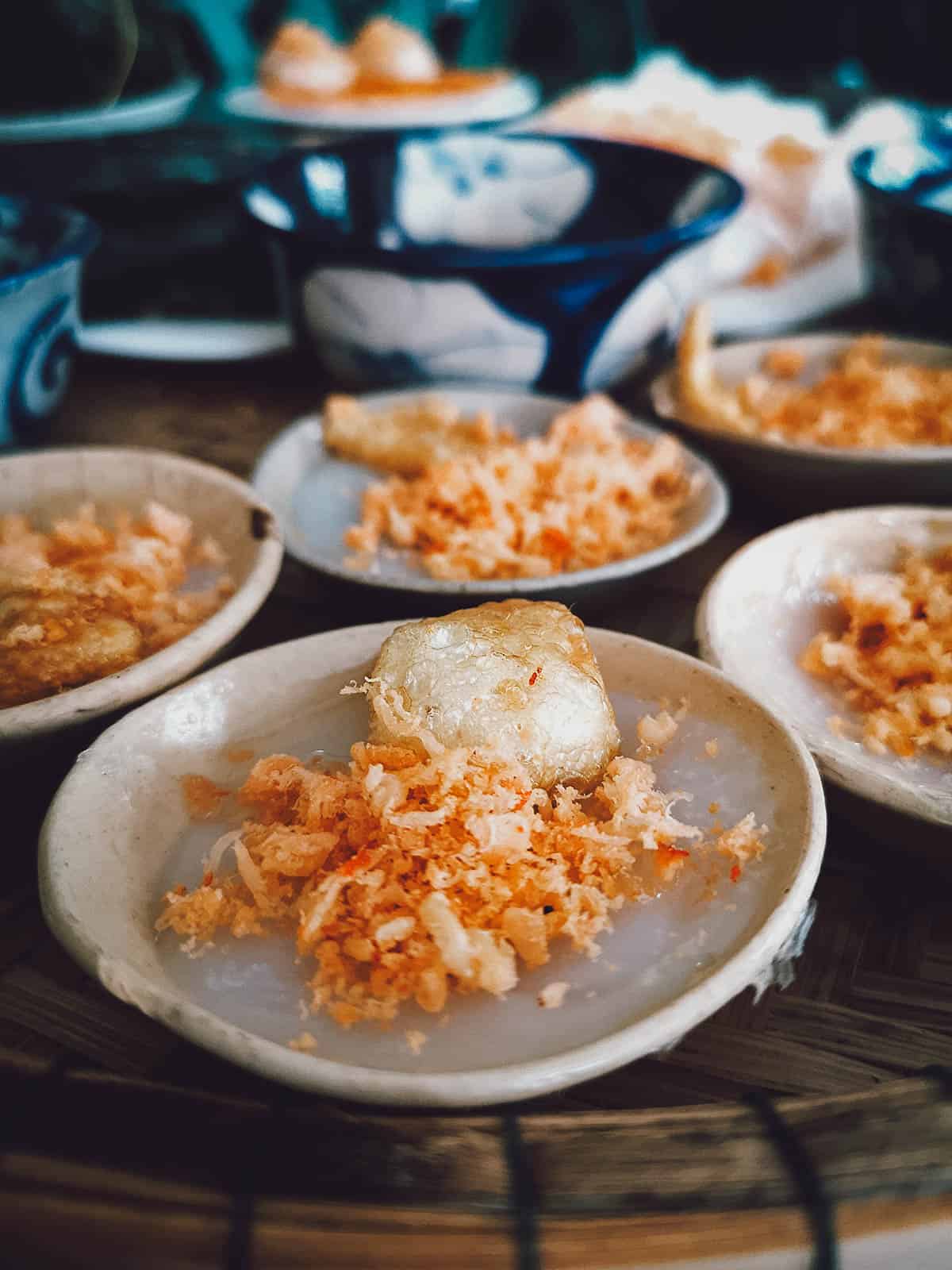
Banh uot is similar to banh beo except the steamed rice flour is formed into thin rolled-up sheets. It’s also eaten with nuoc cham and a side of cha lua or Vietnamese pork sausage.
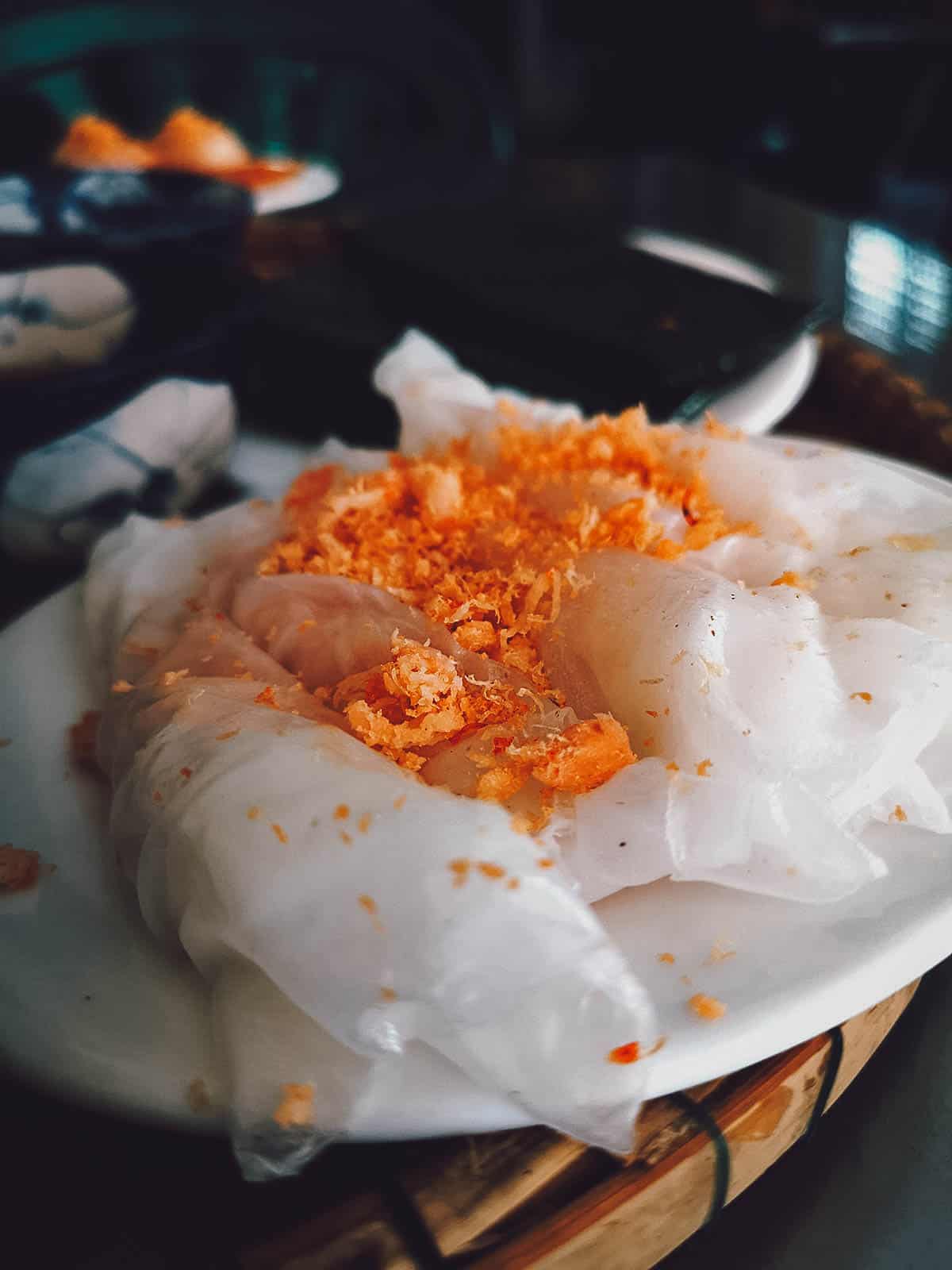
On the left are cha tom or Vietnamese shrimp cakes or patties. Hang Me Me’s menu describes it as a mixture of the five types of banh hue listed here.
On the right are banh ram it which consists of crunchy rice crackers topped with steamed sticky rice dumplings containing shrimp and sprinkled with bits of pork crackling. This may have been my favorite of the six types of banh hue because of the textural variety.
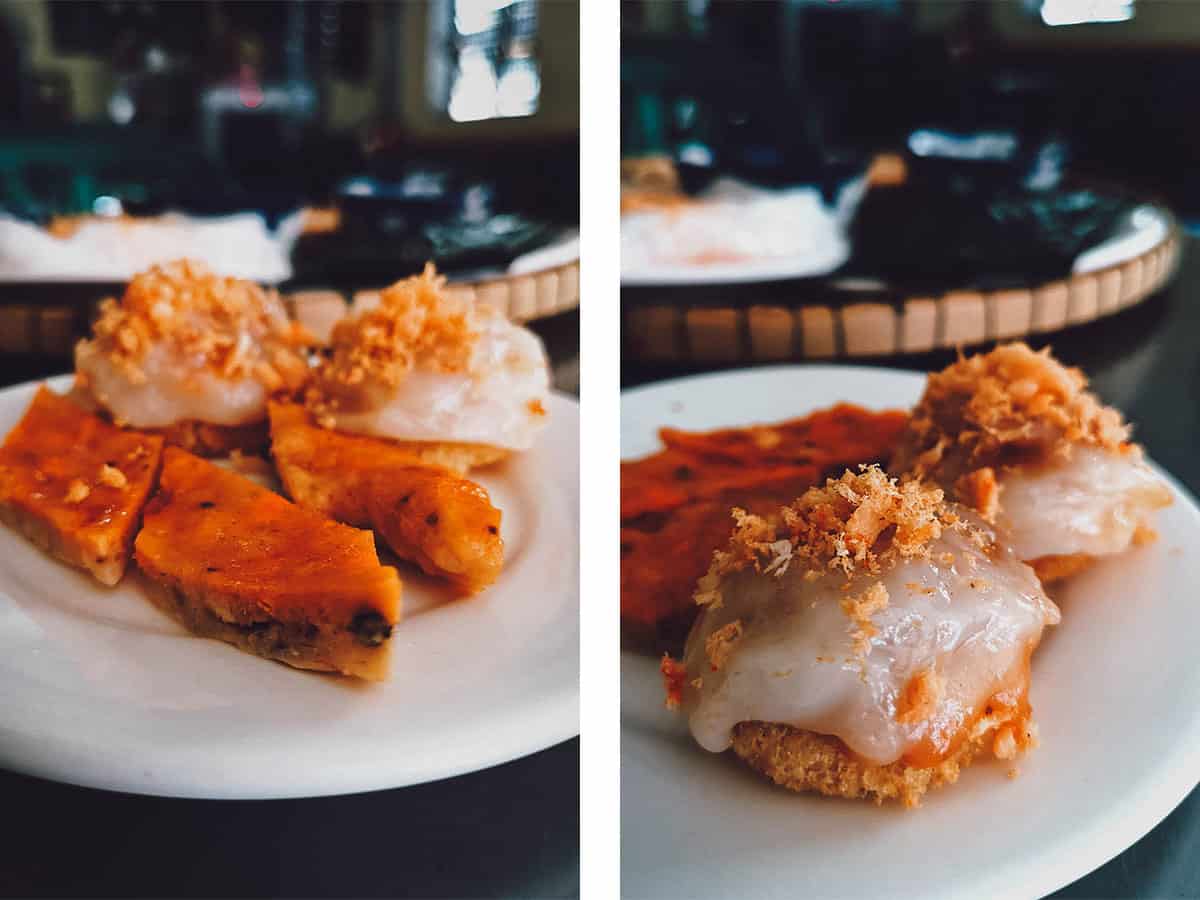
The last two types of banh hue come wrapped in banana leaves. Banh nam consists of rice batter, ground shrimp, and scallions wrapped in banana leaves before being steamed.
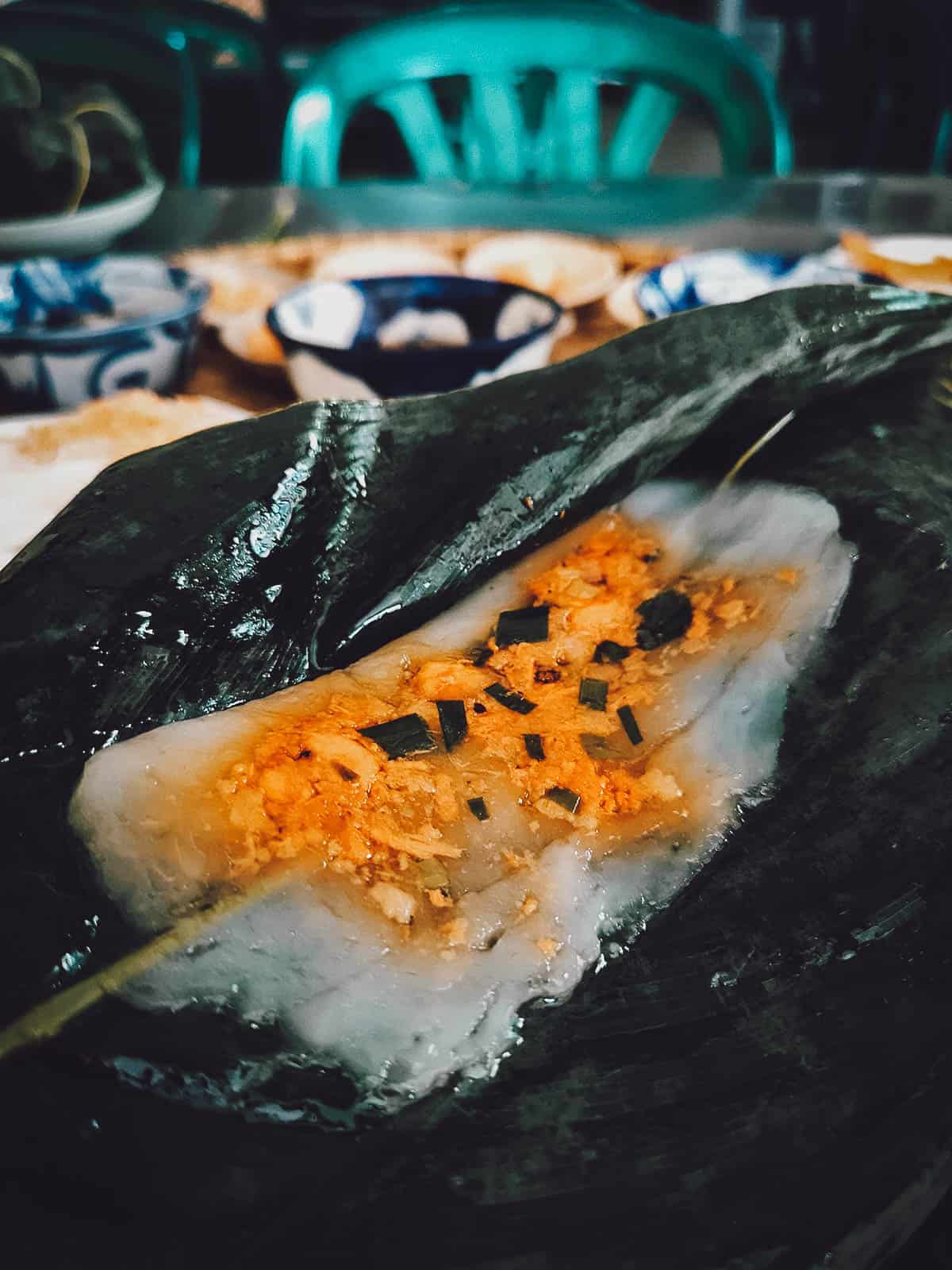
Banh loc is the only type of banh hue that isn’t made with rice flour. Instead, it’s made with tapioca flour containing a piece of marinated shrimp wrapped and steamed in banana leaves. As you can see, the wrapper becomes translucent after being steamed.
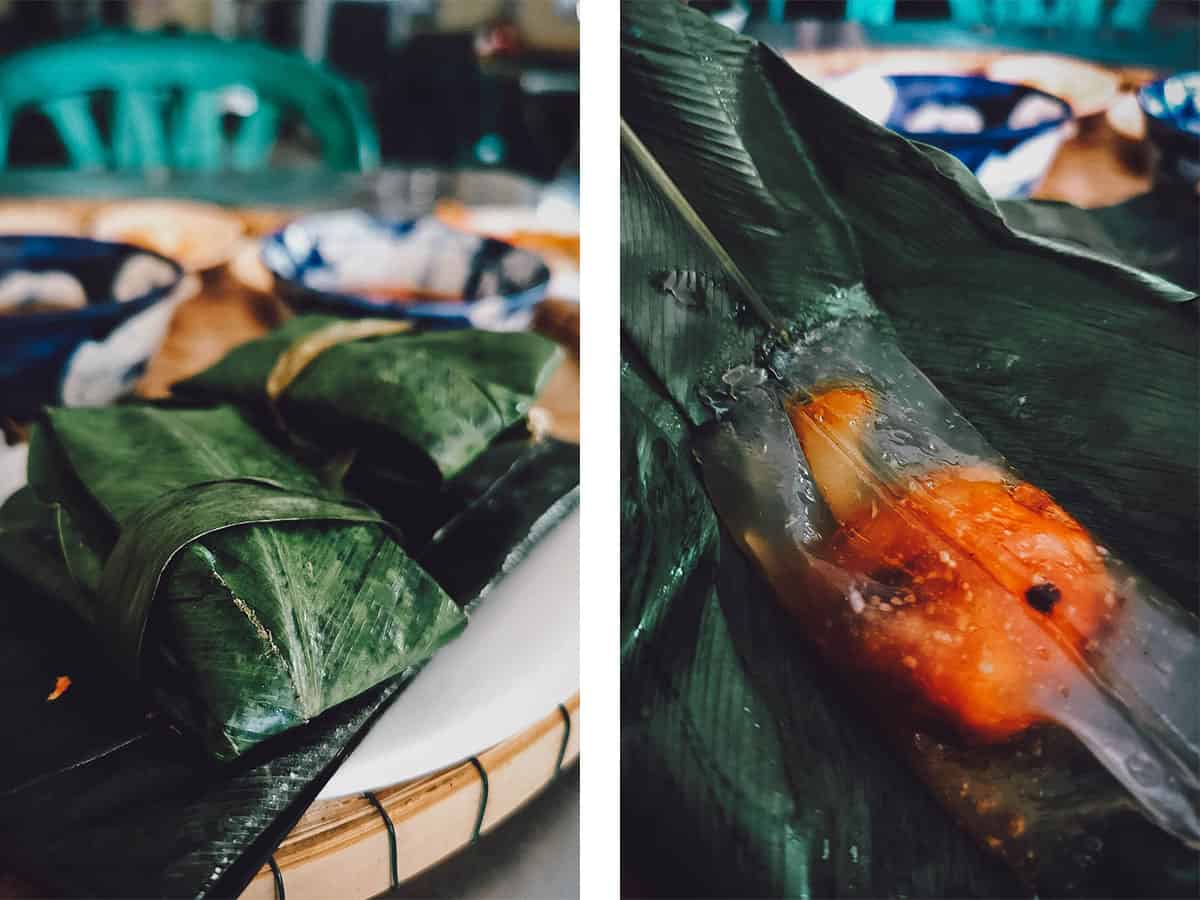
This was confusing. As you can see below, there are two restaurants of similar names right next to each other – Hang Me Me and Hang Me. I meant to go to Hang Me Me but I came from the right side of the street so I wound up eating at Hang Me without realizing it.
I did some digging and according to this Vietnamese reviewer, Hang Me was the original restaurant. The owner’s younger sister opened her own restaurant right next door and called it Hang Me Me. Between the two, Hang Me Me seems to be the more popular restaurant and is a TripAdvisor Certificate of Excellence awardee.
I didn’t eat at Hang Me Me so I don’t know how different their food is, but I’m guessing it’s pretty similar. According to the owner of Hang Me, her younger sister used to work for her before opening her own restaurant.
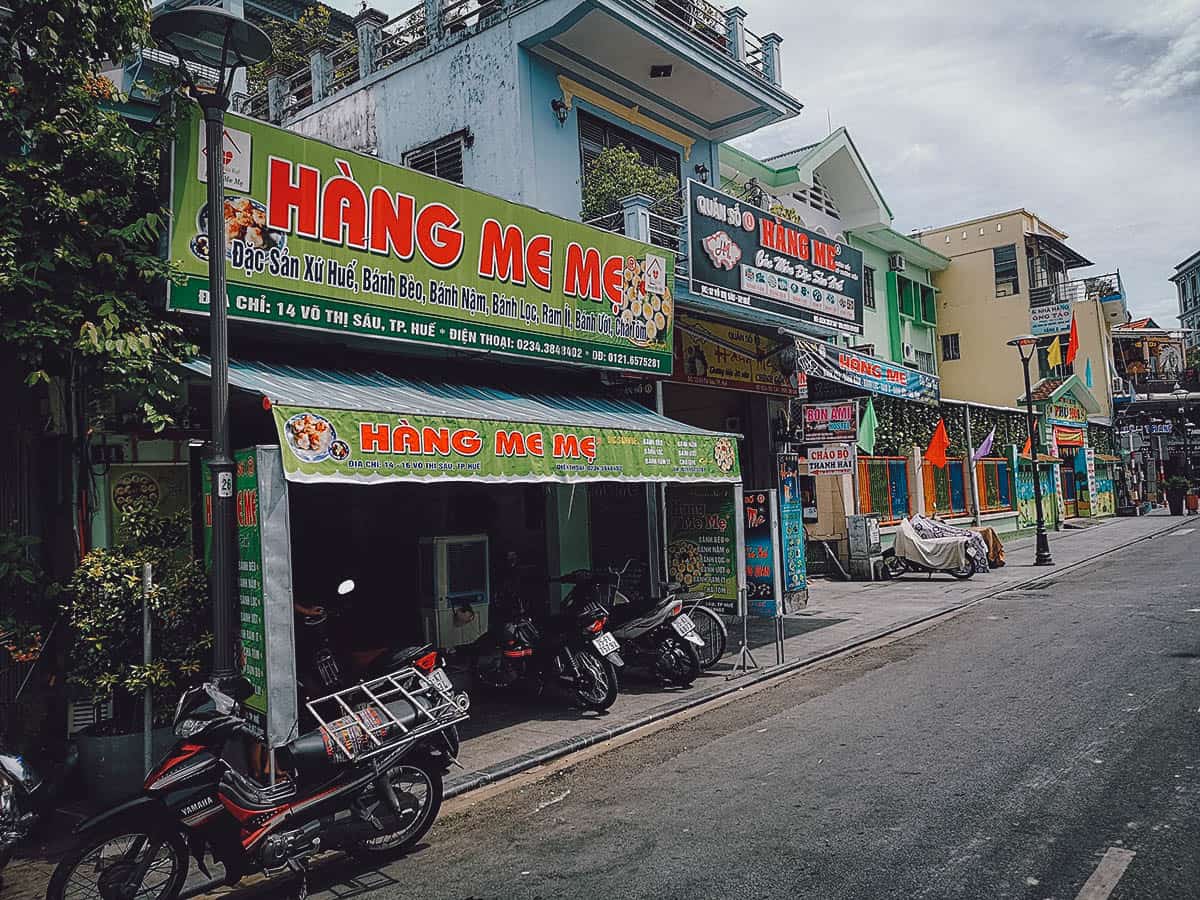
Hang Me Me
Address: 14 Võ Thị Sáu, Phú Hội, Thành phố Huế, Thừa Thiên Huế, Vietnam
Operating Hours: 7AM-10PM, daily
What to Order: Special banh hue combo
Expect to Pay: VND 180,000 (for two)
9. Tai Phu
Nem lui is another dish associated with Hue. They’re marinated beef or pork kebabs wrapped around lemongrass stalks or bamboo skewers and grilled over charcoal. They’re served with thin rice paper, rice vermicelli, lettuce, cucumber slices, and fresh herbs along with a bowl of peanut sauce made with fermented beans, sesame seeds, shrimp paste, garlic, chili, and shallots.
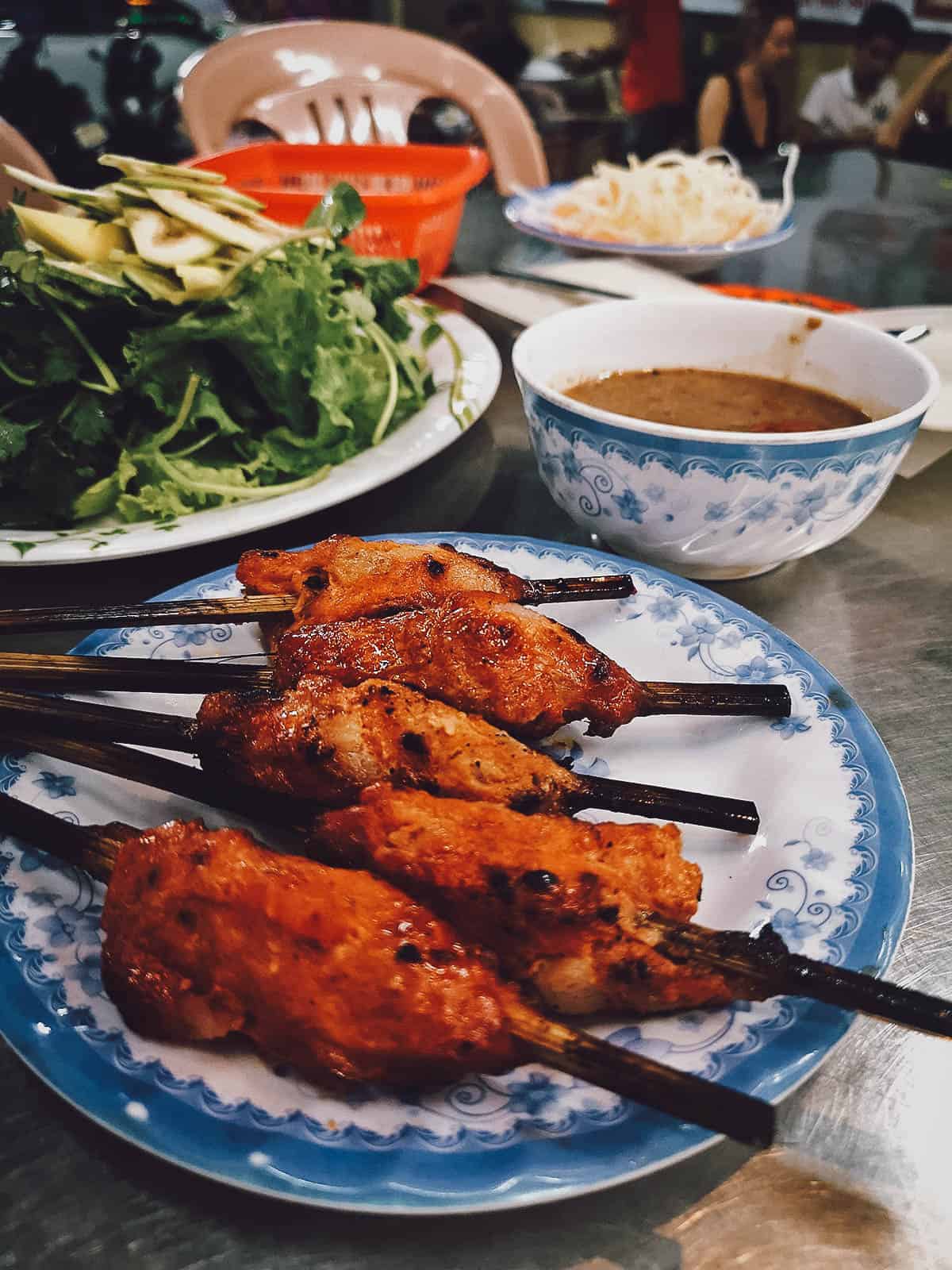
To eat, you wrap the grilled meat in the rice paper along with some lettuce, rice vermicelli, and other ingredients before dipping into the peanut sauce. It’s smokey, sweet, savory, nutty, crunchy, a little sour, and a whole lot of delicious.
If you liked smokey grilled meat, then you’re going to love nem lui. I imagine it to be one of the more universally appealing regional dishes you can have in Hue.
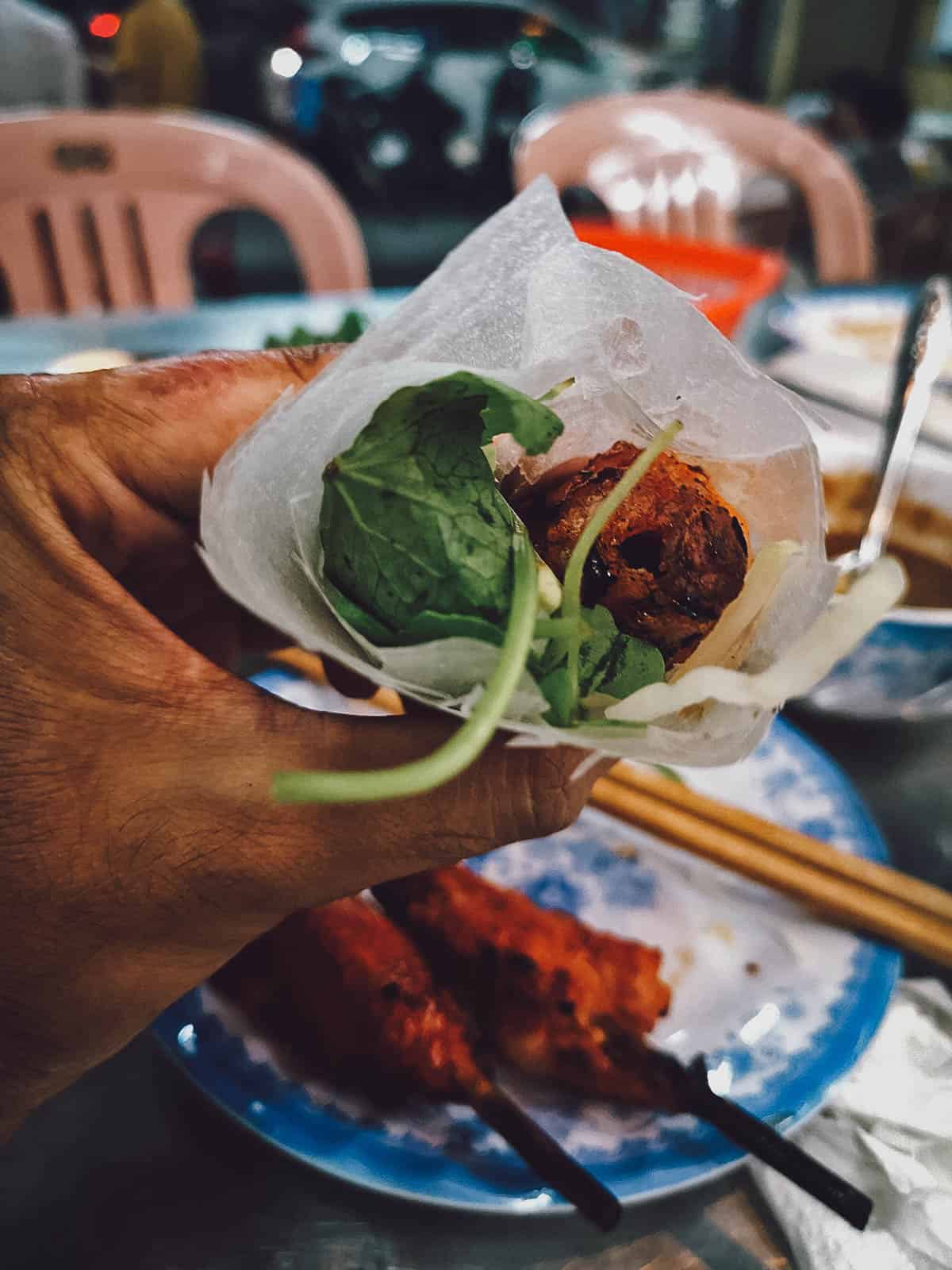
Here’s my roll of nem lui dripping in peanut sauce and ready to go down the hatch. Ren and I had nem nuong in Hoi An which seems to be a very similar dish. Not exactly sure what the differences are. In the seasoning of the meat perhaps?
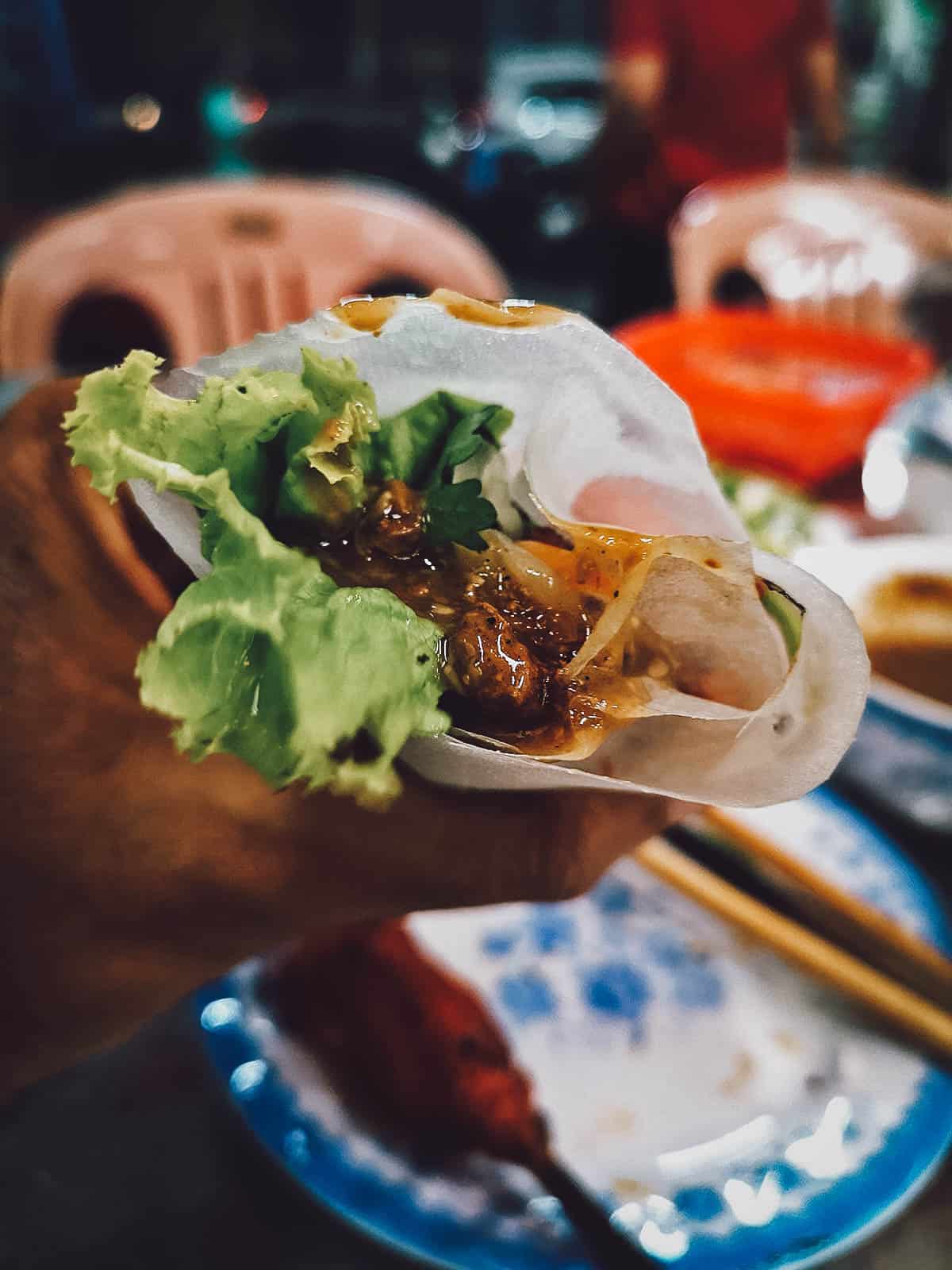
I googled “where to have the best nem lui in Hue” and Tai Phu would often come up. I only had nem lui twice in Hue and theirs was by far the better one.
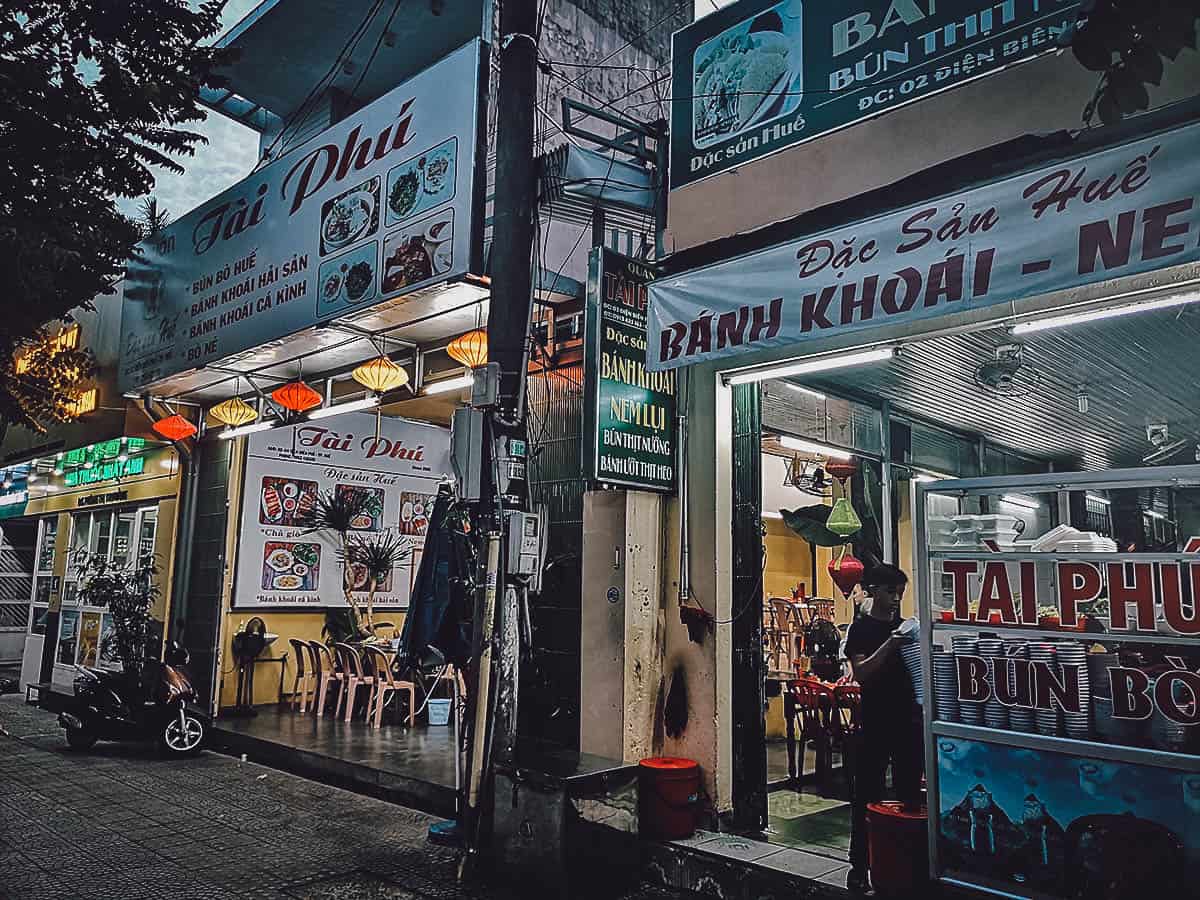
Tai Phu
Address: 02 Điện Biên Phủ, Vĩnh Ninh, Thành phố Huế, Thừa Thiên Huế, Vietnam
Operating Hours: 7:15AM-10:05PM, daily
What to Order: Nem lui
Expect to Pay: VND 120,000 (for two)
10. Lac Thien
If you’ve had banh xeo in Hoi An or Saigon and enjoyed it, then chances are you’re going to like banh khoai too. It’s basically a much crunchier version of banh xeo. Like, way crunchier.
It was clear from my research that Lac Thien was one of the most popular restaurants in Hue, known for many dishes including banh khoai.
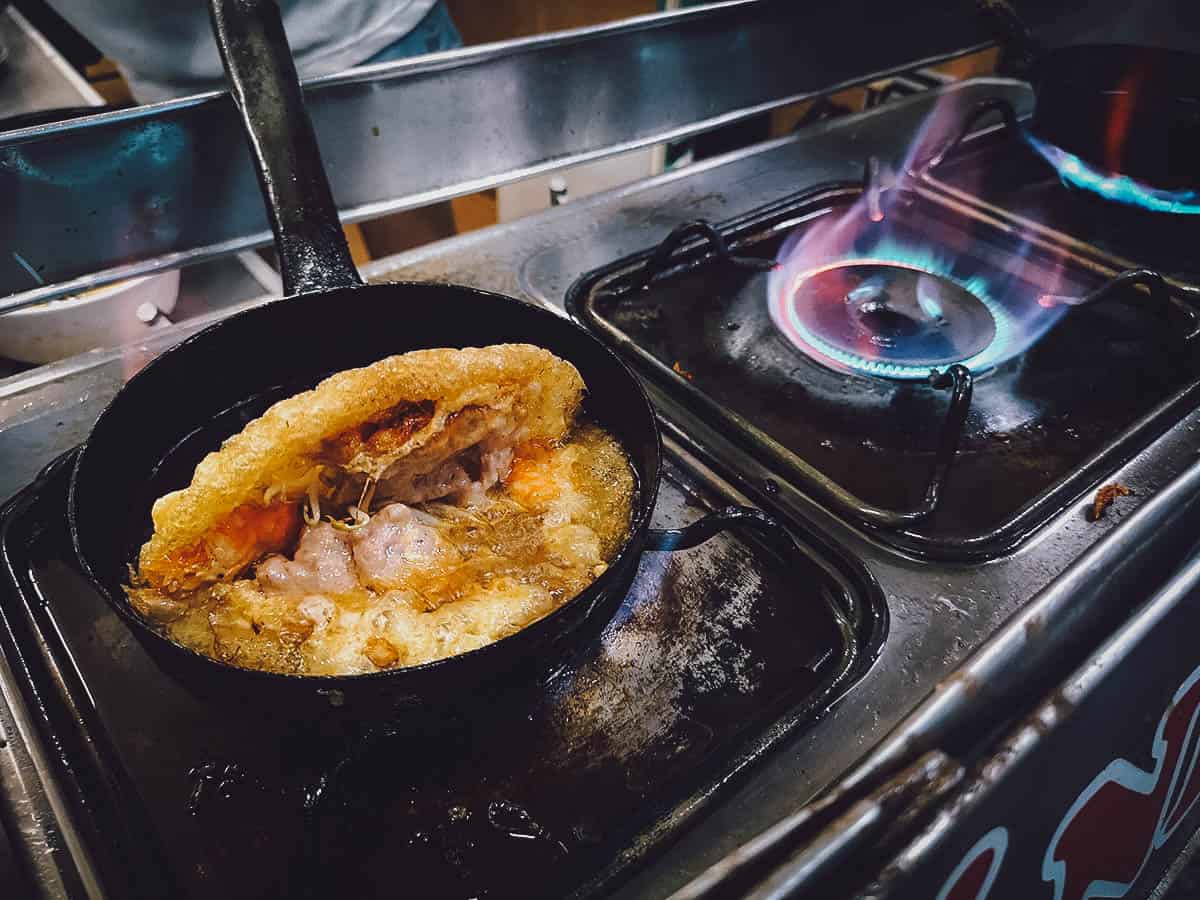
Like banh xeo, banh khoai is a rice flour and turmeric crepe typically filled with pork, shrimp, scallions, and beansprouts. Like many fried Vietnamese dishes, it’s served with a side of fresh leafy greens, herbs, and perhaps a few slices of star fruit or young banana, along with a fermented soybean (salty hoisin) dipping sauce.
Banh khoai is about the same size as a central Vietnamese banh xeo but as described, a whole lot crunchier, probably because of the addition of soda water to the batter. Another difference is that banh xeo is served with nuoc cham instead of a hoisin sauce. The banh xeo we had in Hoi An was also meant to be wrapped in rice paper but this banh khoai was served as is. I enjoyed both equally.
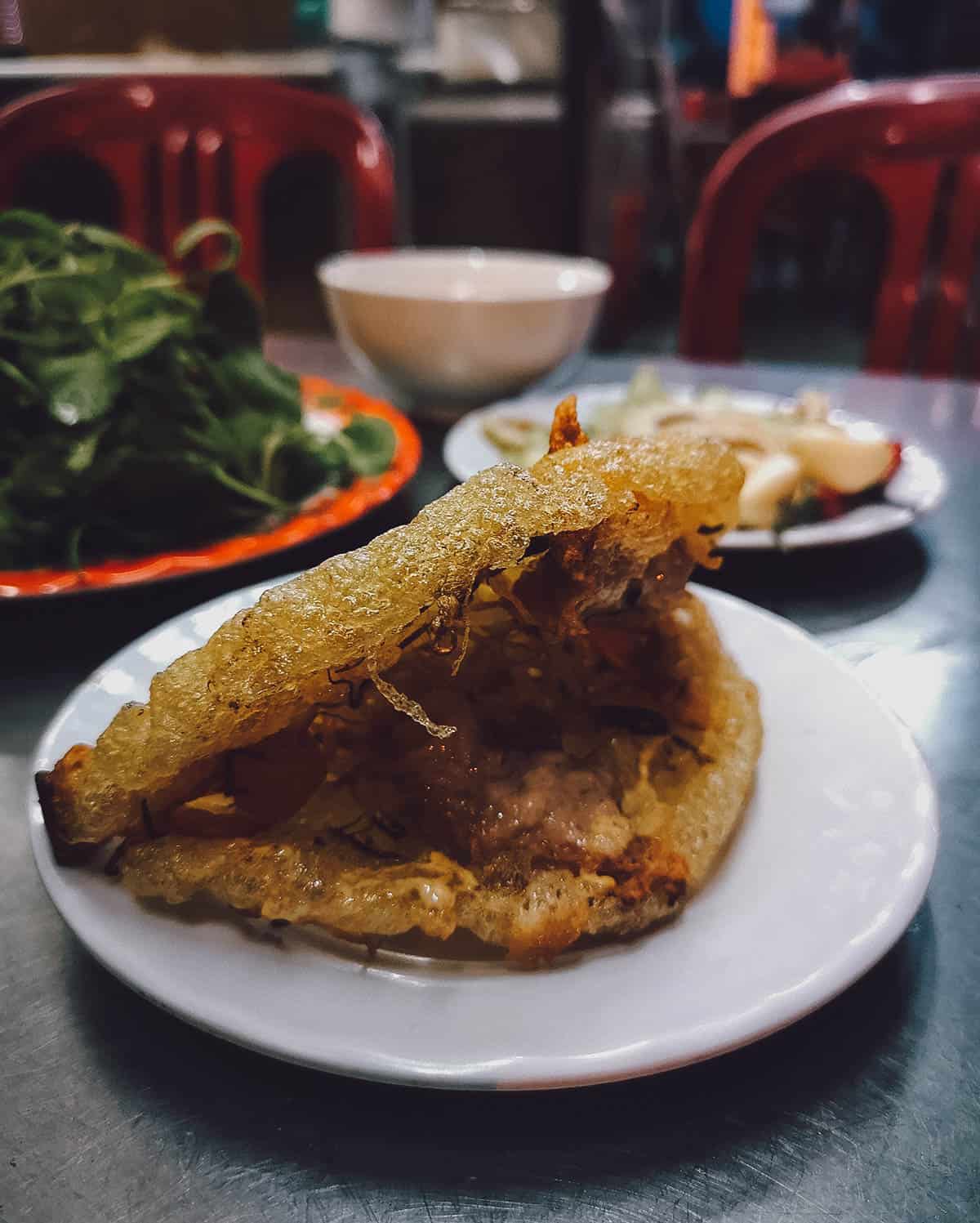
I read Lac Thien’s banh beo was pretty good so I had that as well. It was good though I think I preferred Hang Me’s version.
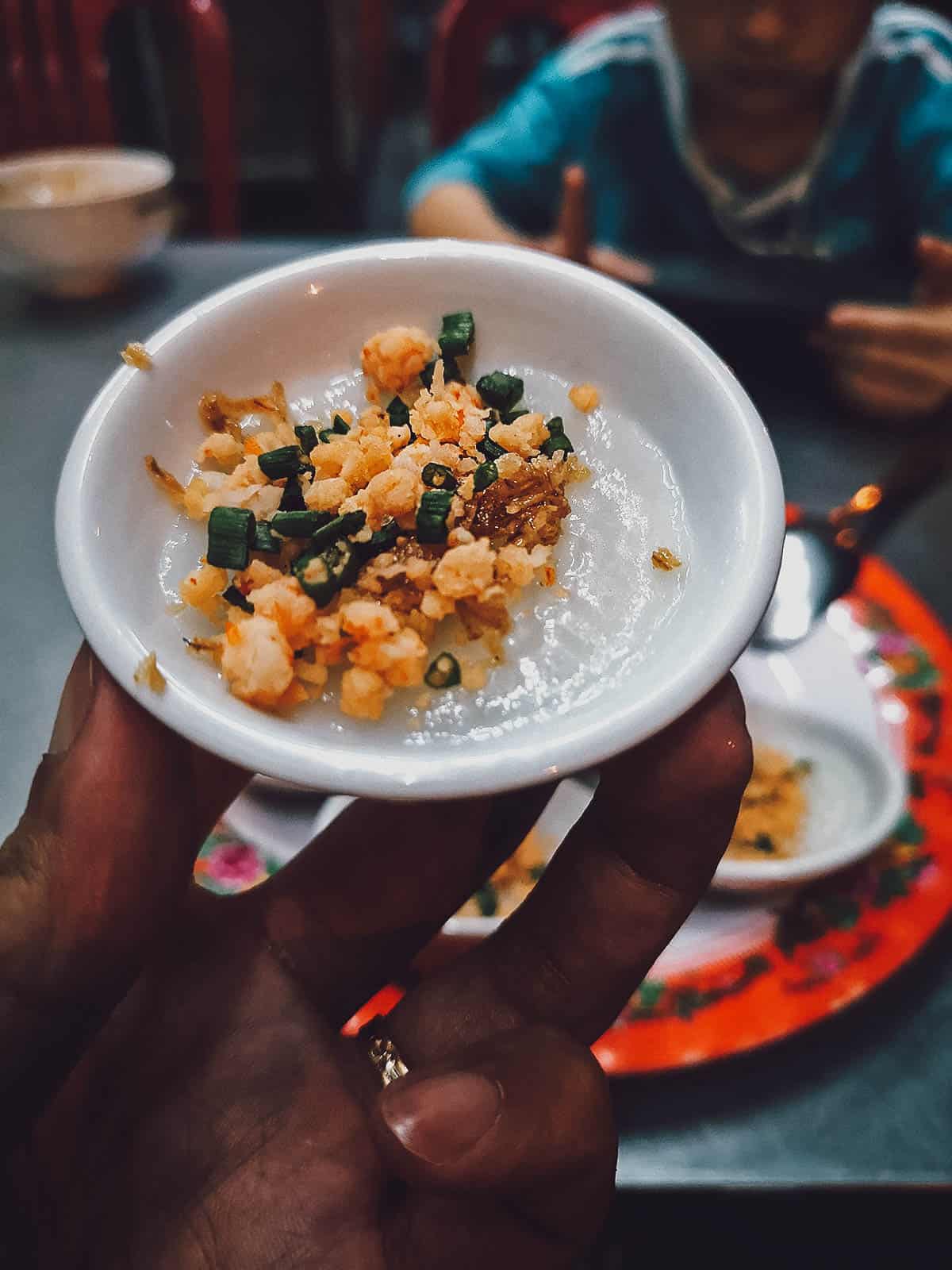
Lac Thien is a TripAdvisor Certificate of Excellence awardee with a near perfect 4.5 star rating. The restaurant is located near the Imperial City making it a great place to have lunch or dinner after touring the walled city. They serve many other dishes as well like bun bo, nem lui, and other types of banh hue.
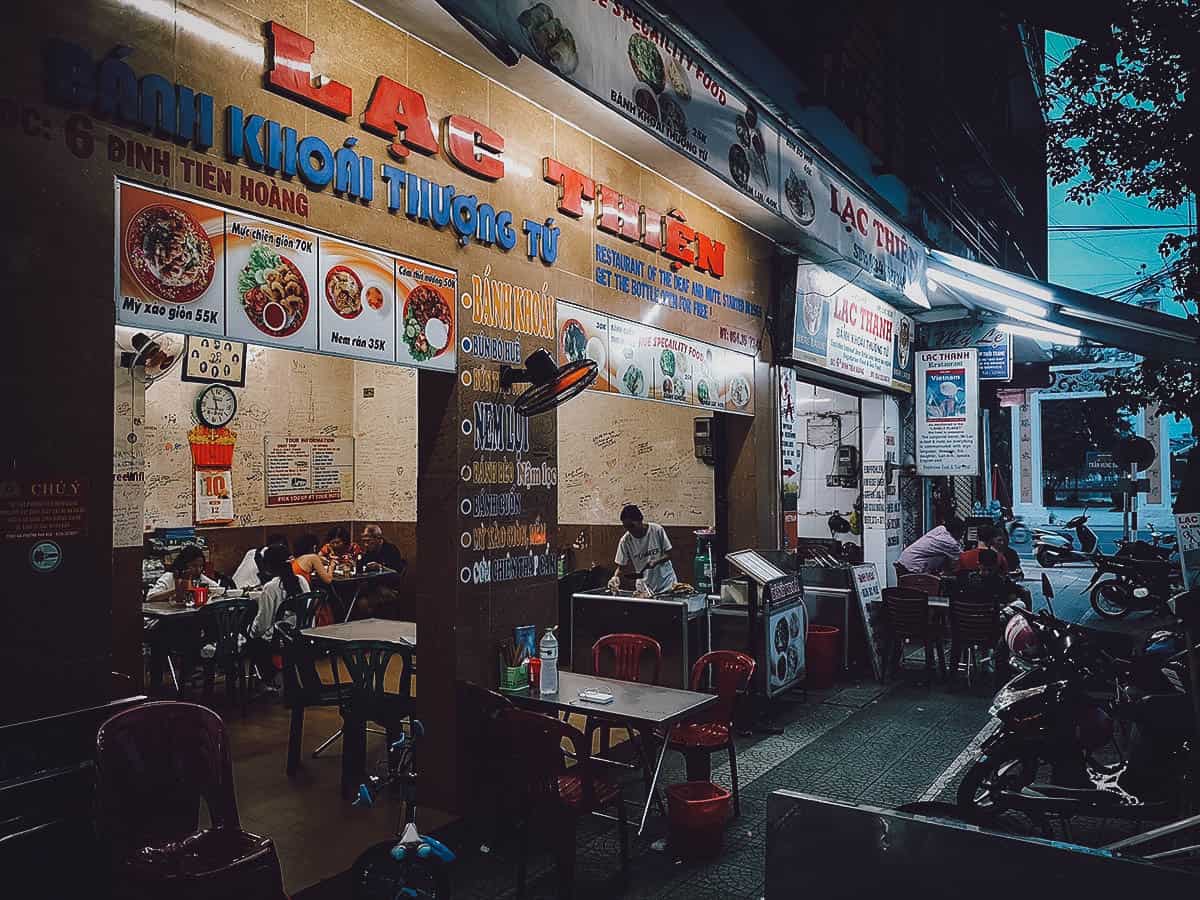
Lac Thien
Address: 6 Đinh Tiên Hoàng, Phú Hoà, Thành phố Huế, Thừa Thiên Huế, Vietnam
Operating Hours: 10AM-9:30PM, daily
What to Order: Banh khoai
Expect to Pay: VND 25,000 per order
11. Banh Canh Cua Roi Huong
We were introduced to this bowl of heavenly deliciousness known as banh canh in Hoi An by our My Son Sanctuary guide in 2017. I never forget it so when I read about this banh canh place in Hue, I made sure to leave some stomach space for it.
I don’t believe banh canh is necessarily associated with Hue or central Vietnam, but it’s a type of noodle soup made with thick tapioca or tapioca-rice flour noodles. There are several types of banh canh, but what I had today was this stunningly beautiful bowl of banh canh cua made with crab.
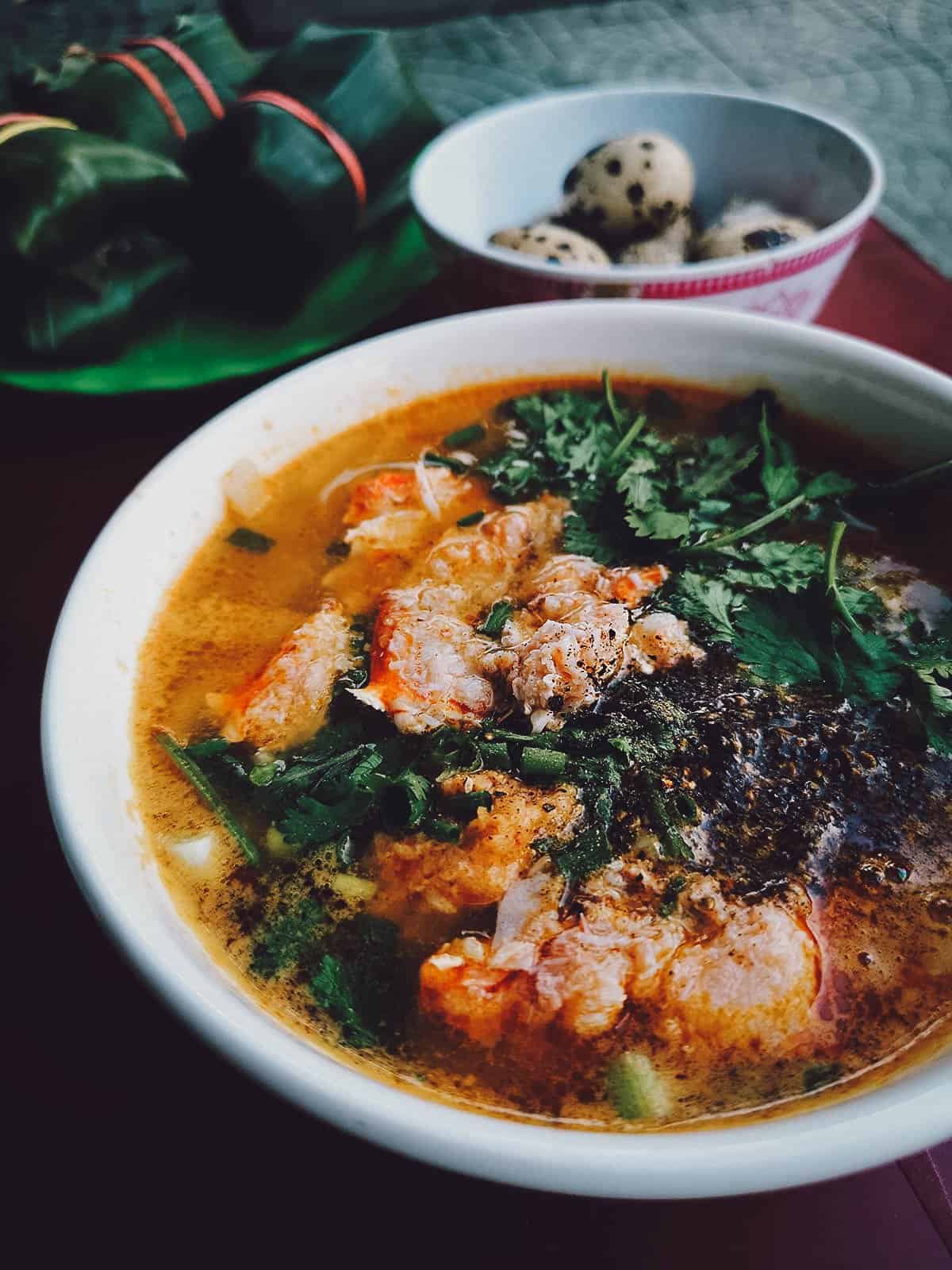
Have you ever seen a more beautiful sight? Crab is one of my favorite dishes which is why I was so excited to have this dish. I enjoy banh canh for the chewiness and texture of its thicker noodles. It reminds of Japanese udon.
As beautiful as this bowl of banh canh cua looks, it wasn’t as good as the banh canh we had in Hoi An in 2017. The noodles and crab were great but I found it to be a little too spicy. I adore spicy food and have a high tolerance for it but I felt the spice in this one drowned out the flavors of the broth a bit. That may have been partly my fault because I added even more chili to the dish. Whoops!
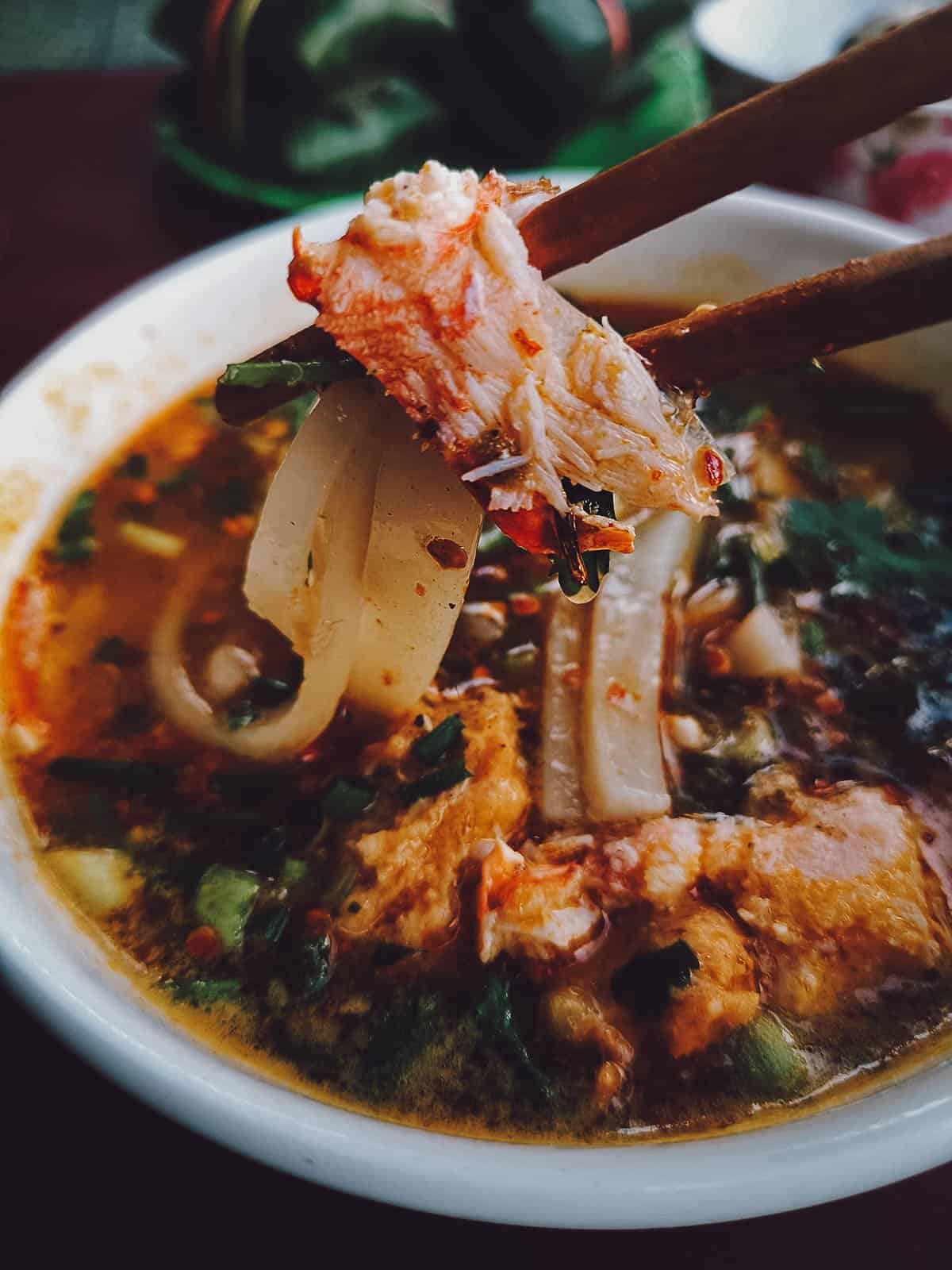
If you like crab and have never tried banh canh, then you may want to have a bowl at Banh Canh Cua Roi Huong.
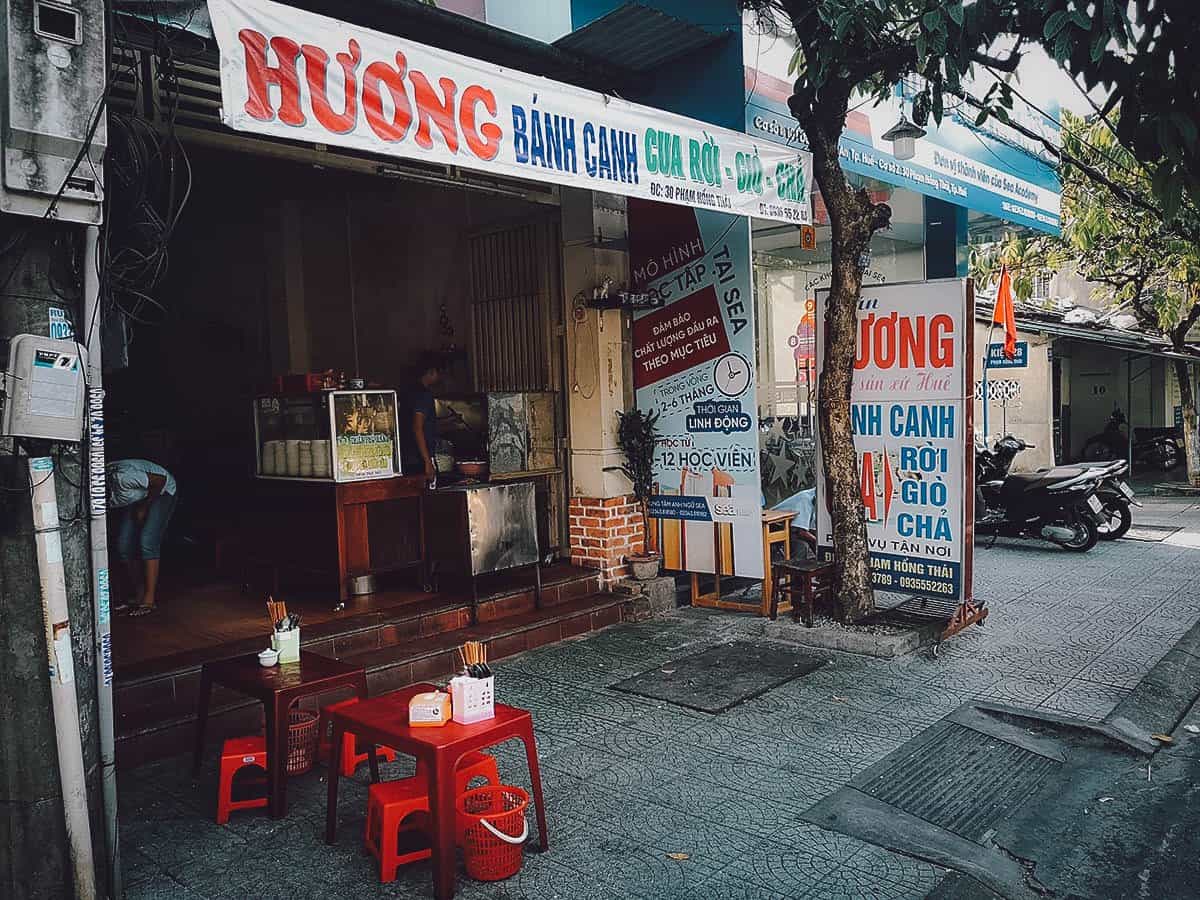
Banh Canh Cua Roi Huong
Address: 30 Phạm Hồng Thái, Vĩnh Ninh, Thành phố Huế, Thừa Thiên Huế 530000, Vietnam
Operating Hours: 6AM-10PM, daily
What to Order: Banh canh cua
Expect to Pay: VND 25,000 per bowl
12. Hanh Restaurant
I was excited to eat at Hanh Restaurant because of its stellar reviews. It’s a TripAdvisor Certificate of Excellence awardee with a stellar 4.5 star rating even after almost 2,000 reviews. They offer these set meals featuring some of the best Hue regional delicacies like banh beo, banh khoai, nem lui, banh cuon thit nuong, and nem ran.
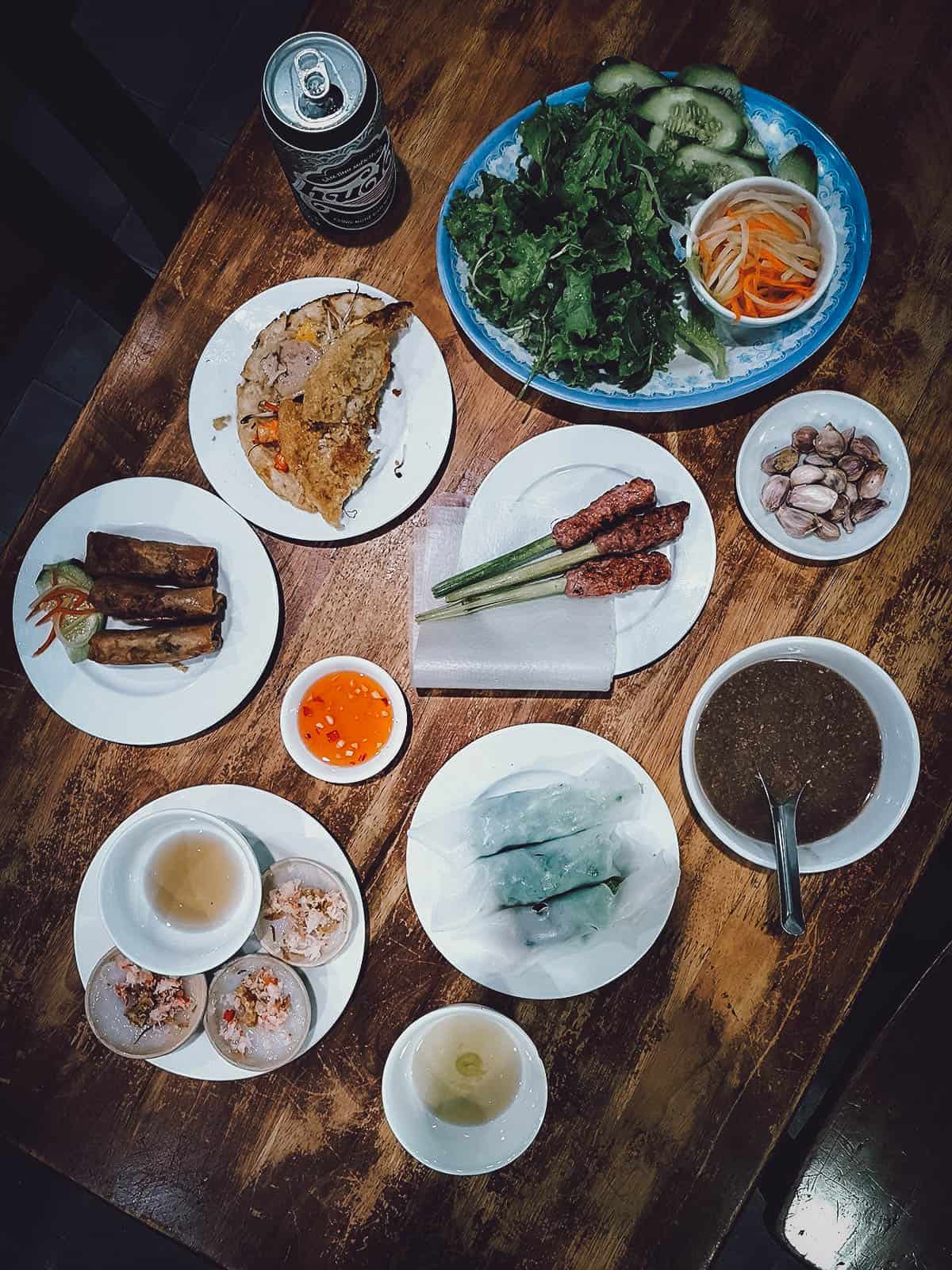
If I hadn’t already eaten these individual dishes on my own, then I would have loved this set menu. Many of Hue’s must-try regional dishes are here in one place. Everything at Hanh was pretty good, but just not as good as the experiences I had at the different restaurants listed above.
The banh beo was perhaps not as robust in flavor, the nem lui not as smokey, and the banh khoai dipping sauce not as nuanced in flavor. All those reviewers can’t be wrong so I may be in the minority with this, but if you have time to try each of these dishes at different restaurants, then I suggest doing that. Otherwise, this set menu at Hanh gives you a decent and convenient introduction to Hue regional cuisine.
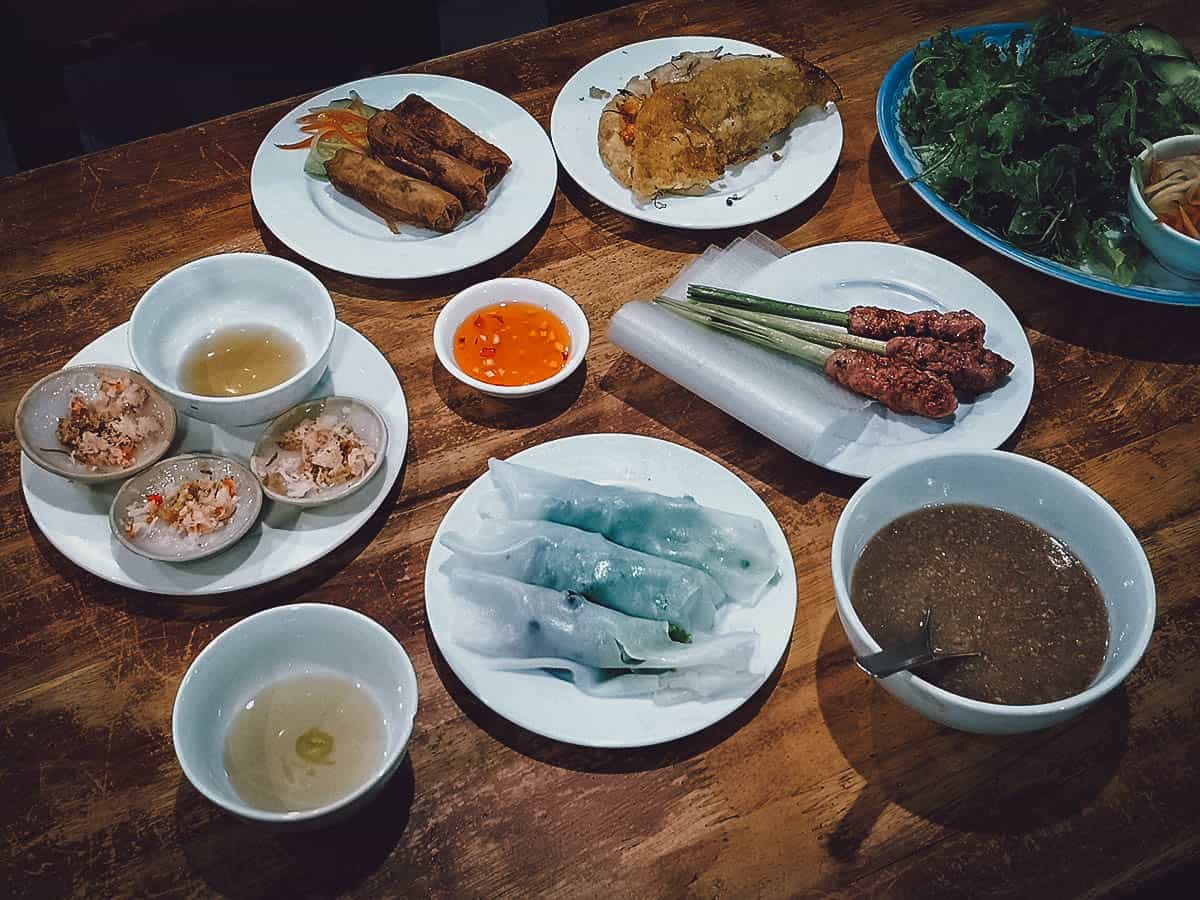
Based on its number of reviews, Hanh seems to be one of the most popular restaurants in Hue. It was packed when I was there with a good mix of locals and tourists.
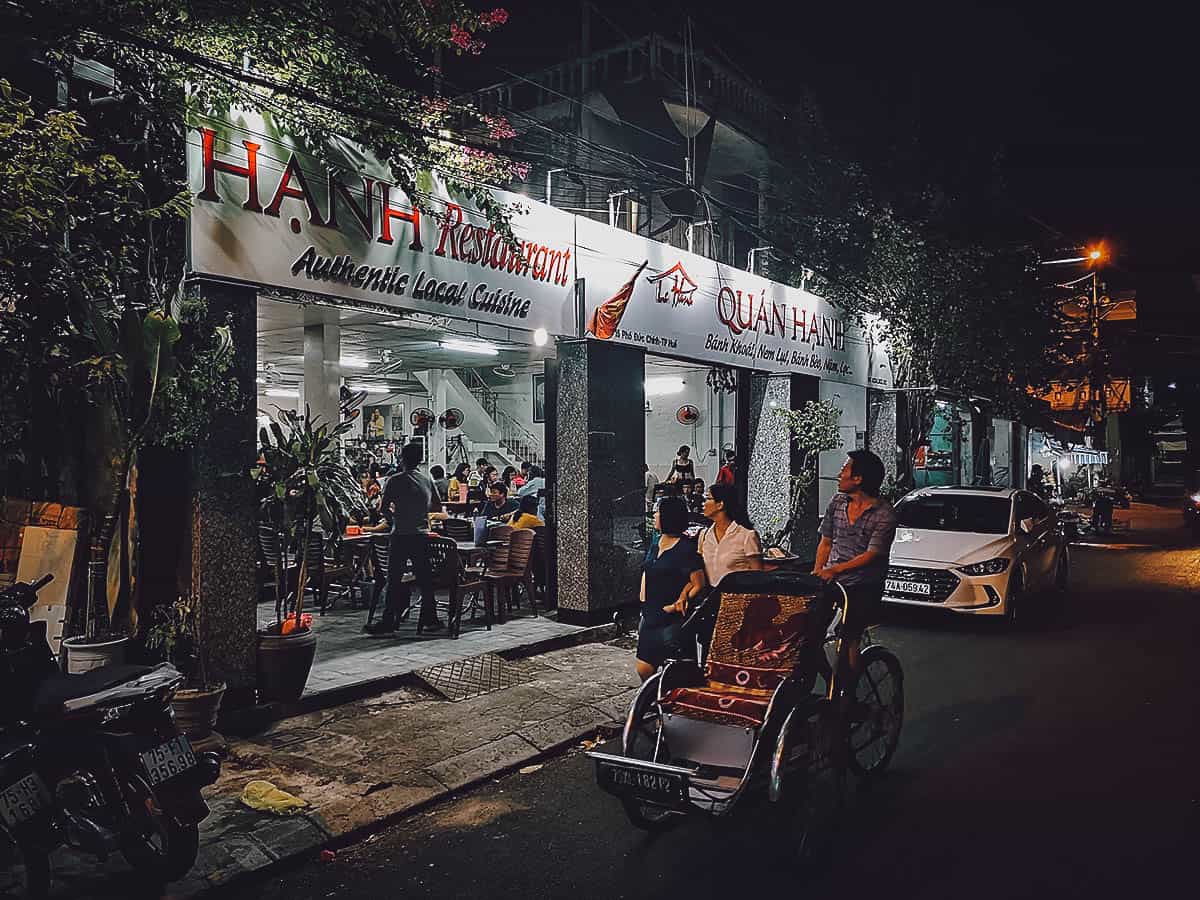
Hanh Restaurant
Address: 11 Đường Phó Đức Chính, Phú Hội, Tp. Huế, Phú Hội, Vietnam
Operating Hours: 9AM-9:30PM, daily
What to Order: Set menu
Expect to Pay: VND 120,000 per person
13. Quan 20 – Banh Ep Nguyen Du
I learned about this interesting trio of snacks from one of my favorite travel food bloggers – Jodi Ettenberg of Legal Nomads.
I was drawn to this interesting-sounding dish called banh ep which is a small disc of tapioca or cassava dough topped with pork and egg and flattened on a griddle. It’s sprinkled with chopped scallions and served with herbs, pickled vegetables, and nuoc cham. Like a thick tortilla, it’s soft and quite chewy.
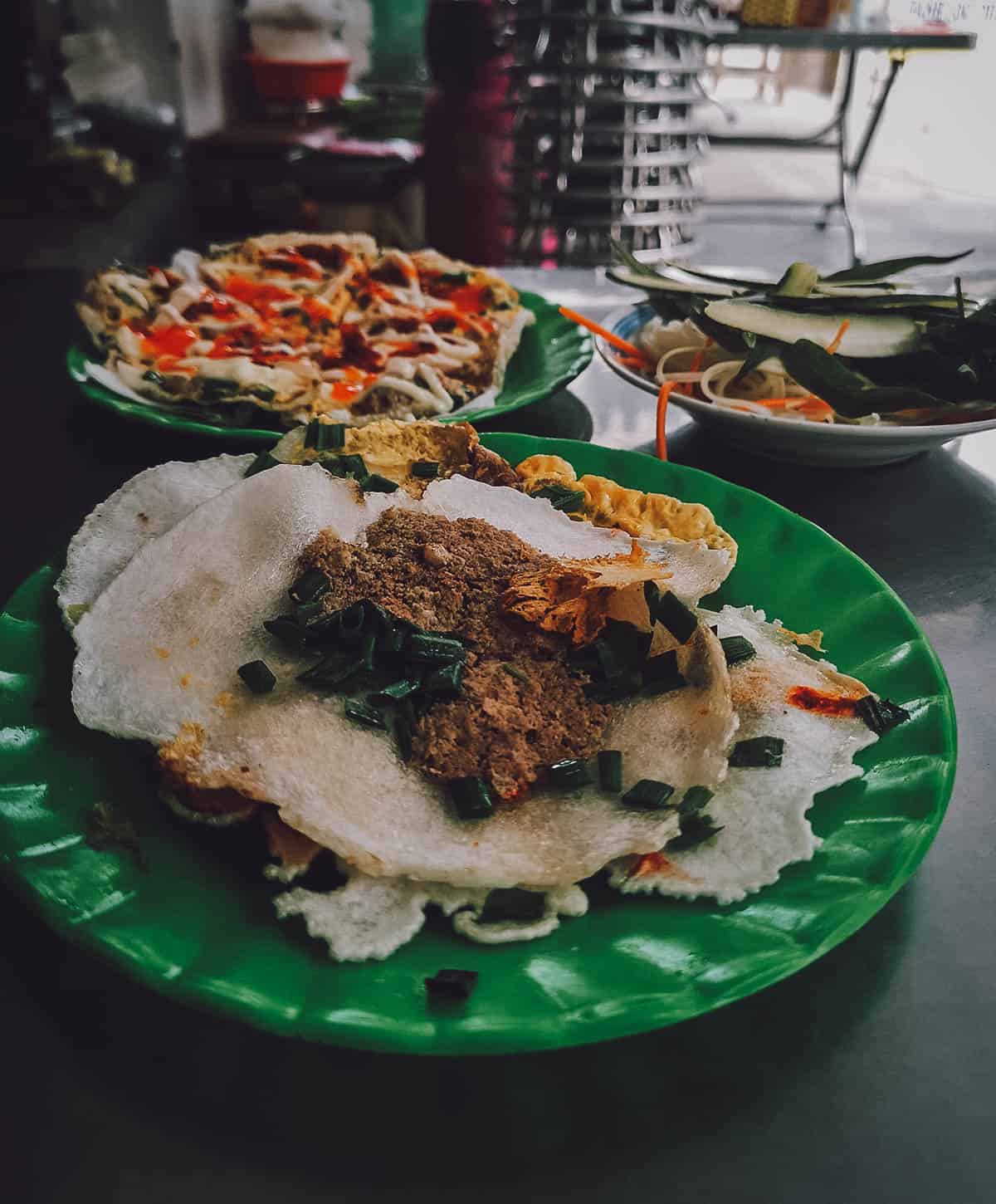
This next dish is called banh trang trung. It’s a form of Vietnamese pizza made with grilled rice paper topped with egg, green onion, and any number of ingredients like pork, beef, or chicken. It was nice and crunchy and my favorite among the three snacks I had here today. You can think of it as a pizza-like dish on a crisp, eggy cracker.
I had a similar dish in Saigon called banh trang nuong. According to Jodi, the main difference is in the egg. In southern Vietnam, they use a small quail egg while in Hue a much bigger chicken egg is poured over the pizza.
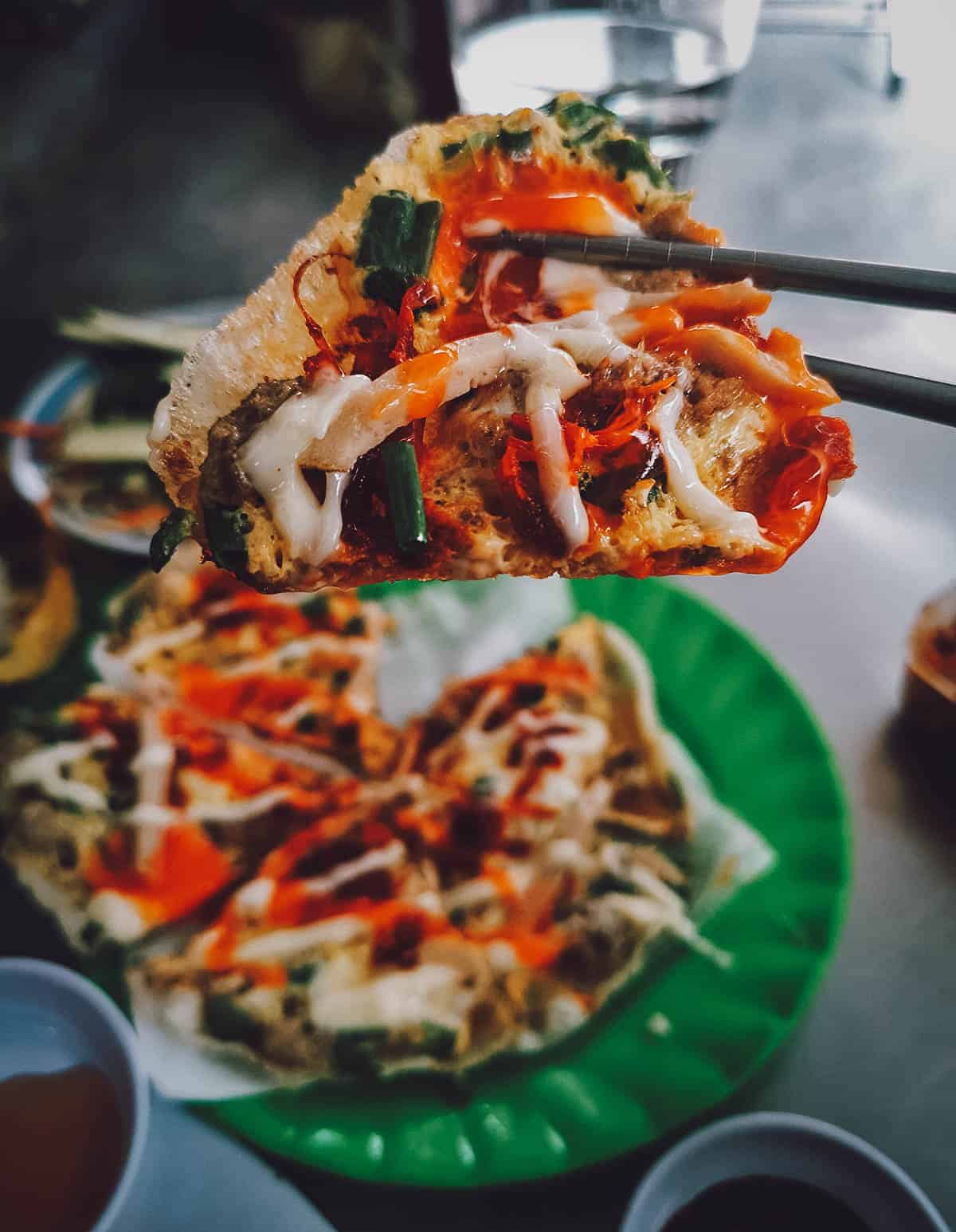
This third dish is called banh loc chien. It appears to be made with deep-fried tapioca flour, at the center of which is a seasoned pork and shrimp mixture. It’s served with a vinegar-based sweet and sour dipping sauce.
I don’t know if they’re meant to be like this but the ones I had were hard and quite chewy. This was easily my least favorite of the three.
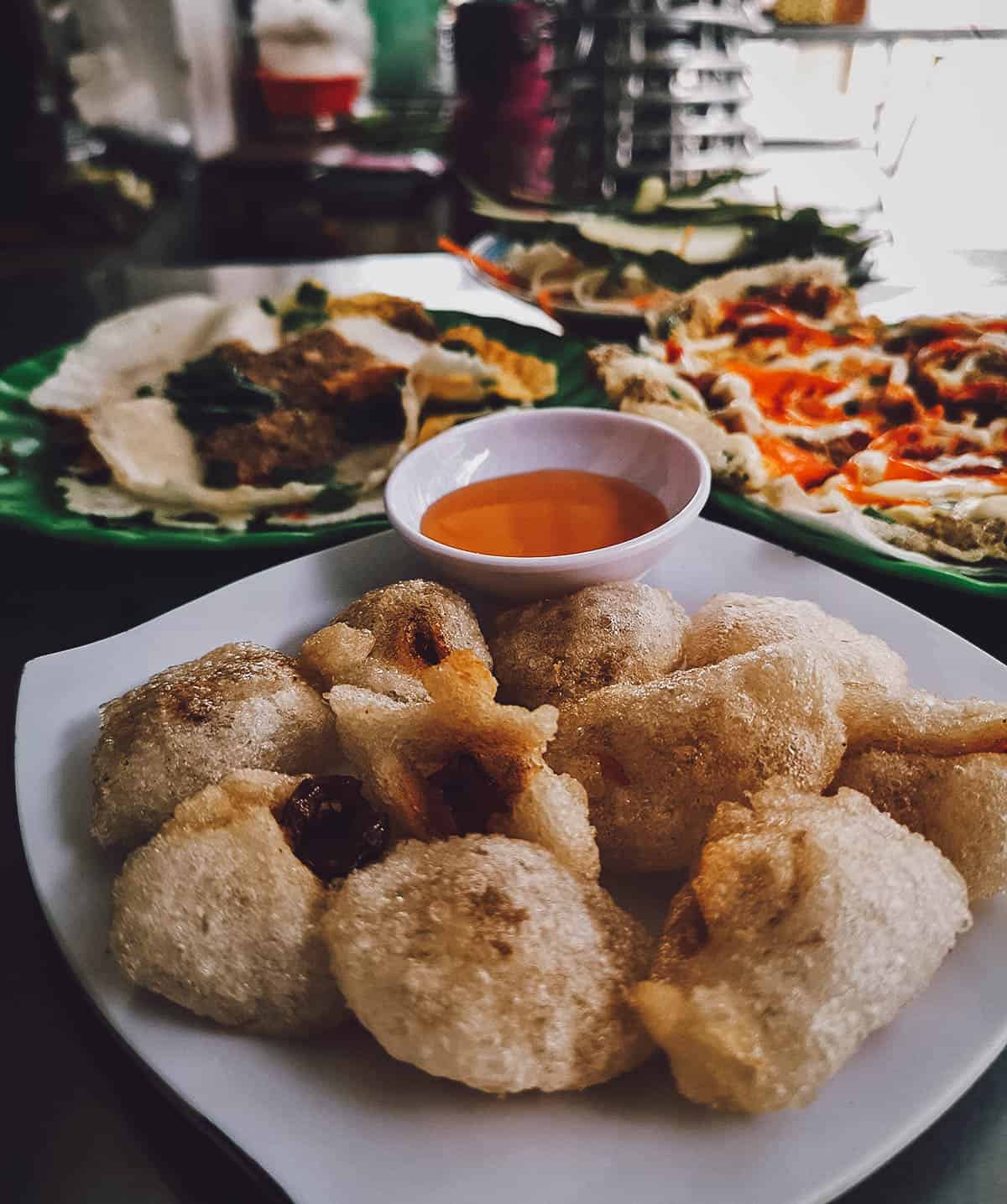
Based on what I’ve read, banh ep is popular mainly with kids. It can be found throughout the city but one street in particular seems to be known for it – Nguyen Du Street. There seem to be a few schools in the neighborhood which is why you’ll find a few stalls selling these same three dishes. I ate at the first stall I could find.
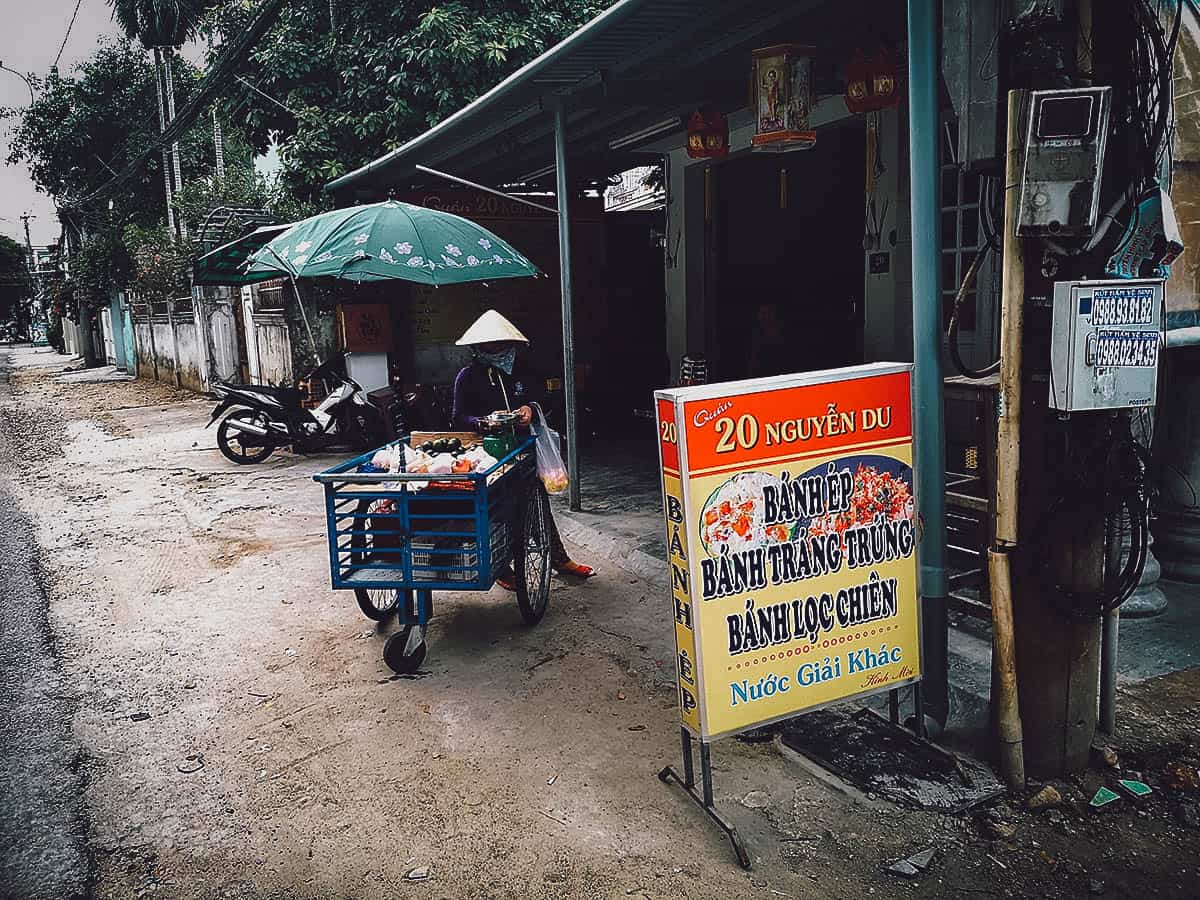
Quan 20 – Banh Ep Nguyen Du
Address: 20 Nguyen Du, Tp. Hue, Hue, Vietnam
Operating Hours: 4-10PM, daily
What to Order: Banh ep, banh trang trung, banh loc chien
Expect to Pay: VND 10,000 per order of each dish
14. Ancient Hue Garden Houses
When I first heard about Hue’s royal cuisine, I thought it pertained to everyday dishes like banh beo which were originally created in the imperial kitchen. While many of Hue’s popular dishes may indeed have been originally developed for Vietnamese royalty, the term “imperial cuisine” refers to a set menu of about eight or nine dishes meant to recreate the royal dining experience.
I love Vietnamese street food so I’m perfectly happy with dishes like bun bo and bun hen, but I couldn’t write a Hue food guide without including this imperial dining experience. I did my research and every place I found that offered imperial cuisine had terrible reviews, all except for one – Ancient Hue Garden Houses.
Their set menu was by far the most expensive – at least double of every other restaurant I found – but I figured this was the one and only time I’d be doing it so why not go for the best. I bit the bullet and made a reservation at Ancient Hue Garden Houses, which also happens to be one of the nicer resorts in Hue.
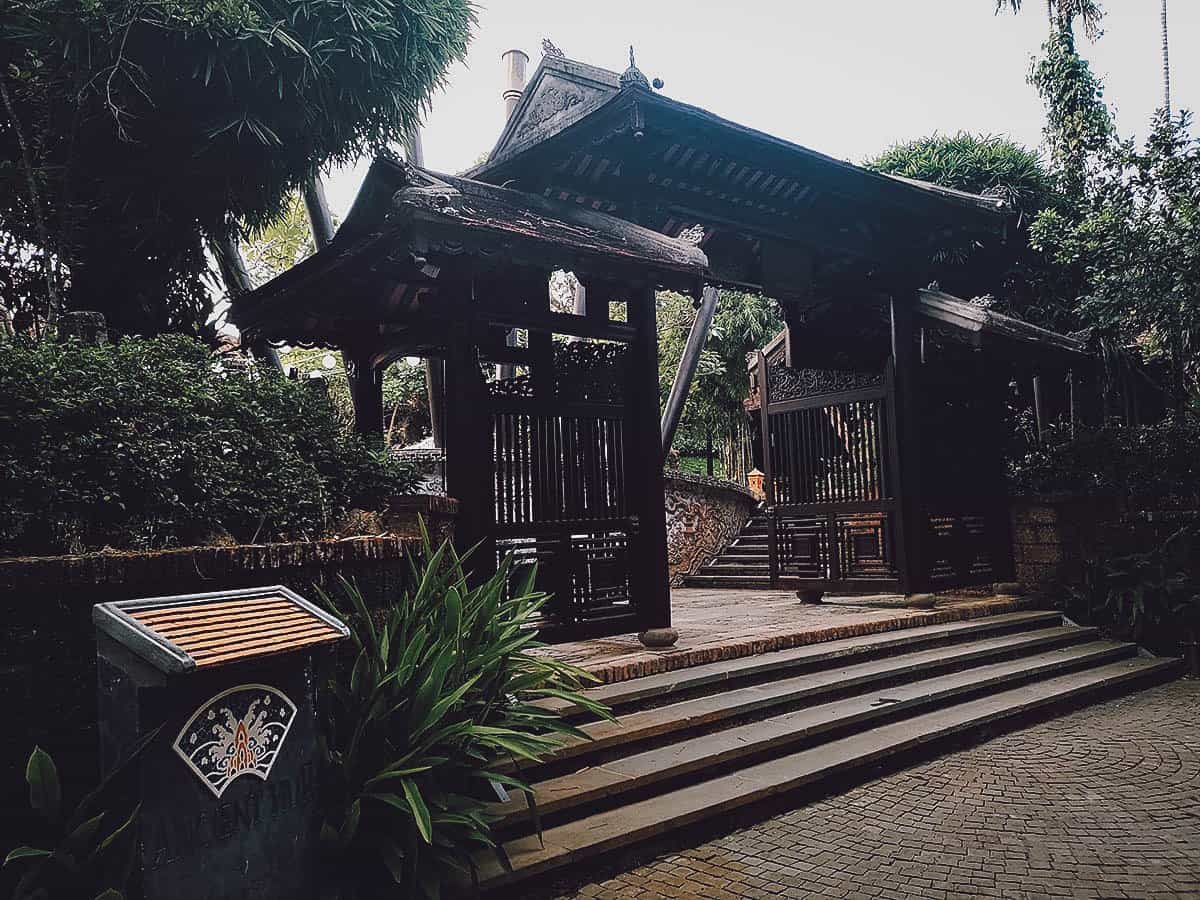
You certainly get what you pay for. The other restaurants I found were mostly in cheaper- and kitschier-looking hotels. Ancient Hue Garden Houses is a beautiful resort with an elegant restaurant in a more secluded, heavily wooded area west of the Imperial City.
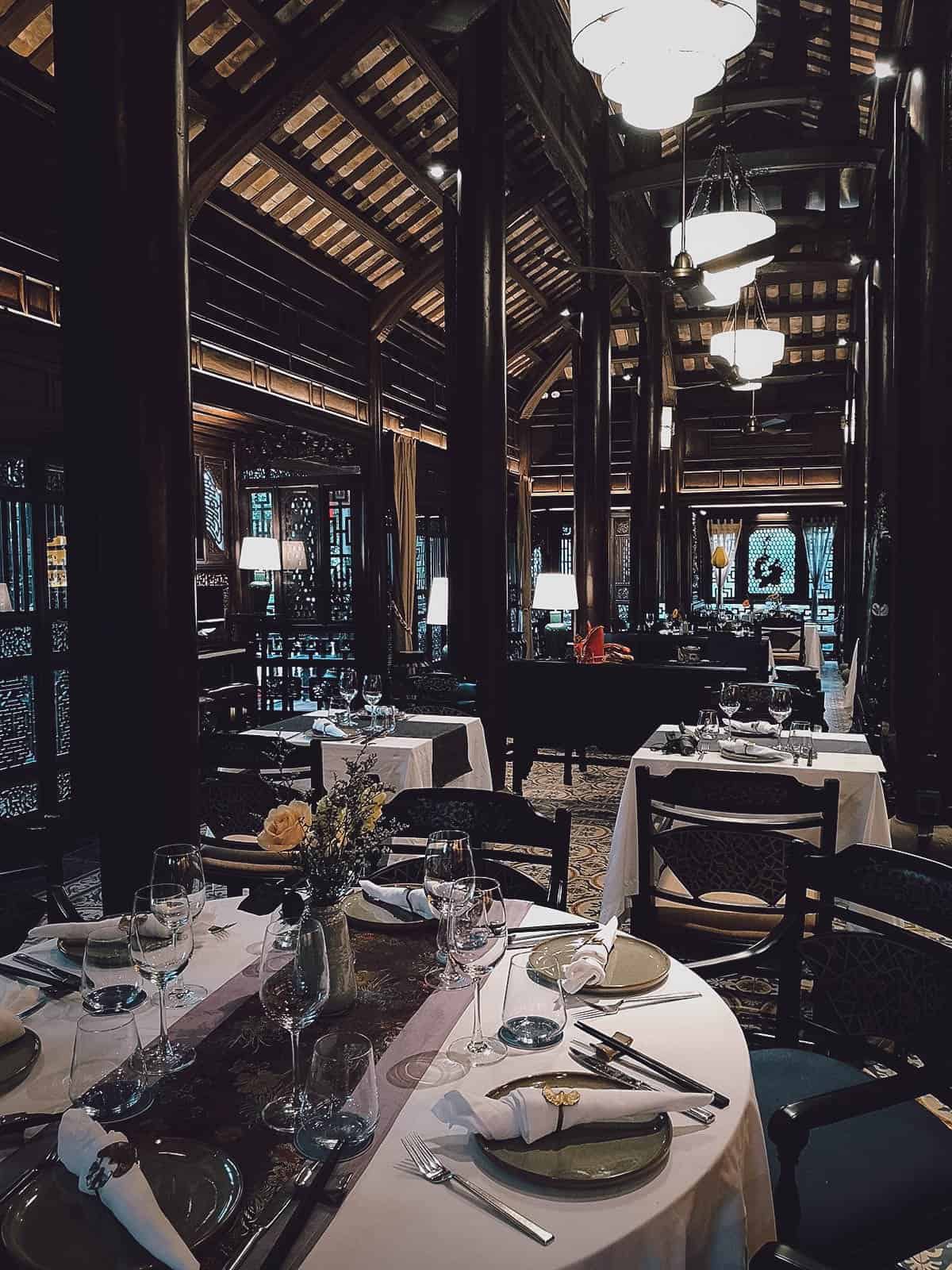
As you can see, presentation is definitely a priority. Many of the courses are decorated with these elaborate carvings of animals meant to impress and amuse. This was a dish of tender and juicy grilled beef wrapped around a stalk of green onion.
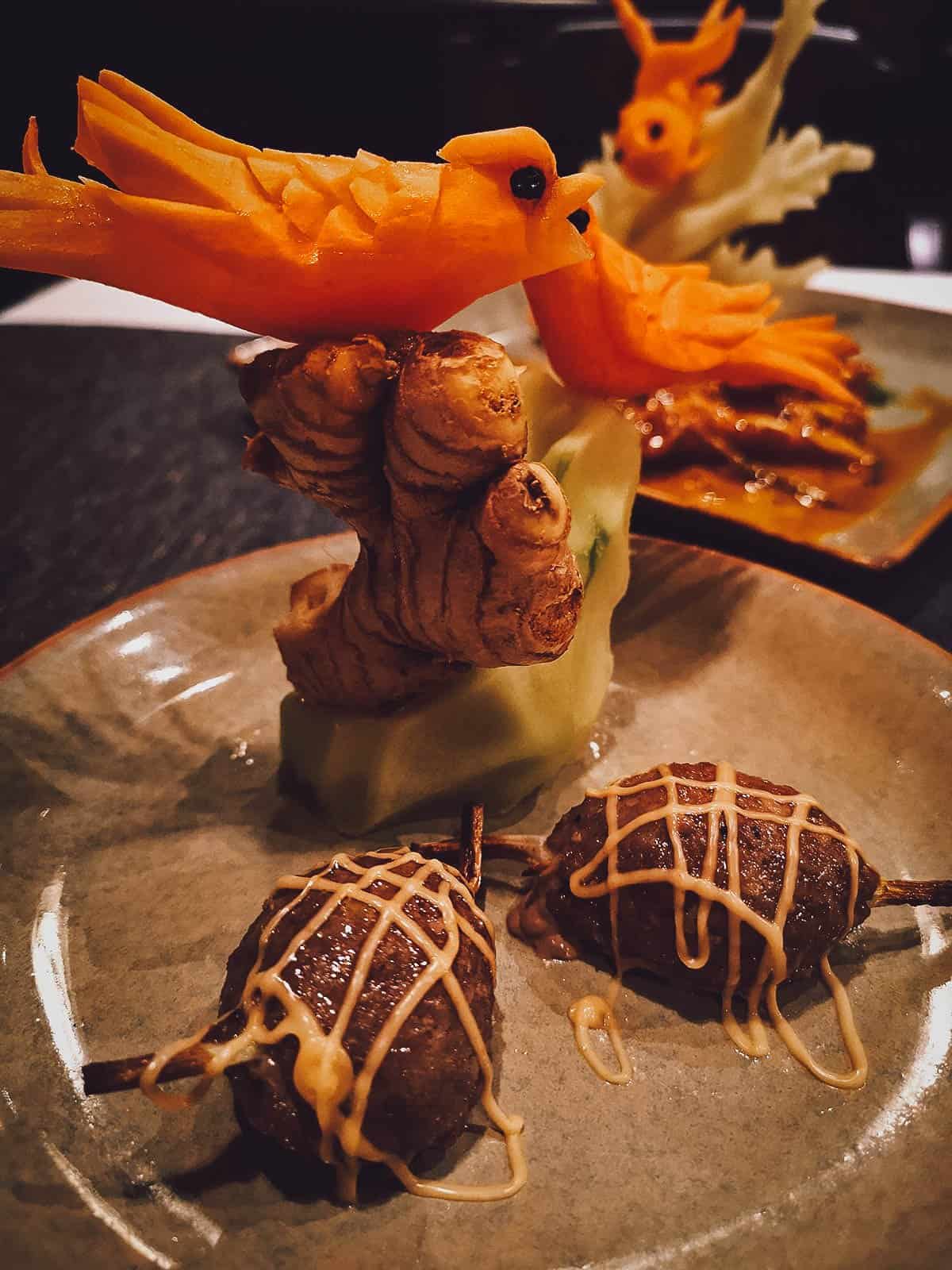
This dish was an appetizer of fried shrimp on a crunchy “flower boat”. This was one of my favorite courses from tonight’s set menu. The shrimp was doused in some type of sweet mango sauce.
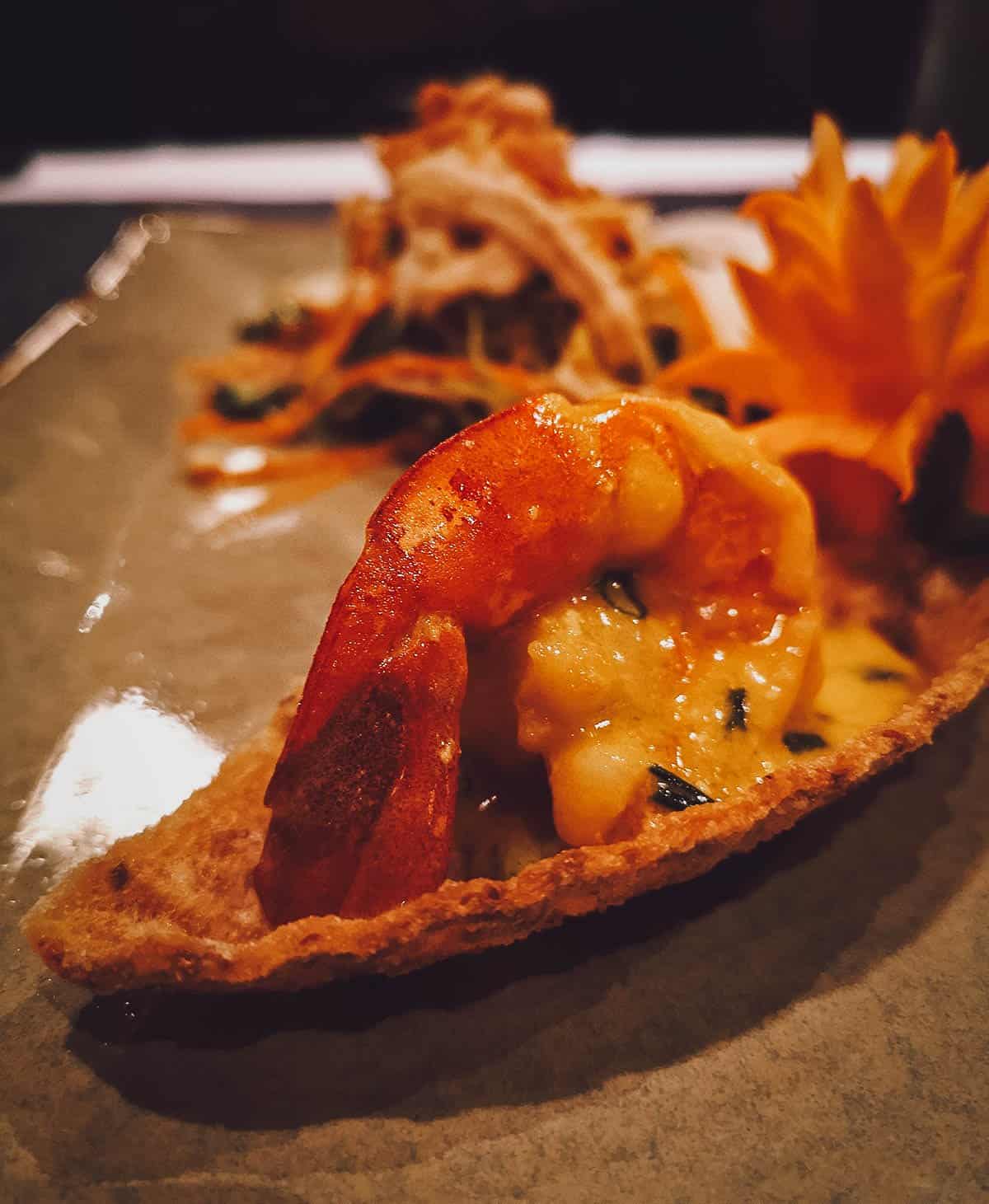
This was a Chinese mushroom soup made with seafood. It had perfectly cooked shrimp, egg, sweet corn, and other tasty ingredients.
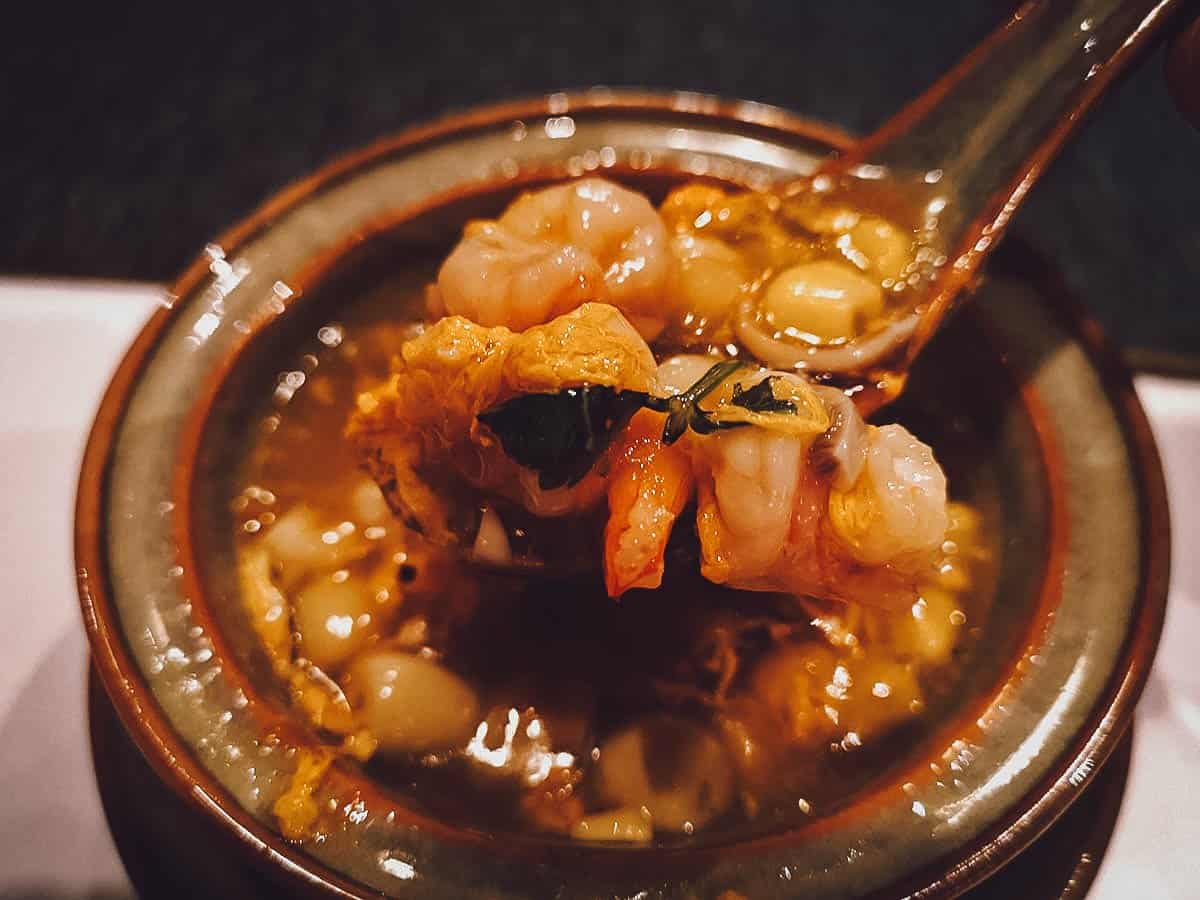
This was one of three main courses – a tender and succulent fillet of fish doused in a robust and orange-y sweet and sour sauce.
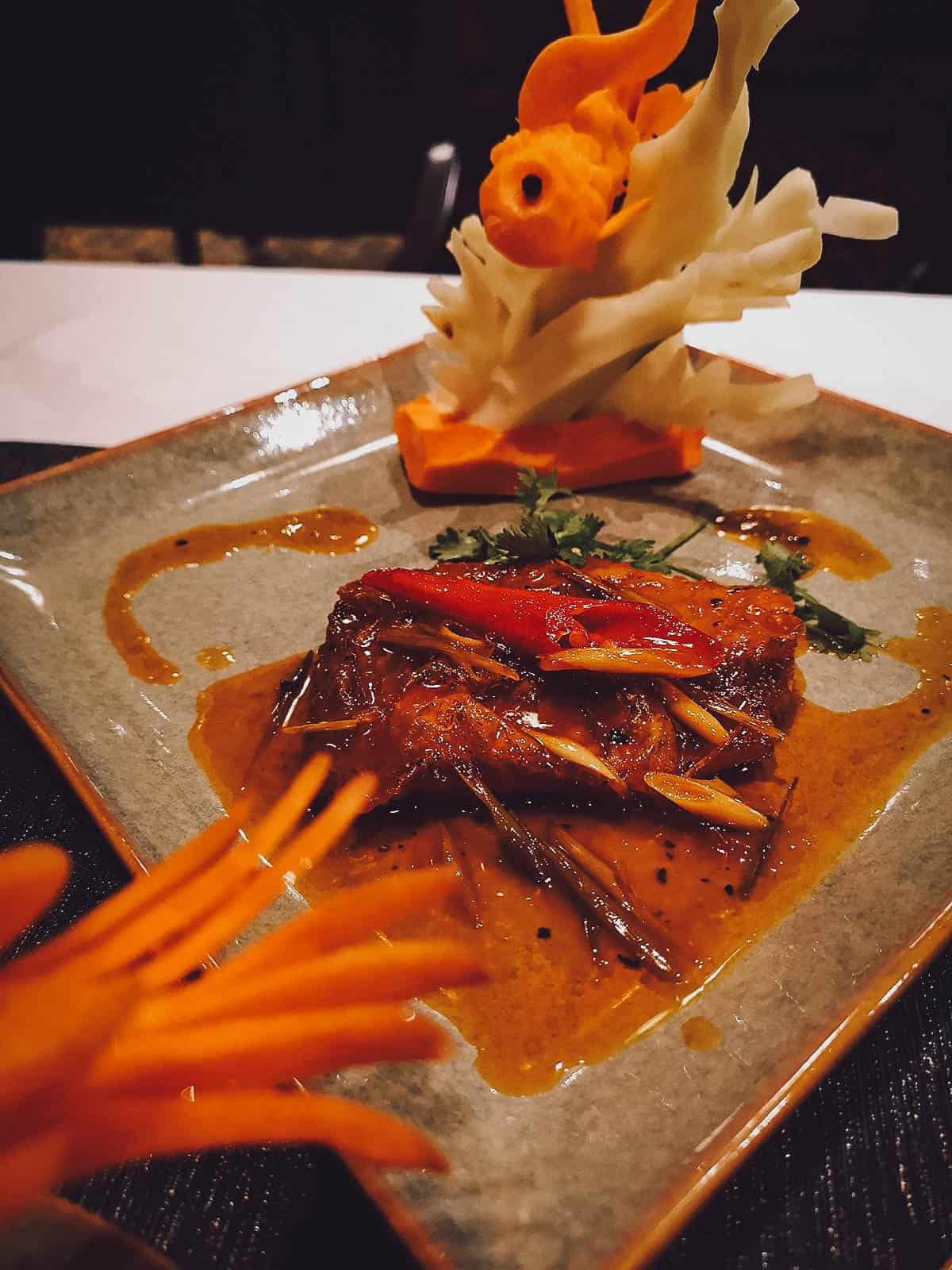
How dorky do I look? I wasn’t sure I was going to do this, but I figured if I were to do this imperial dinner, then I may as well go all the way. I look like a tool. Ha!
In all seriousness, other than the price, part of the reason why I hesitated doing this was because of this costume. Many people were wearing them in reviews so it made me question the authenticity of the experience. Was this a meal designed exclusively for tourists? Perhaps, but I don’t regret doing it.
The food was good, the ambiance even better, and it gave me the chance to sit down to a nice meal after all the street food I had been eating in Vietnam. Would I do it again? Definitely not. The food was tasty but in my opinion, not good enough to merit a second go around, especially considering the price.
If you’re in the market for a more extravagant dining experience, then you may be interested in this imperial set menu at Ancient Hue Garden Houses. By all accounts, it seems to be the best place to have it in Hue.
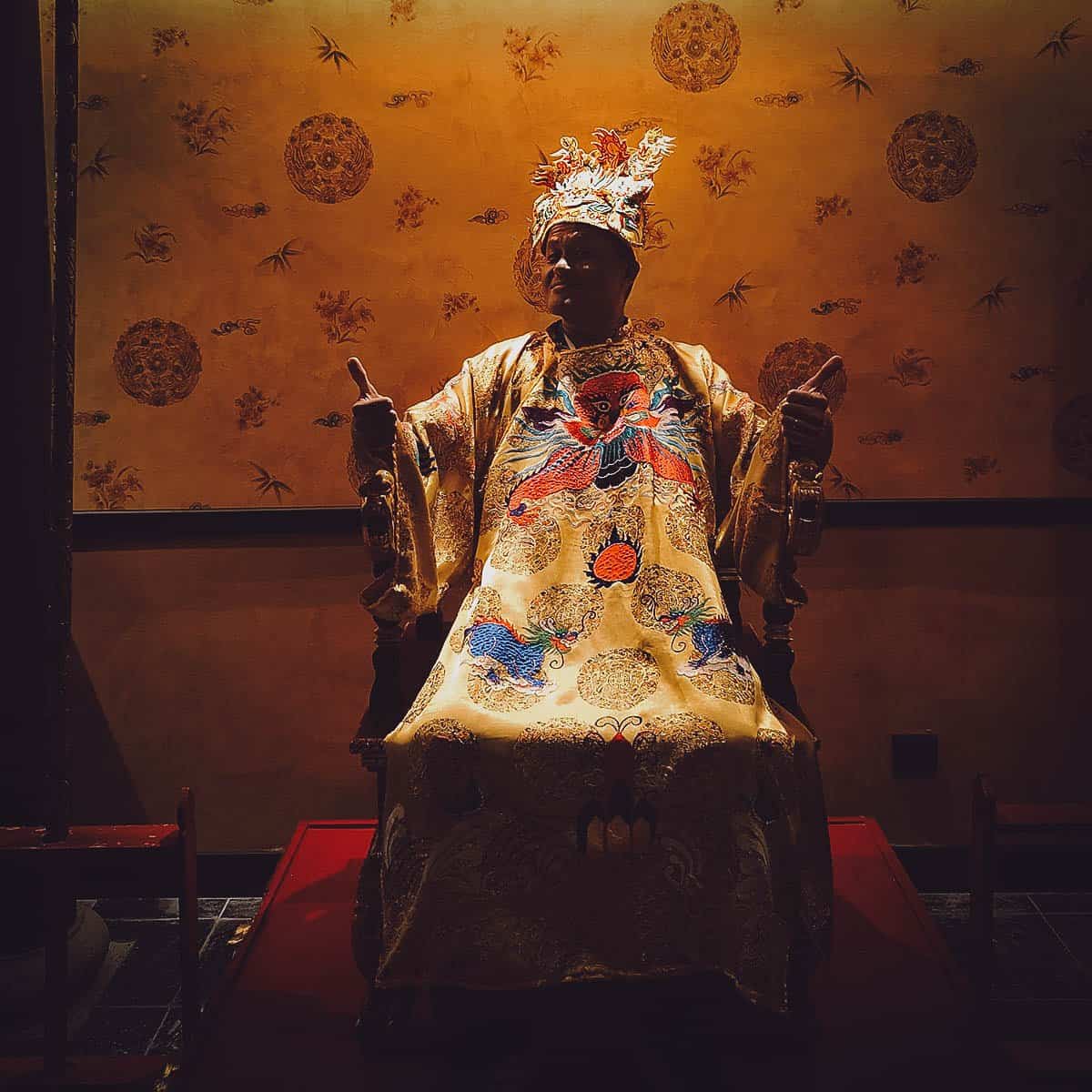
Ancient Hue Garden Houses
Address: 47 Kiệt 104 Kim Long, Kim Long, Thành phố Huế, Thừa Thiên Huế, Vietnam
Operating Hours: 7AM-10PM, daily
What to Order: Nam Phuong Empress menu
Expect to Pay: VND 1,179,000+
LOCATION MAP
To help you find these restauarants and street food stalls, I’ve pinned them all on this map.
FINAL THOUGHTS
Everything I heard about Hue was right. It really is home to some of the country’s best and most interesting food.
Hanoi’s bun cha may still be my single favorite Vietnamese dish, but bun bo isn’t far behind. Add to that the deliciousness of bun hen and nem lui, the uniqueness of bun hue, and the novelty of salty coffee, and you’ve got one of the most dynamic and diverse cuisines I’ve experienced so far in Vietnam.
Xem thêm: Top #5 Đặc Sản Gò Công – Du Khách Không Thể Bỏ Qua Khi Đến Đây
Together with Hanoi and Ho Chi Minh City, it’s definitely one of my favorite food cities in Vietnam and a place I’ll be looking to visit again and again. Ren wasn’t with me on this trip so we’re already talking about going back so she could try all the dishes featured on this list.
Can you guess which of these eateries I’ll be taking her first?
Disclosure
The TripAdvisor links in this article are affiliate links, meaning we’ll earn a small commission if you make a booking at no extra cost to you. We really appreciate your support as it helps us keep this website going. Thank you!
Found this article useful? Help us help other travelers by sharing it!


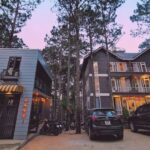
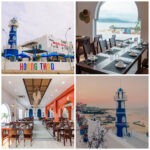


Bình luận